Forums
- Forums
- Axis And Allies Forum
- General Discussion
- Aviation News
Aviation News
Post a reply
- Go to Next topic
- Go to Welcome
- Go to Introduce Yourself
- Go to General Discussion
- Go to Screenshots, Images and Videos
- Go to Off topic
- Go to Works in Progress
- Go to Skinning Tips / Tutorials
- Go to Skin Requests
- Go to IJAAF Library
- Go to Luftwaffe Library
- Go to RAF Library
- Go to USAAF / USN Library
- Go to Misc Library
- Go to The Ops Room
- Go to Made in Germany
- Go to Campaigns and Missions
- Go to Works in Progress
- Go to Juri's Air-Raid Shelter
- Go to Campaigns and Missions
- Go to Works in Progress
- Go to Skinpacks
- Go to External Projects Discussion
- Go to Books & Resources
-
 Main AdminARABIAN GULF (March 15, 2018) An F/A-18F Super Hornet, assigned to the Fighting Redcocks of Strike Fighter Attack Squadron (VFA) 22, approaches the flight deck of the aircraft carrier USS Theodore Roosevelt (CVN 71). Theodore Roosevelt and its carrier strike group are deployed to the U.S. 5th Fleet area of operations in support of maritime security operations to reassure allies and partners and preserve the freedom of navigation and the free flow of commerce in the region. (U.S. Navy photo by Mass Communication Specialist Seaman Michael Hogan/Released)
Main AdminARABIAN GULF (March 15, 2018) An F/A-18F Super Hornet, assigned to the Fighting Redcocks of Strike Fighter Attack Squadron (VFA) 22, approaches the flight deck of the aircraft carrier USS Theodore Roosevelt (CVN 71). Theodore Roosevelt and its carrier strike group are deployed to the U.S. 5th Fleet area of operations in support of maritime security operations to reassure allies and partners and preserve the freedom of navigation and the free flow of commerce in the region. (U.S. Navy photo by Mass Communication Specialist Seaman Michael Hogan/Released)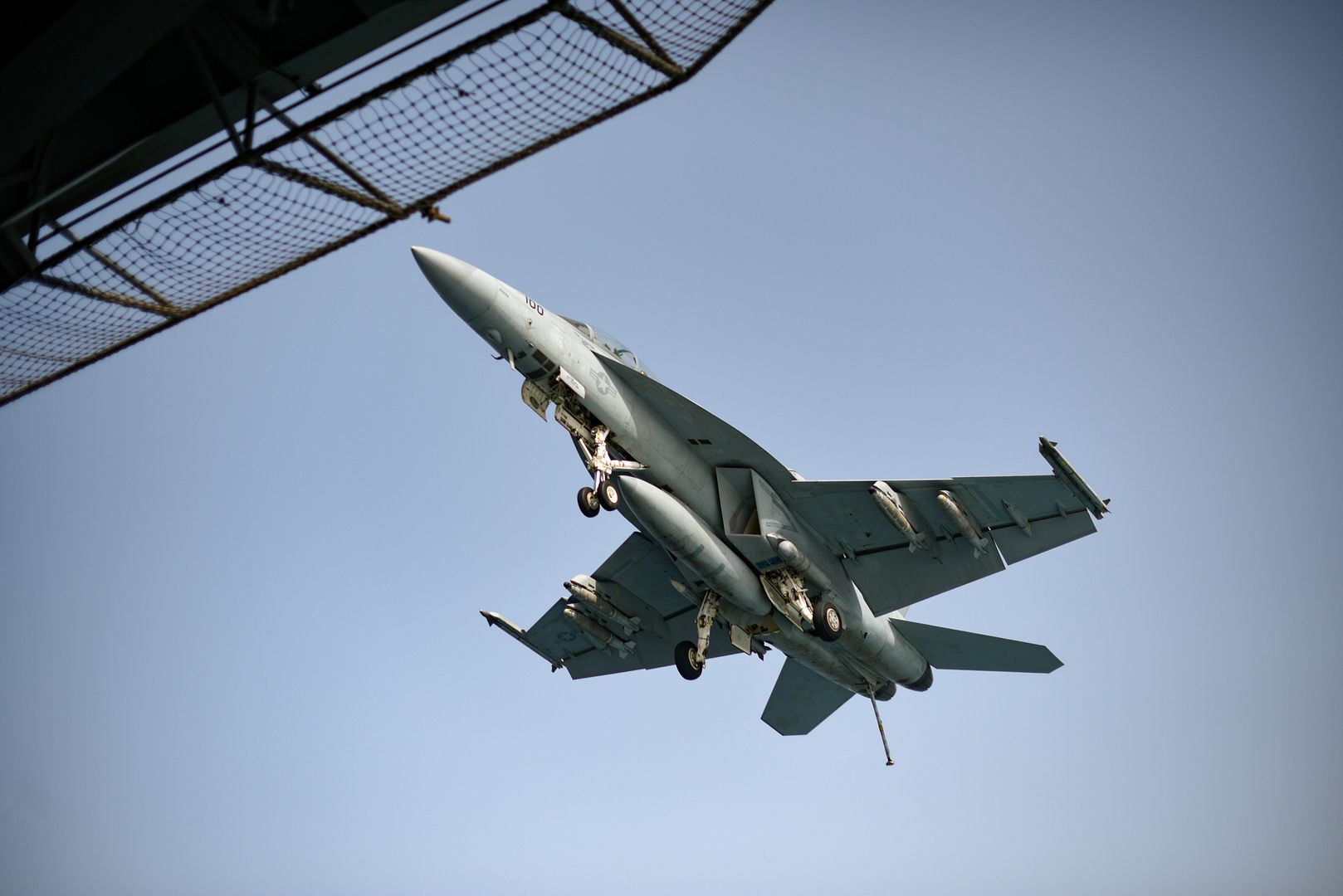
ARABIAN GULF (March 15, 2018) A C-2A Greyhound, assigned to the Providers of Fleet Logistics Support Squadron (VRC) 30, approaches the flight deck of the aircraft carrier USS Theodore Roosevelt (CVN 71). Theodore Roosevelt and its carrier strike group are deployed to the U.S. 5th Fleet area of operations in support of maritime security operations to reassure allies and partners and preserve the freedom of navigation and the free flow of commerce in the region. (U.S. Navy photo by Mass Communication Specialist Seaman Michael Hogan/Released)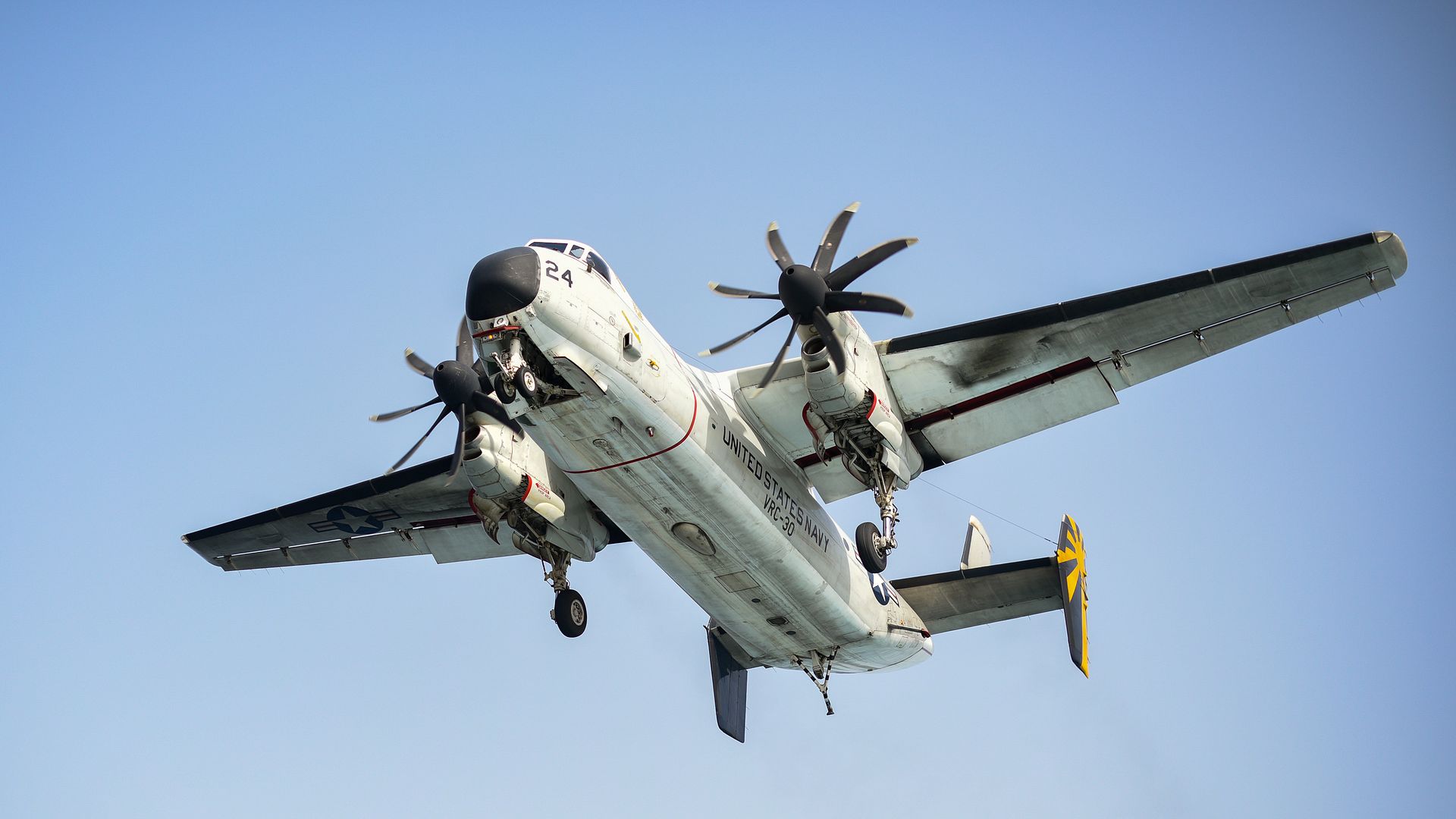
A Polish Air Force MiG-29 fighter accelerates and climbs during a formation flight with a U. S. Air Force C-130 Hercules from the 182nd Airlift Wing in northern Poland, March 15, 2018. Approximately 70 Airmen and three C-130s from the 182nd Airlift Wing are participating in bilateral training with the Polish Air Force during Aviation Rotation 18-2 in support of Operation Atlantic Resolve. These events occur across the U.S. European Command area of responsibility and are designed to enhance partner interoperability, maintain joint readiness, and assure our regional allies. (U.S. Air National Guard photo by Master Sgt. Todd A. Pendleton)
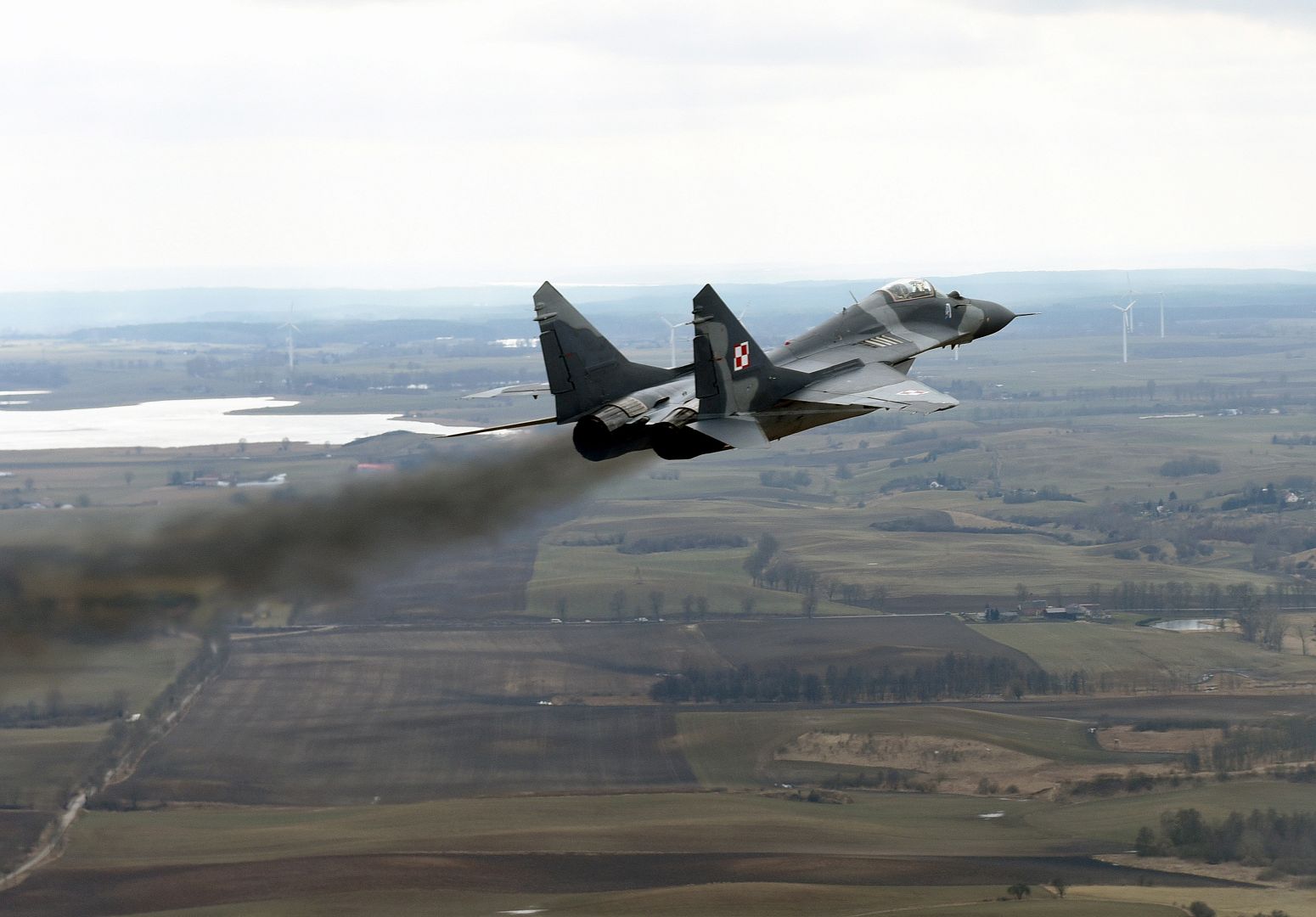
A B1-B bomber assigned to the 7th Bomb Wing, Dyess Air Force Base, Texas takes off from Nellis AFB, Nevada for a Red Flag 18-1 training mission on Feb. 15, 2018. The 414th Combat Training Squadron is responsible for executing Red Flag and this exercise is just one of a series of advanced training programs administered at Nellis and on the Nevada Test and Training Range. (U.S. Air Force photo by Lorenz Crespo)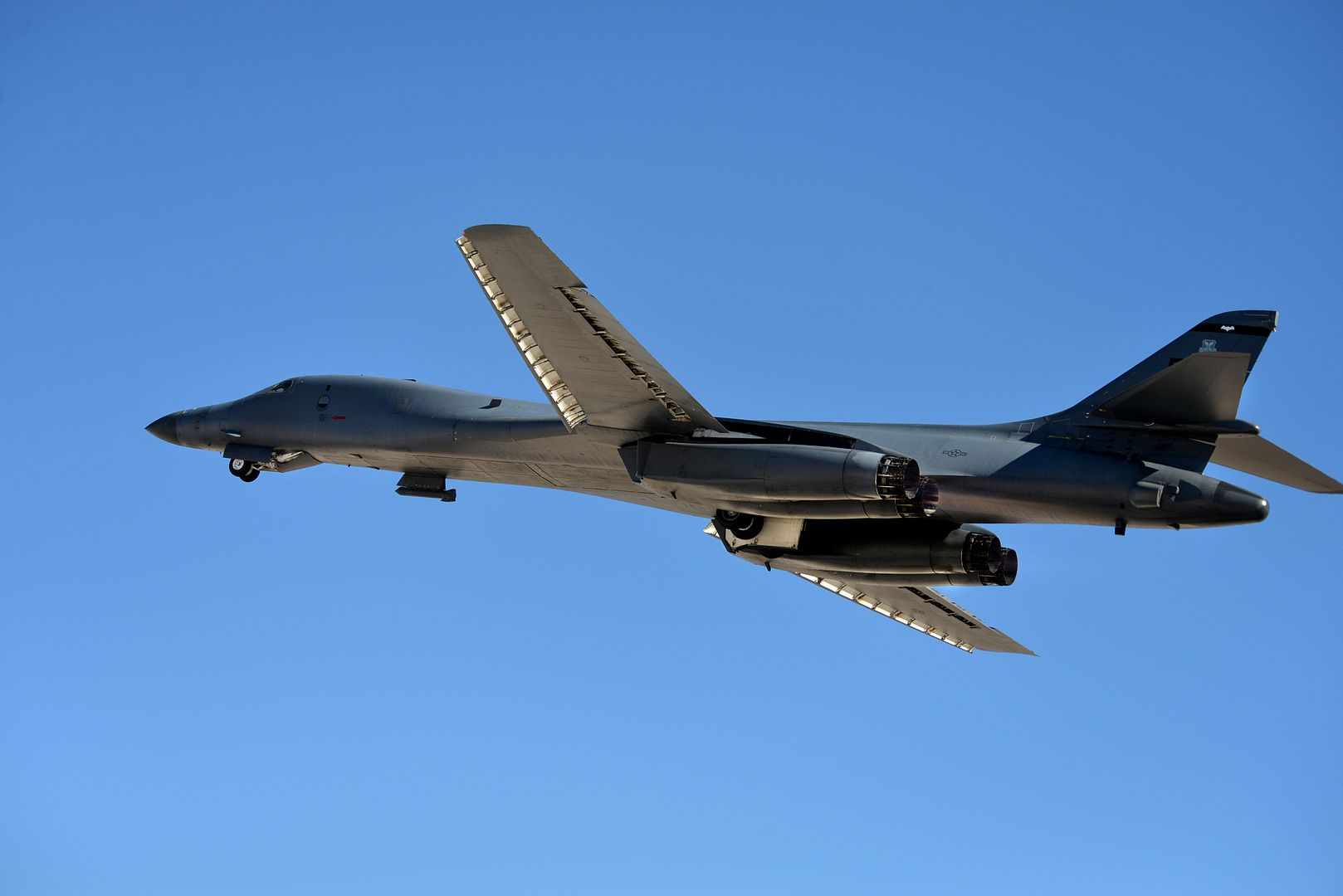
PACIFIC OCEAN (March 15, 2018) An MH-60S Sea Hawk helicopter assigned to the "Black Knights" of Helicopter Sea Combat Squadron (HSC) 4 flies near Nimitz-class aircraft carrier USS Carl Vinson (CVN 70). The Carl Vinson Carrier Strike Group is operating in the western Pacific as part of a regularly scheduled deployment. (U.S. Navy photo by Mass Communication Specialist 3rd Class Matthew Granito/Released)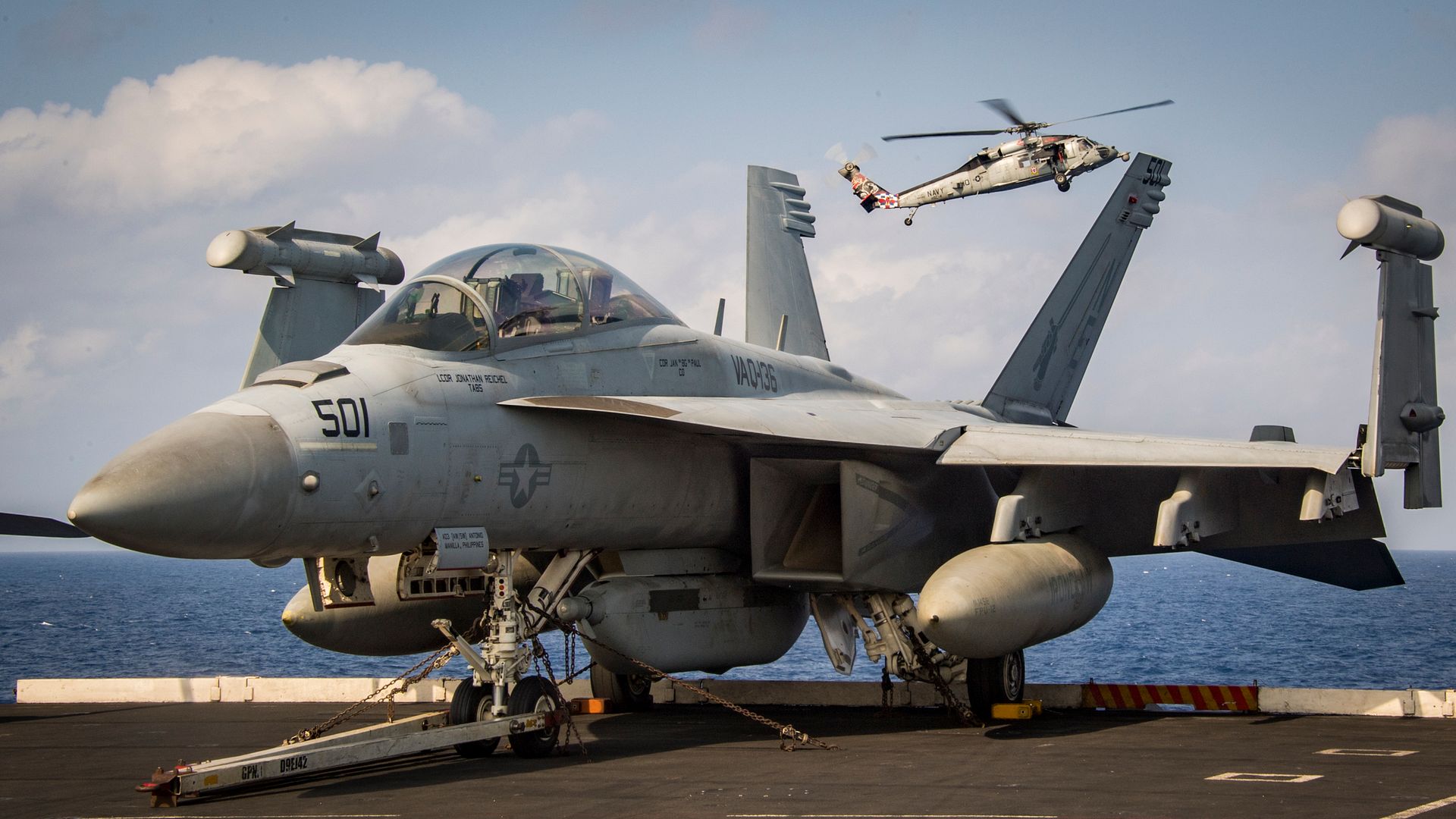
Doha, 14 March 2018 ? Qatar has signed a contract for the purchase of 28 NH90 military helicopters, during DIMDEX, Qatar?s biennial defence exhibition. The agreement, which includes 16 NH90s in tactical transport (TTH) configuration and 12 NH90s in naval (NFH) configuration, will support the country?s plan to modernise their military helicopter fleet. As part of the plan, Qatar will receive 16 H125 light single-engine helicopters in training configuration for operation by the Qatar Armed Forces Air Academy.
?We are honoured to support the Qatar Armed Forces through this strategic partnership?, said Ben Bridge, Executive Vice President Global Business at Airbus Helicopters. ?The NH90 is a modern and combat-proven asset that will meet Qatar?s demanding operational requirements for decades to come, both in troop transport and naval missions. Our partnership on the new training academy will also strengthen the relationship between our countries by enabling the exchange of expertise and know-how in helicopter operations?, he added.
Leonardo will act as prime contractor for the programme management with the end customer and Airbus will be responsible for the final assembly and delivery of 16 NH90 TTH aircraft from its facility in Marignane, France while Leonardo will be responsible for final assembly and delivery of the 12 NH90 NFH helicopters from its Venice ? Tessera facility in Northern Italy.
The NH90 is well suited for operations in the most demanding conditions and has been combat-proven in many theatres of operation worldwide. This contract for 28 helicopters brings the total order book to 543 aircraft. To date, 350 aircraft have been delivered to 20 customers in 13 countries and have accumulated around 170,000 flight hours.
The twin-engine, medium-size NH90 helicopter program is managed by the consortium NHIndustries, a company owned by Airbus Helicopters (62.5%), Leonardo (32%), and Fokker (5.5%).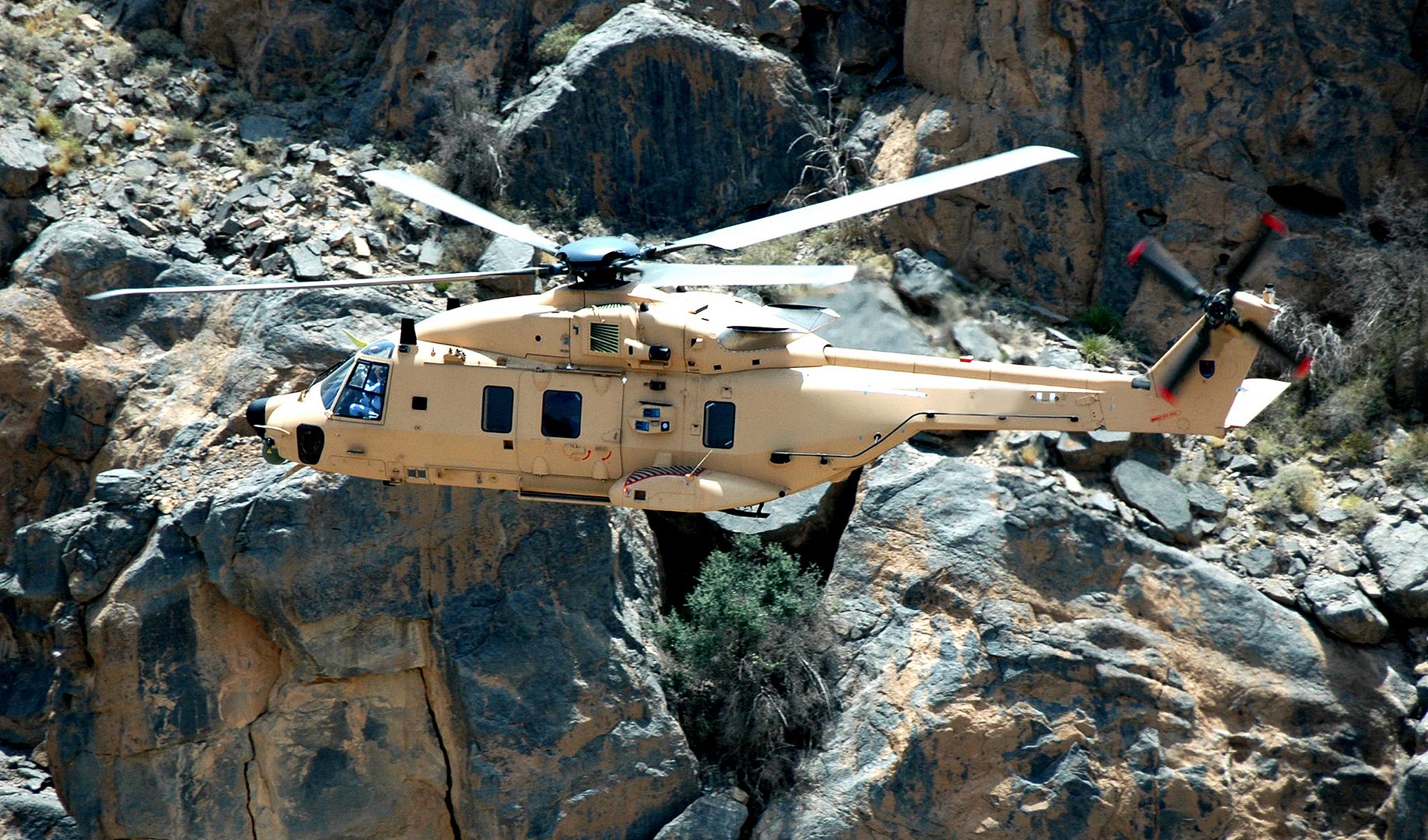
-
6 years agoMon Mar 19 2018, 10:15pm
 Main AdminSaturday, March 17, 2018. The F-5N Tiger II is a highly maneuverable, capable and reliable fighter used by the U.S. Navy and Marine Corps and more than 30 countries worldwide as a front line fighter, trainer, or reconnaissance aircraft. The airshow is MCAS Yuma's only military airshow of the year and provides the community an opportunity to see thrilling aerial and ground performers for free while interacting with Marines and sailors. (U.S. Marine Corps photo's by Sgt. Allison Lotz)
Main AdminSaturday, March 17, 2018. The F-5N Tiger II is a highly maneuverable, capable and reliable fighter used by the U.S. Navy and Marine Corps and more than 30 countries worldwide as a front line fighter, trainer, or reconnaissance aircraft. The airshow is MCAS Yuma's only military airshow of the year and provides the community an opportunity to see thrilling aerial and ground performers for free while interacting with Marines and sailors. (U.S. Marine Corps photo's by Sgt. Allison Lotz)
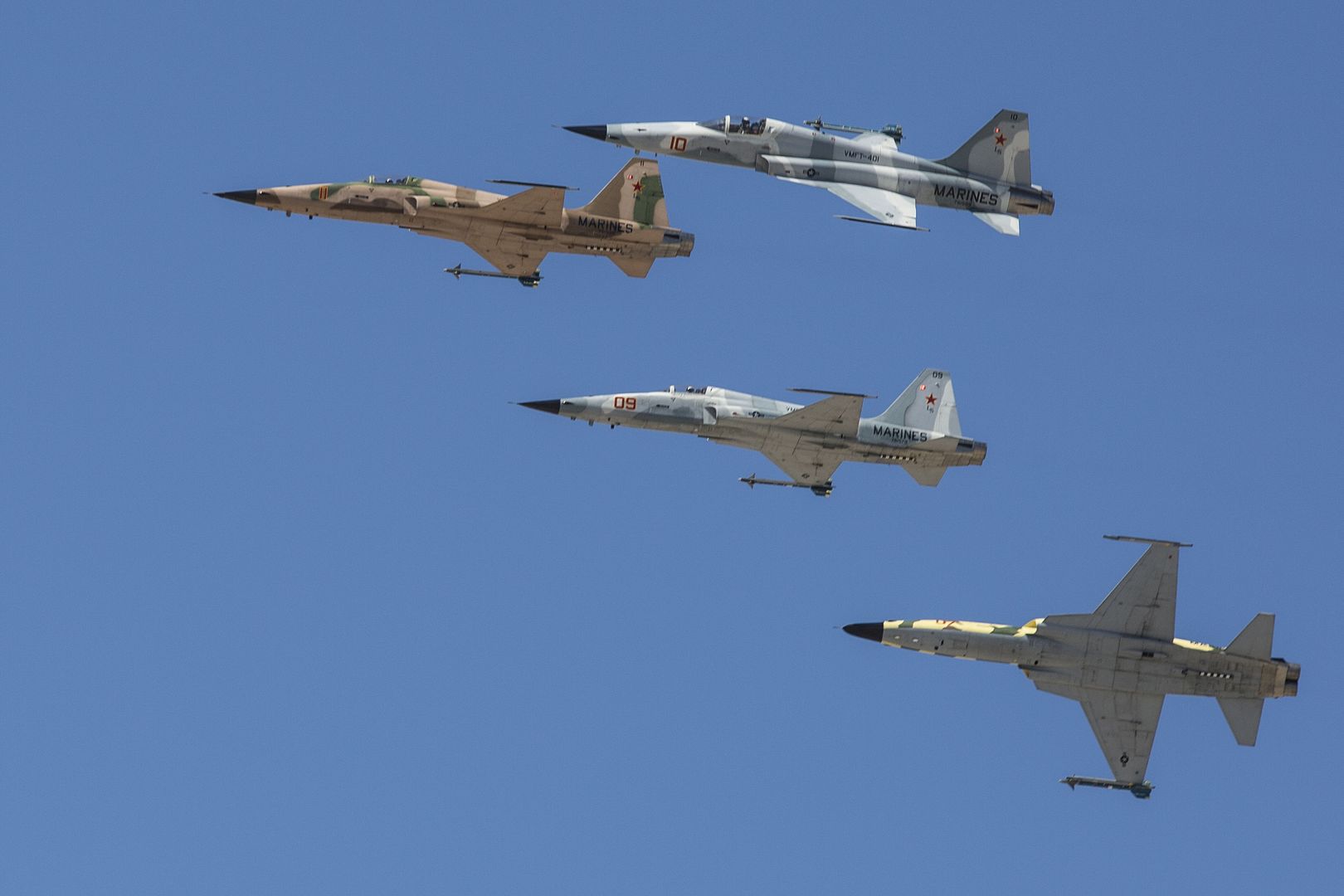
ARABIAN GULF (March 17, 2018) An EA-18G Growler, assigned to the Cougars of Electronic Attack Squadron (VAQ) 139, launches from the flight deck of the aircraft carrier USS Theodore Roosevelt (CVN 71). Theodore Roosevelt and its carrier strike group are deployed to the U.S. 5th Fleet area of operations in support of maritime security operations to reassure allies and partners and preserve the freedom of navigation and the free flow of commerce in the region. (U.S. Navy photo by Mass Communication Specialist 3rd Class Andrew Langholf/Released)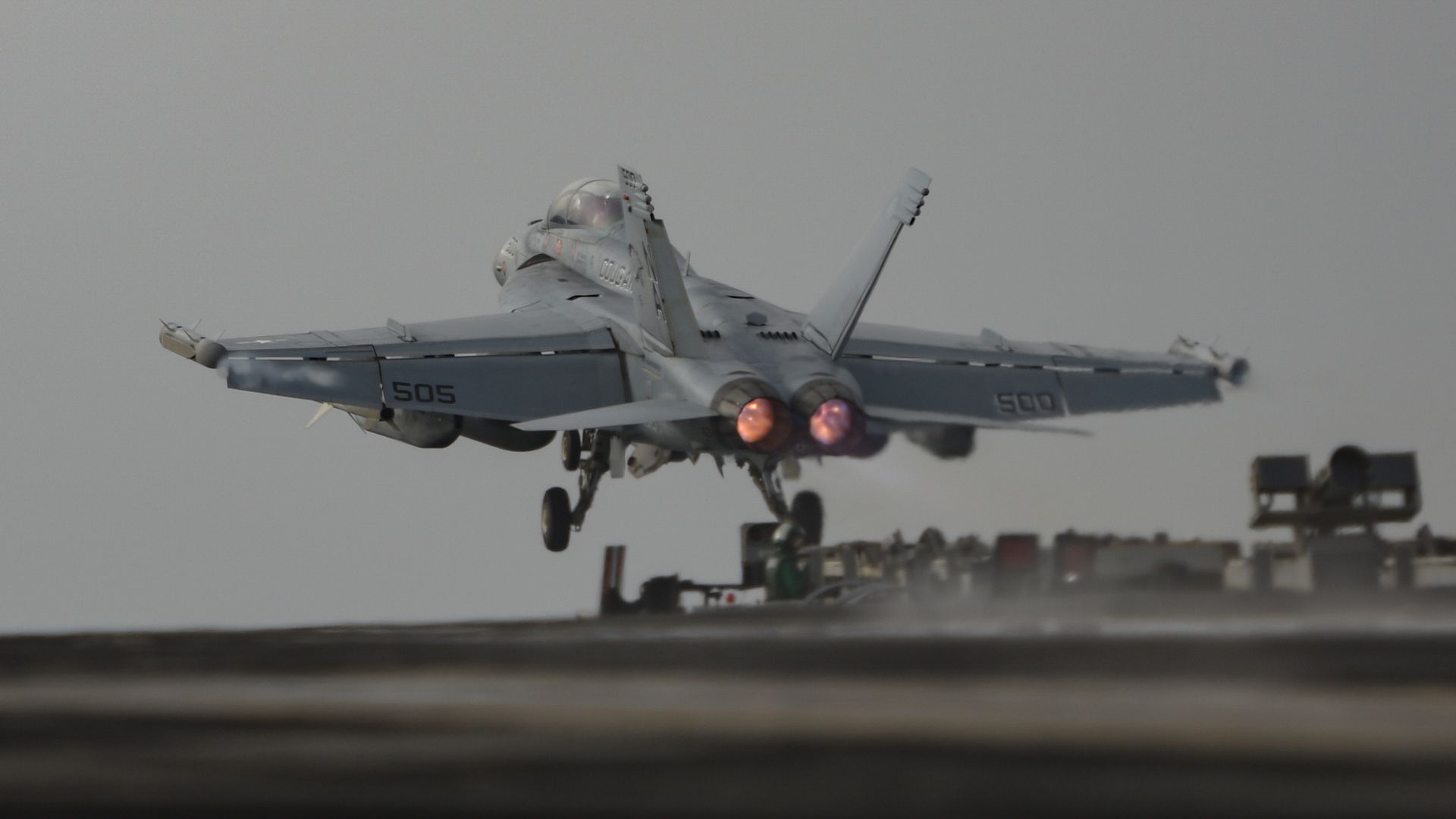
ARABIAN GULF (March 17, 2018) An F/A-18E Super Hornet, assigned to the Stingers of Strike Fighter Attack Squadron (VFA) 113, lands on the aircraft carrier USS Theodore Roosevelt (CVN 71). Theodore Roosevelt and its carrier strike group are deployed to the U.S. 5th Fleet area of operations in support of maritime security operations to reassure allies and partners and preserve the freedom of navigation and the free flow of commerce in the region. (U.S. Navy photo by Mass Communication Specialist Seaman Michael A. Colemanberry/Released)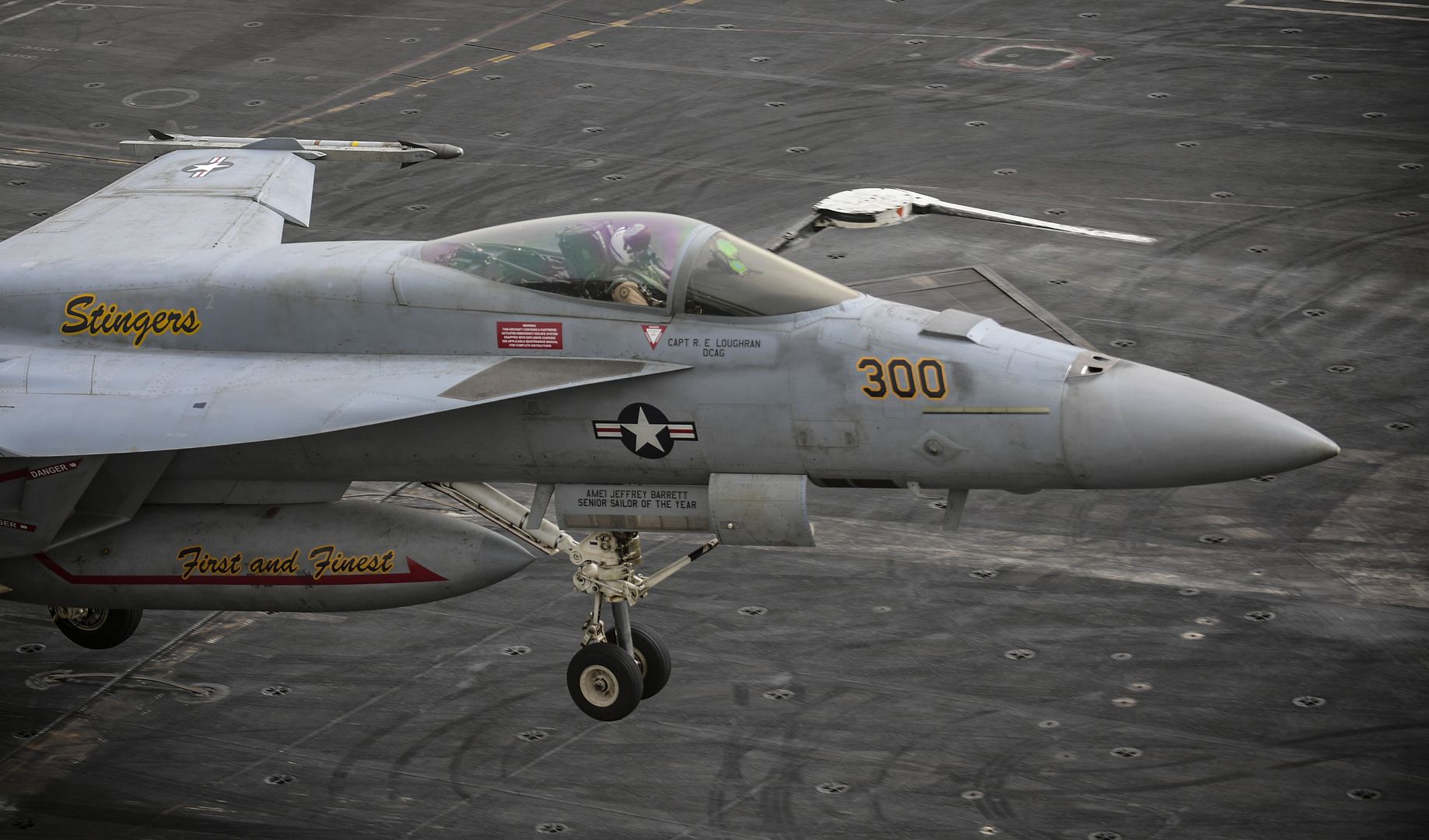
ARABIAN GULF (March 17, 2018) An F/A-18F Super Hornet, assigned to the Fighting Redcocks of Strike Fighter Attack Squadron (VFA) 22, lands on the flight deck of the aircraft carrier USS Theodore Roosevelt (CVN 71). Theodore Roosevelt and its carrier strike group are deployed to the U.S. 5th Fleet area of operations in support of maritime security operations to reassure allies and partners and preserve the freedom of navigation and the free flow of commerce in the region. (U.S. Navy photo by Mass Communication Specialist Seaman Michael A. Colemanberry/Released)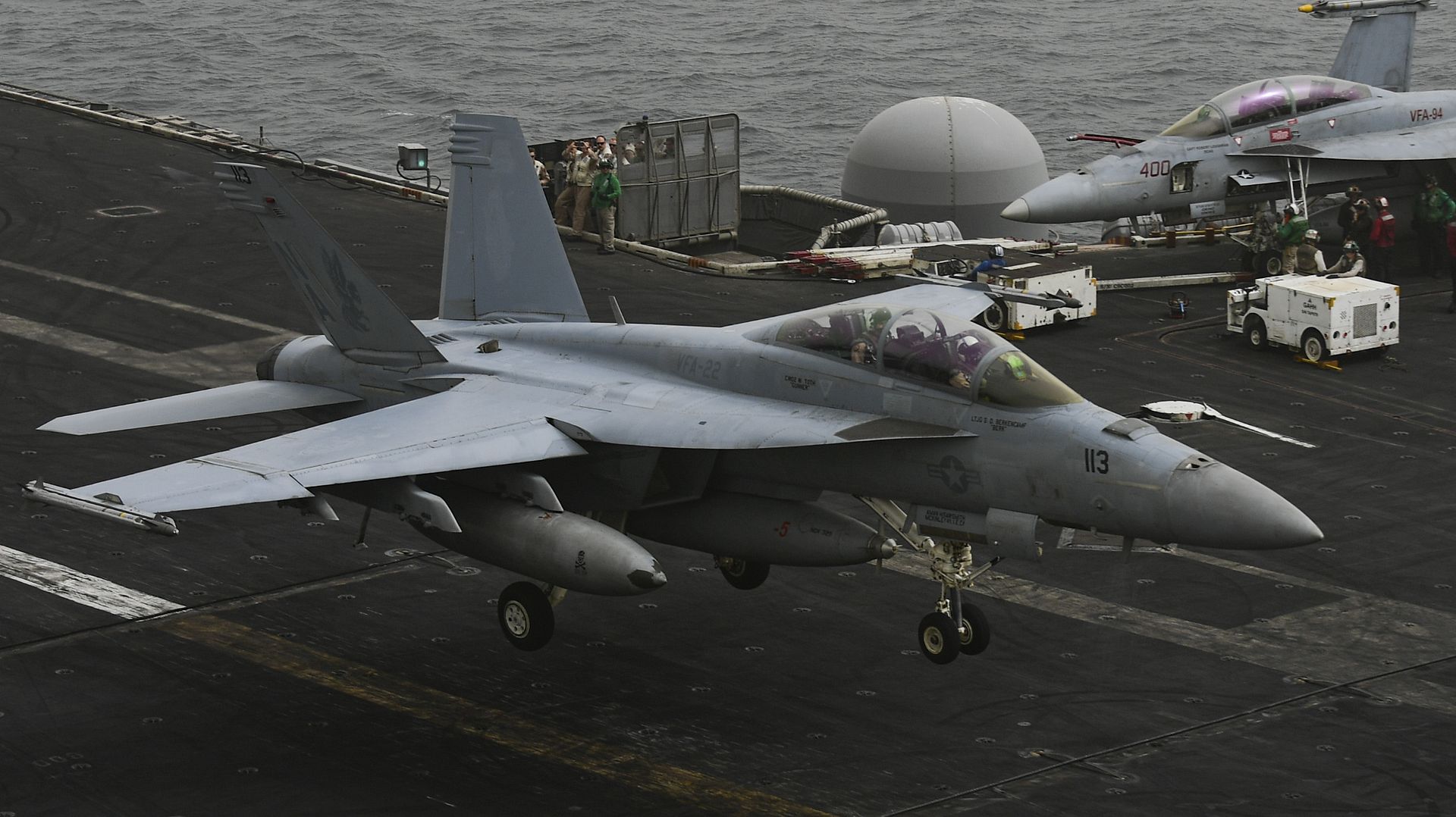
ARABIAN GULF (March 17, 2018) An EA-18G Growler, assigned to the Cougars of Electronic Attack Squadron (VAQ) 139, lands on the flight deck of the aircraft carrier USS Theodore Roosevelt (CVN 71). Theodore Roosevelt and its carrier strike group are deployed to the U.S. 5th Fleet area of operations in support of maritime security operations to reassure allies and partners and preserve the freedom of navigation and the free flow of commerce in the region. (U.S. Navy photo by Mass Communication Specialist Seaman Michael A. Colemanberry/Released)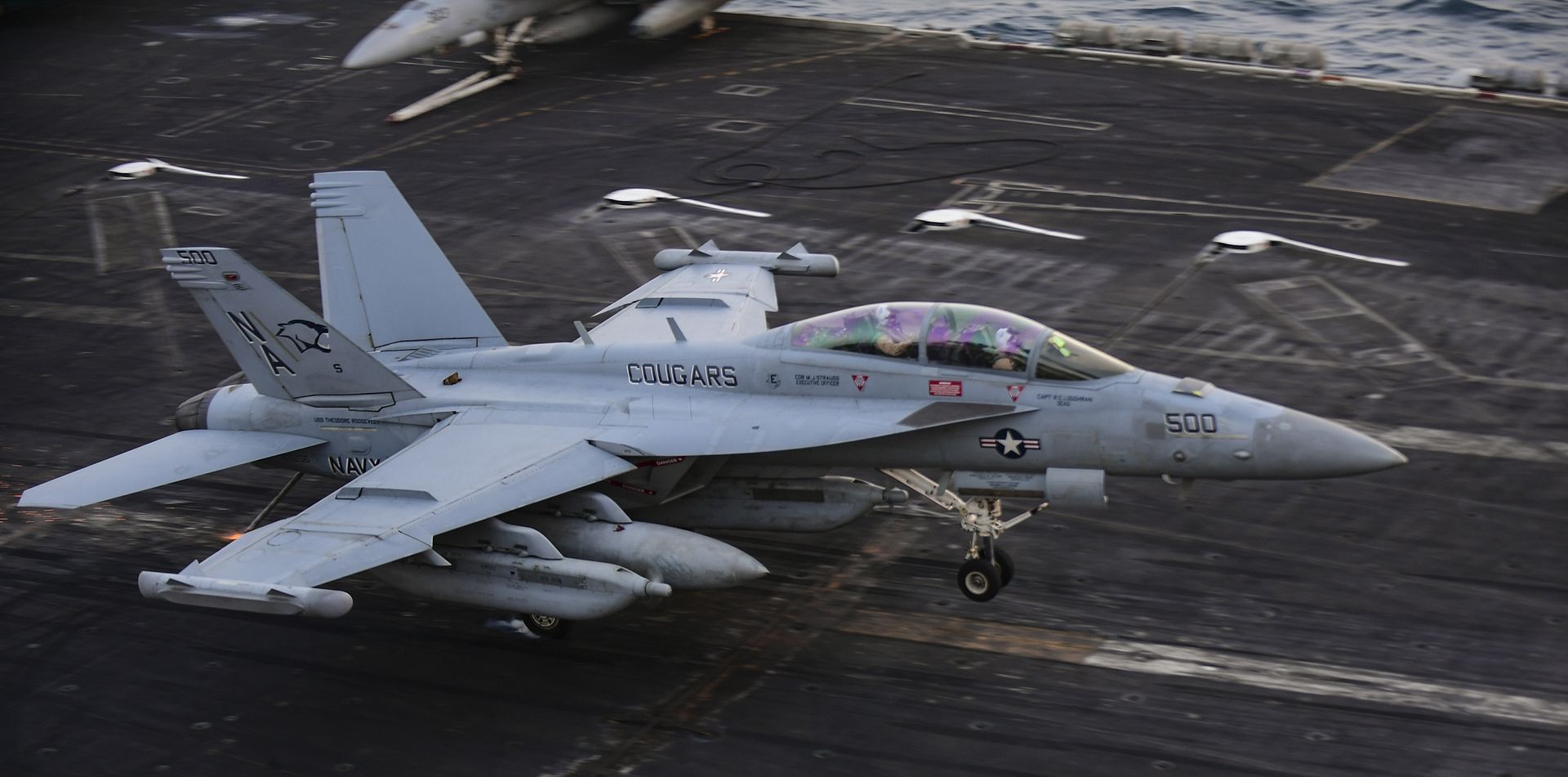
An A-10 Thunderbolt flies over during Luke Days at Luke Air Force Base, Ariz., March 17, 2018. Luke Days demonstrates the Air Force's continuing progress in building the future of airpower with military and civilian air acts including the U.S. Navy Blue Angels, F-35 and F-22 static displays, science, technology, engineering, and math exhibits, and military operations demonstrations. (U.S. Air Force photo by Staff Sgt. Tyler J. Bolken)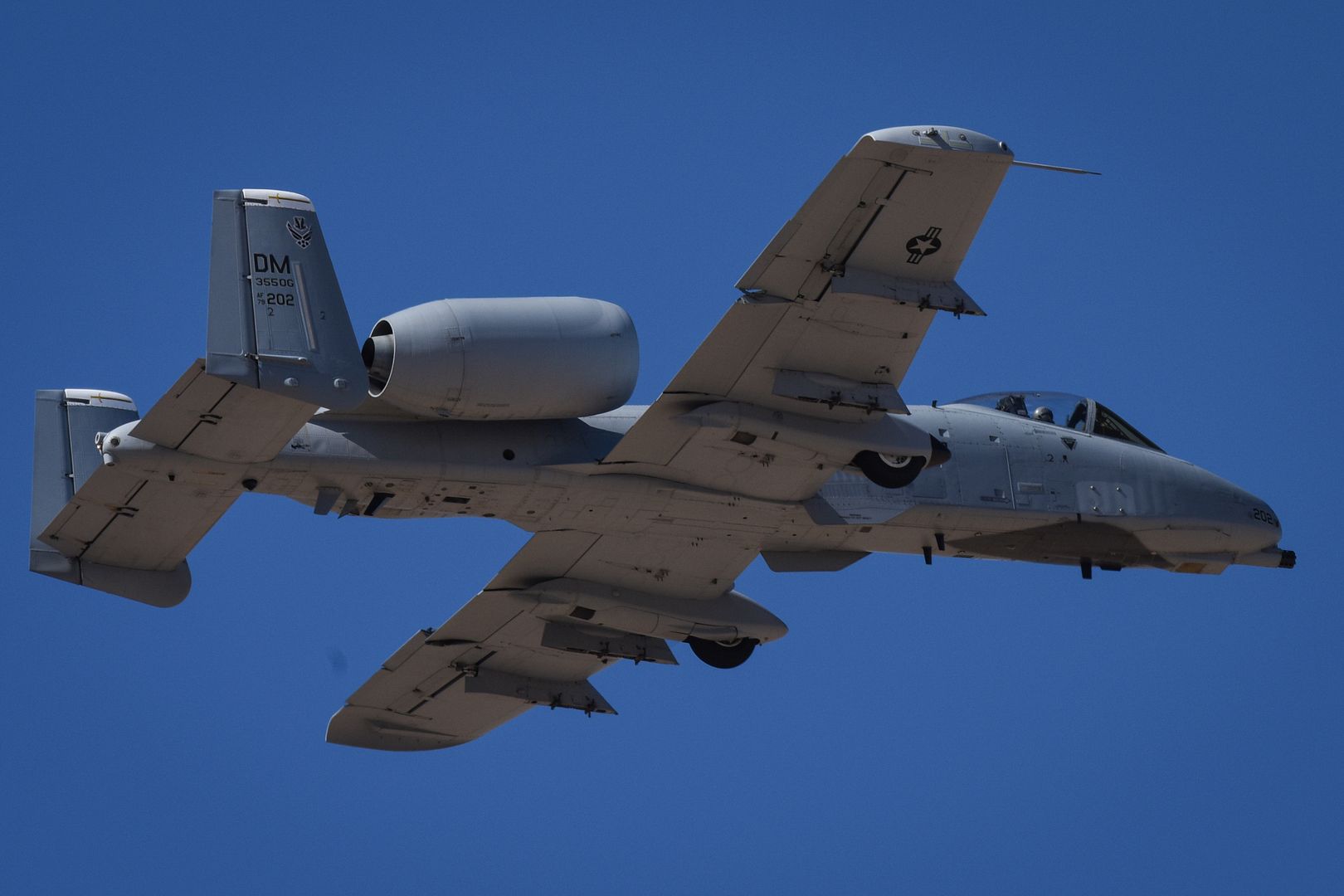
Tora Tora Tora warbird performers fly over the crowd during Luke Days at Luke Air Force Base, Ariz., March 17, 2018. Tora, Tora, Tora began in 1972, when 6 replica Japanese aircraft used in the movie of the same name were donated to the Commemorative Air Force. Luke Days demonstrates the Air Force's continuing progress in building the future of airpower with military and civilian air acts including the U.S. Navy Blue Angels, F-35 and F-22 static displays, science, technology, engineering, and math exhibits, and military operations demonstrations. (U.S. Air Force photo by Staff Sgt. Tyler J. Bolken)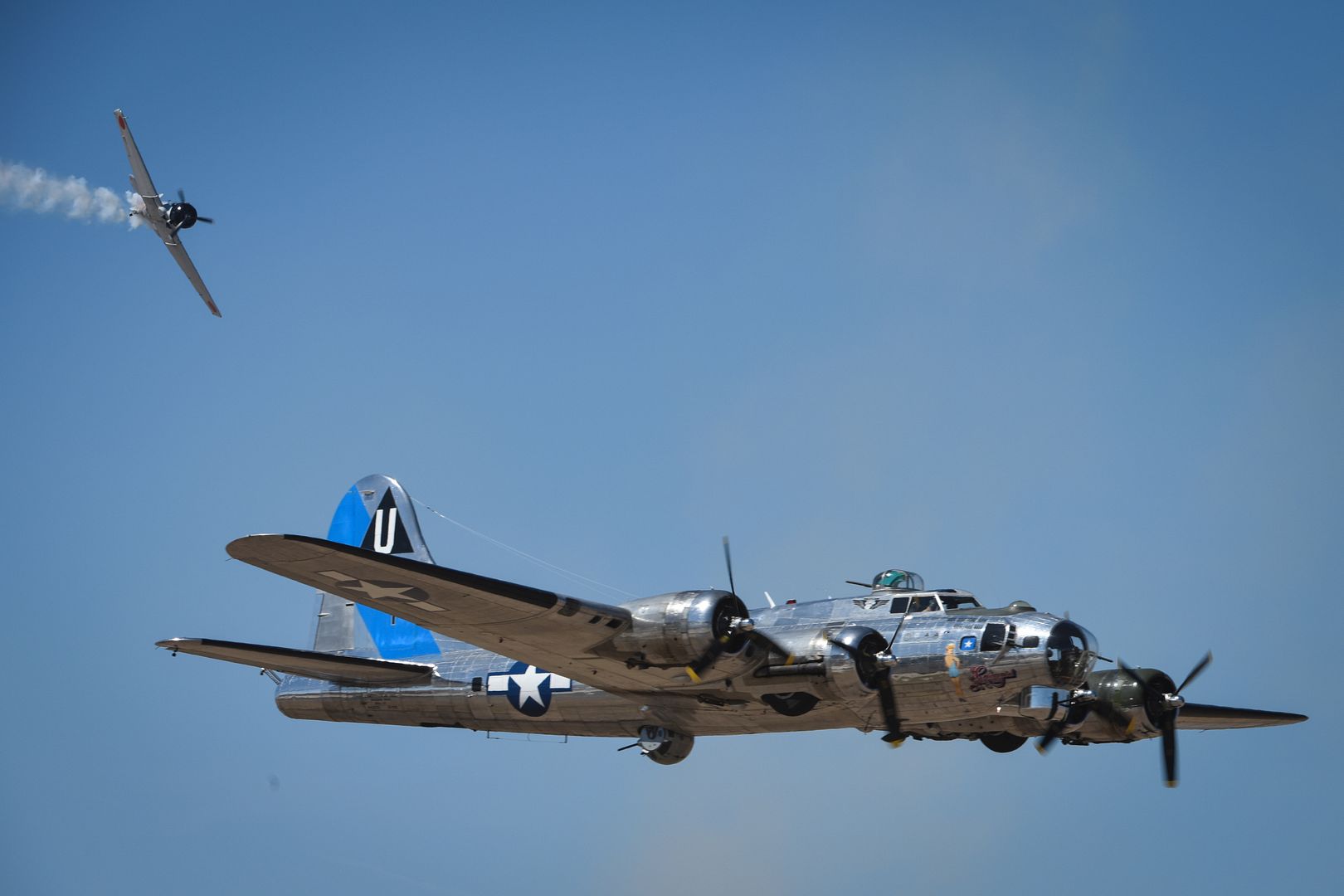
A U.S. Air Force F-16C Fighting Falcon pilot flies in formation while his wingman conducts refueling operations with a KC-135 Stratotanker, assigned to the 340th Expeditionary Air Refueling Squadron Detatchment 1, over Afghanistan in support of Operation Freedom's Sentinel, March 11, 2018. The F-16's capabilities include air superiority, fighter escort, reconnaissance, aerial refueling, close air support, air defense suppression and precision strikes. (U.S. Air Force Photo's by Tech. Sgt. Gregory Brook)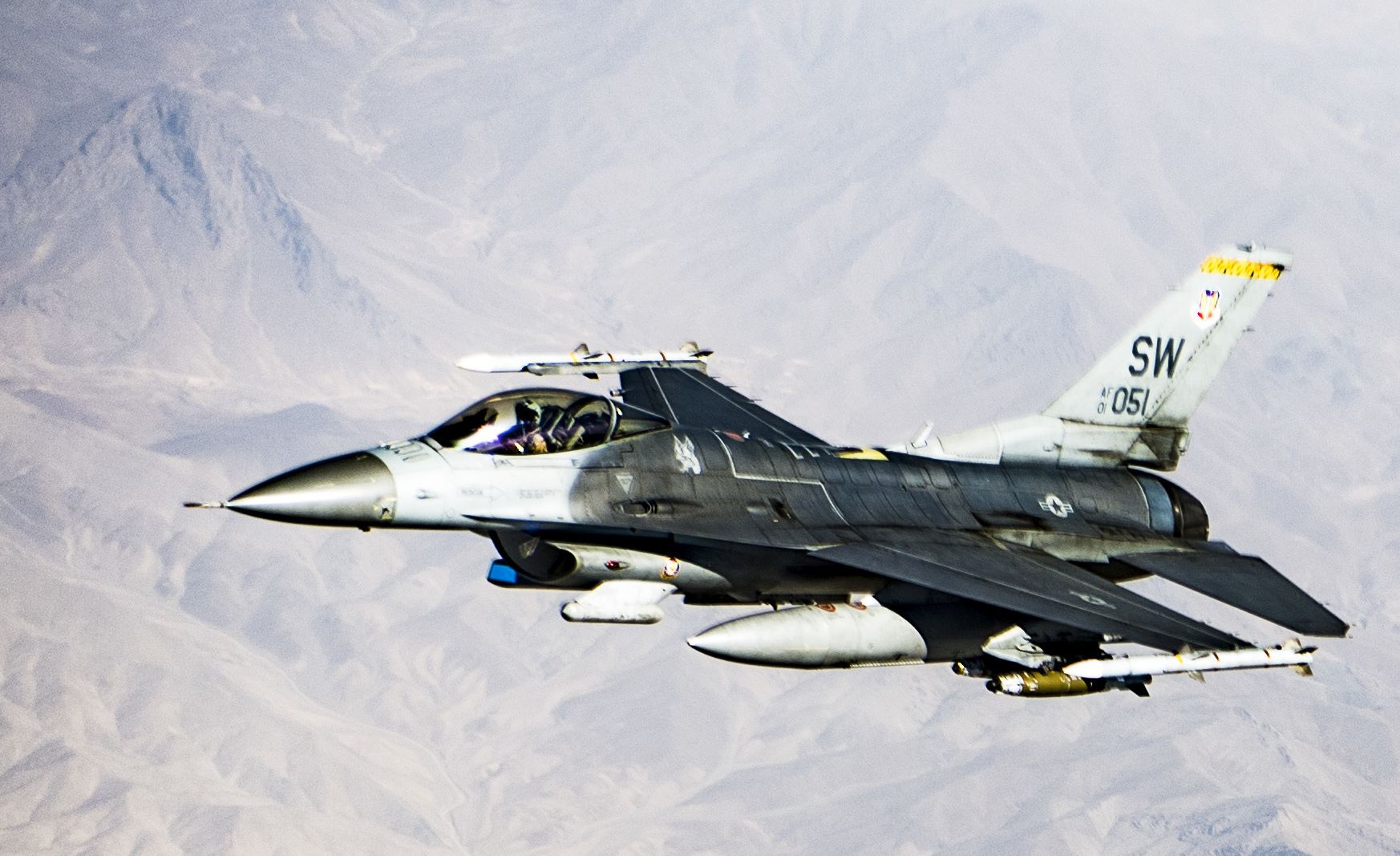
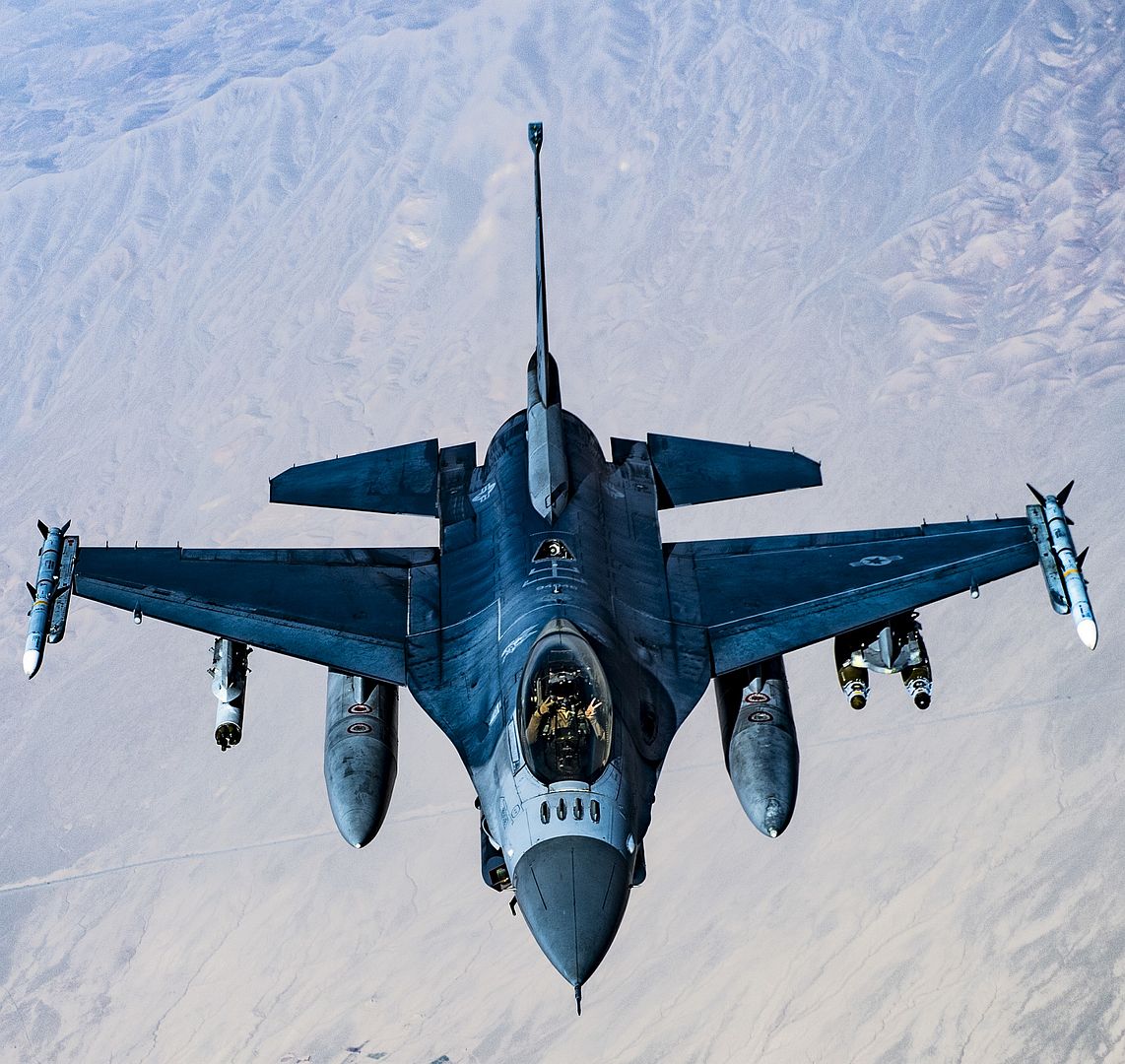
A U.S. Air Force F-16C Fighting Falcon breaks off and flies back toward its patrol area after concluding refueling operations with a KC-135 Stratotanker, assigned to the 340th Expeditionary Air Refueling Squadron Detatchment 1, over Afghanistan in support of Operation Freedom's Sentinel, March 11, 2018. The F-16's capabilities include air superiority, fighter escort, reconnaissance, aerial refueling, close air support, air defense suppression and precision strikes. (U.S. Air Force Photo by Tech. Sgt. Gregory Brook)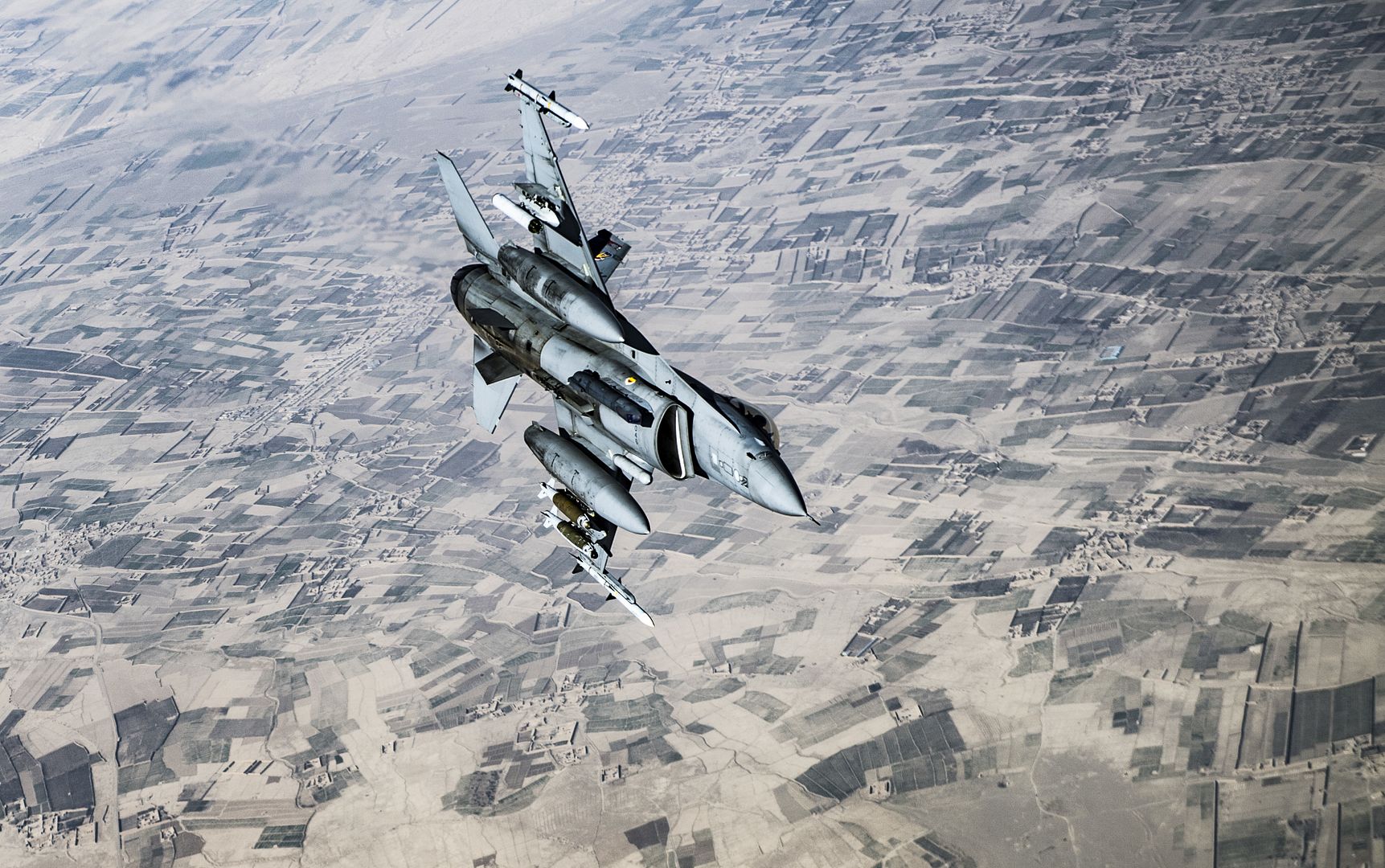
A U.S. Air Force A-10 Thunderbolt II pilot breaks right and releases flares over Afghanistan after completing aerial refueling operations with a KC-135 Stratotanker, assigned to the 340th Expeditionary Air Refueling Squadron Detatchment 1, in support of Operation Freedom's Sentinel, March 12, 2018. The A-10 is primarily deployed to provide close air support to U.S. and coalition forces operating as part of NATO?s Resolute Support mission. (U.S. Air Force Photo by Tech. Sgt. Gregory Brook)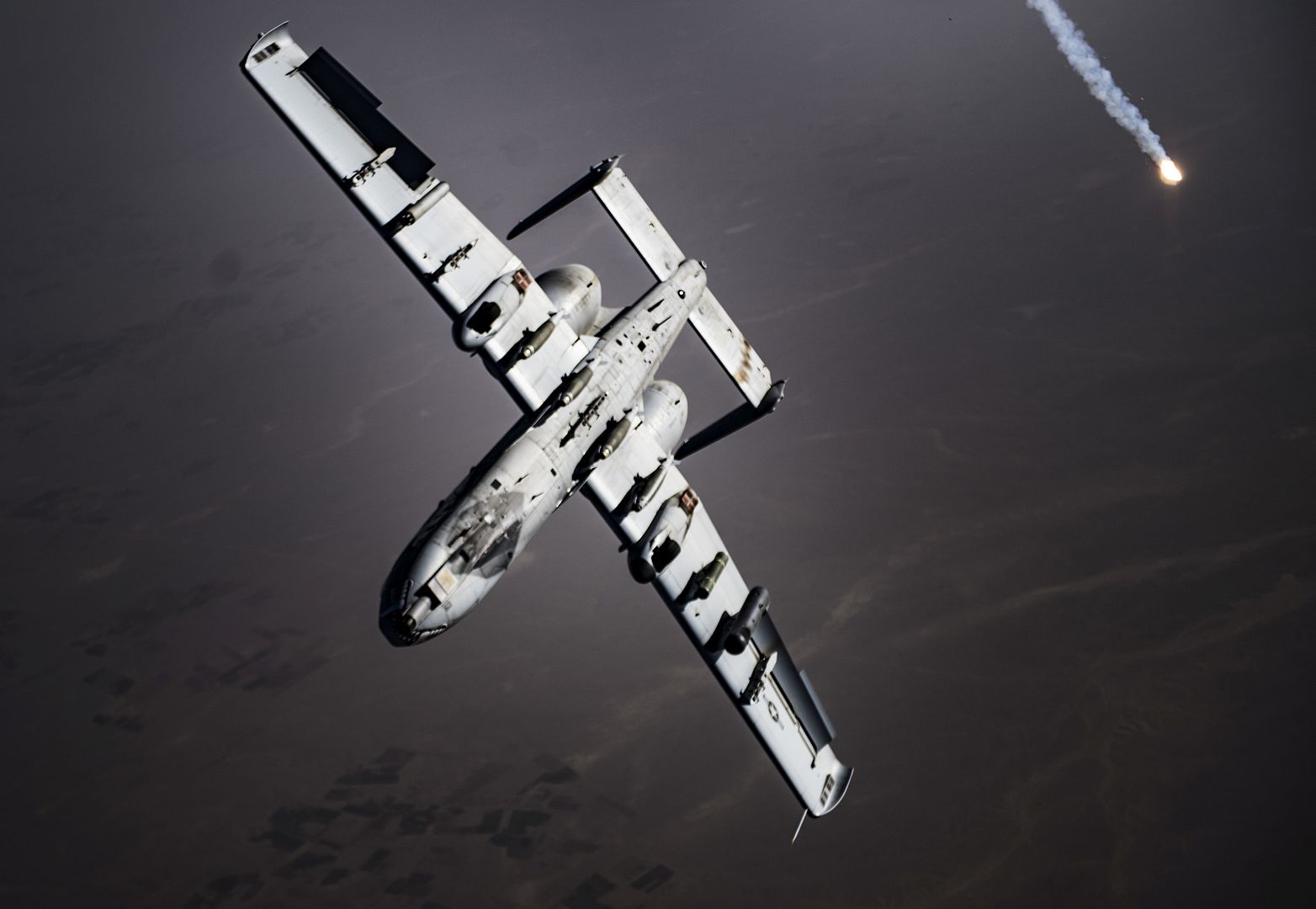
A U.S. Navy F/A-18F Super Hornet departs after receiving fuel from a KC-135 Stratotanker assigned to the 340th Expeditionary Air Refueling Squadron during a refueling mission on above Iraq March 9, 2018. The F/A-18E and F model are twin-engine carrier capable multirole fighter aircraft variants with the E model being a single-seat and the F model designated as a tandem seat. (U.S. Air Force Photo by Tech. Sgt. Paul Labbe)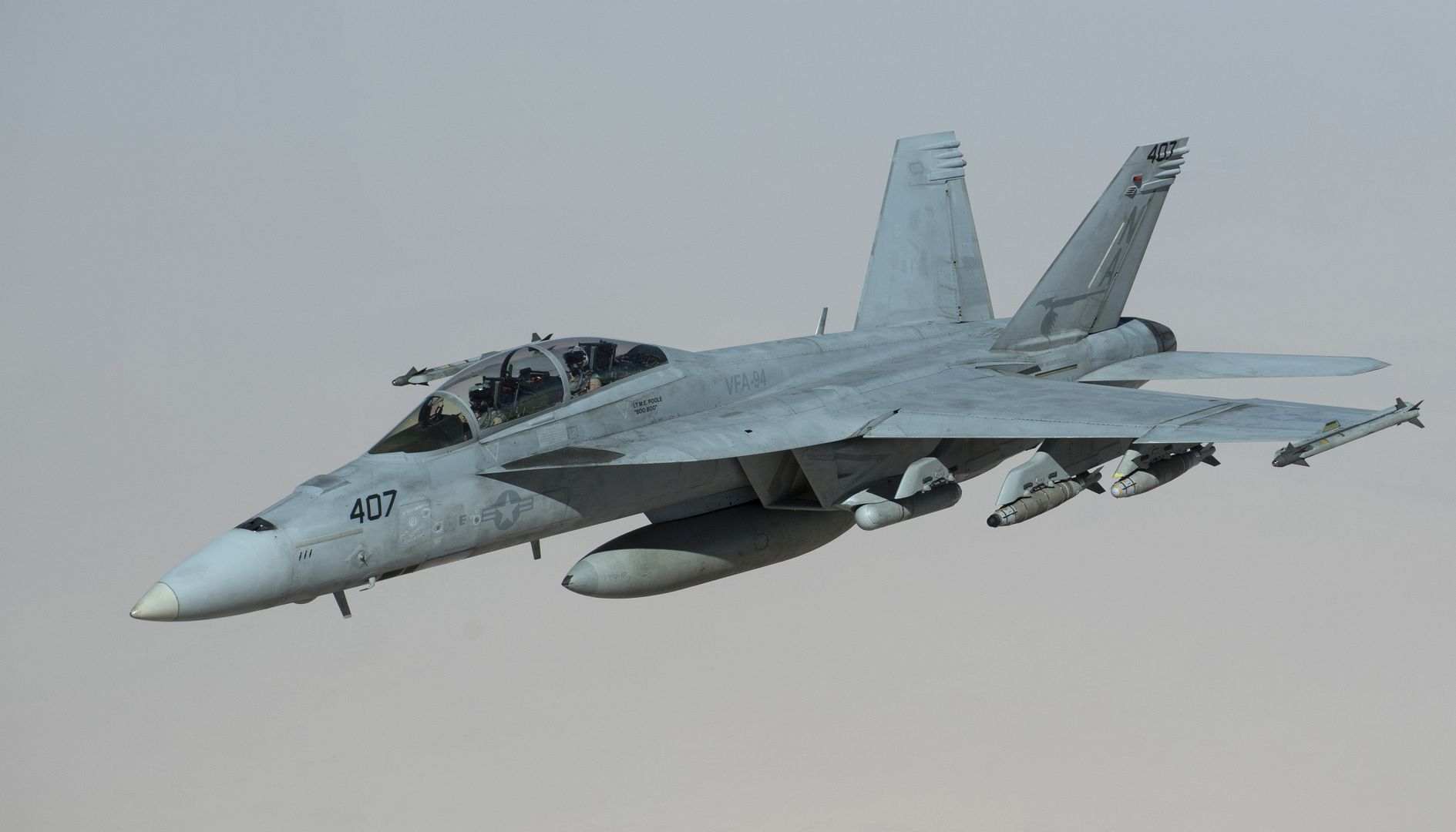
ATLANTIC OCEAN (March 17, 2018) Finnish Air Force Capt. Juha Jarvinen lands an F/A-18C Hornet assigned to the Sharpshooters of Marine Strike Fighter Training Squadron (VMFAT) 101 on the flight deck of the Nimitz-class aircraft carrier USS Abraham Lincoln (CVN 72). This marks the first time a Finnish pilot has performed an arrested landing aboard an aircraft carrier. (U.S. Navy photo's by Mass Communication Specialist 1st Class Brian M. Wilbur/Released)

ATLANTIC OCEAN (March 17, 2018) U.S. Marine Corps. Capt. Michael Humiston congratulates Finnish Air Force Capt. Juha Jarvinen upon completion of an arrested landing of an F/A-18C Hornet assigned to the Sharpshooters of Marine Strike Fighter Training Squadron (VMFAT) 101 on the flight deck of the Nimitz-class aircraft carrier USS Abraham Lincoln (CVN 72). This marks the first time a Finish pilot has performed and arrested gear landing aboard an aircraft carrier. (U.S. Navy photo by Mass Communication Specialist 1st Class Brian M. Wilbur/Released)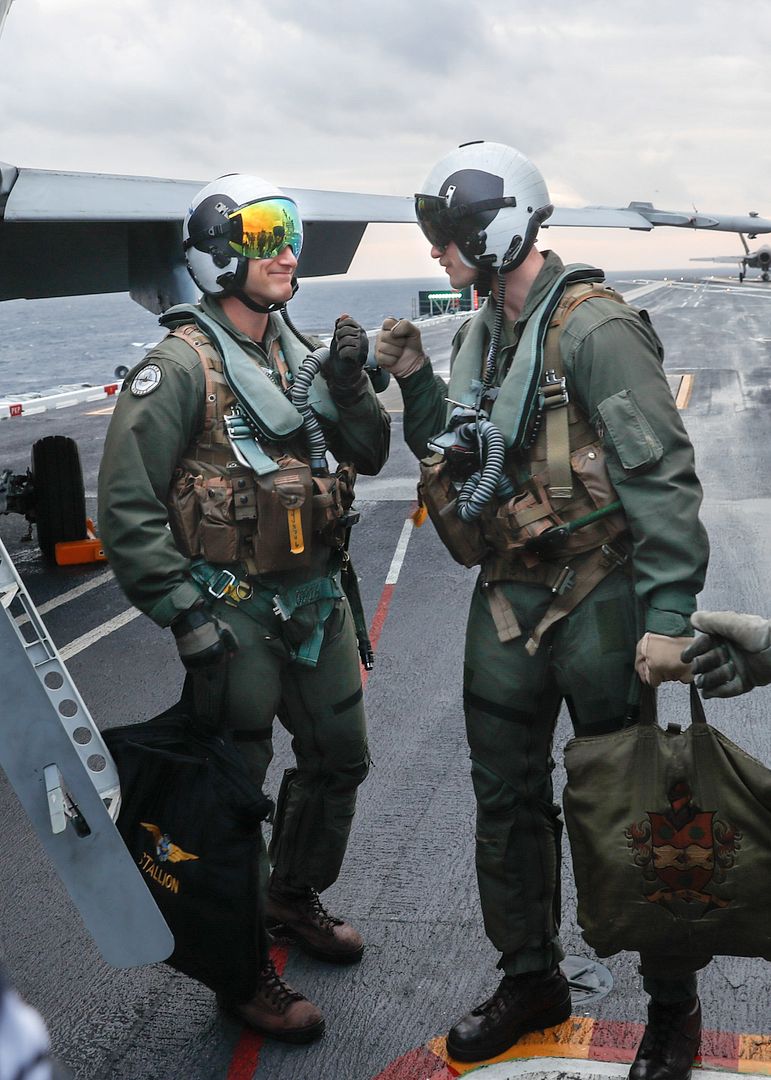
ATLANTIC OCEAN (March 17, 2017) An F-35C Lightning II from the Grim Reapers of Strike Fighter Squadron (VFA) 101 launches from the flight deck of the Nimitz-class aircraft carrier USS Abraham Lincoln (CVN 72). Abraham Lincoln is underway conducting carrier qualifications. (U.S. Navy photo by Mass Communication Specialist 1st Class Josue Escobosa/Released)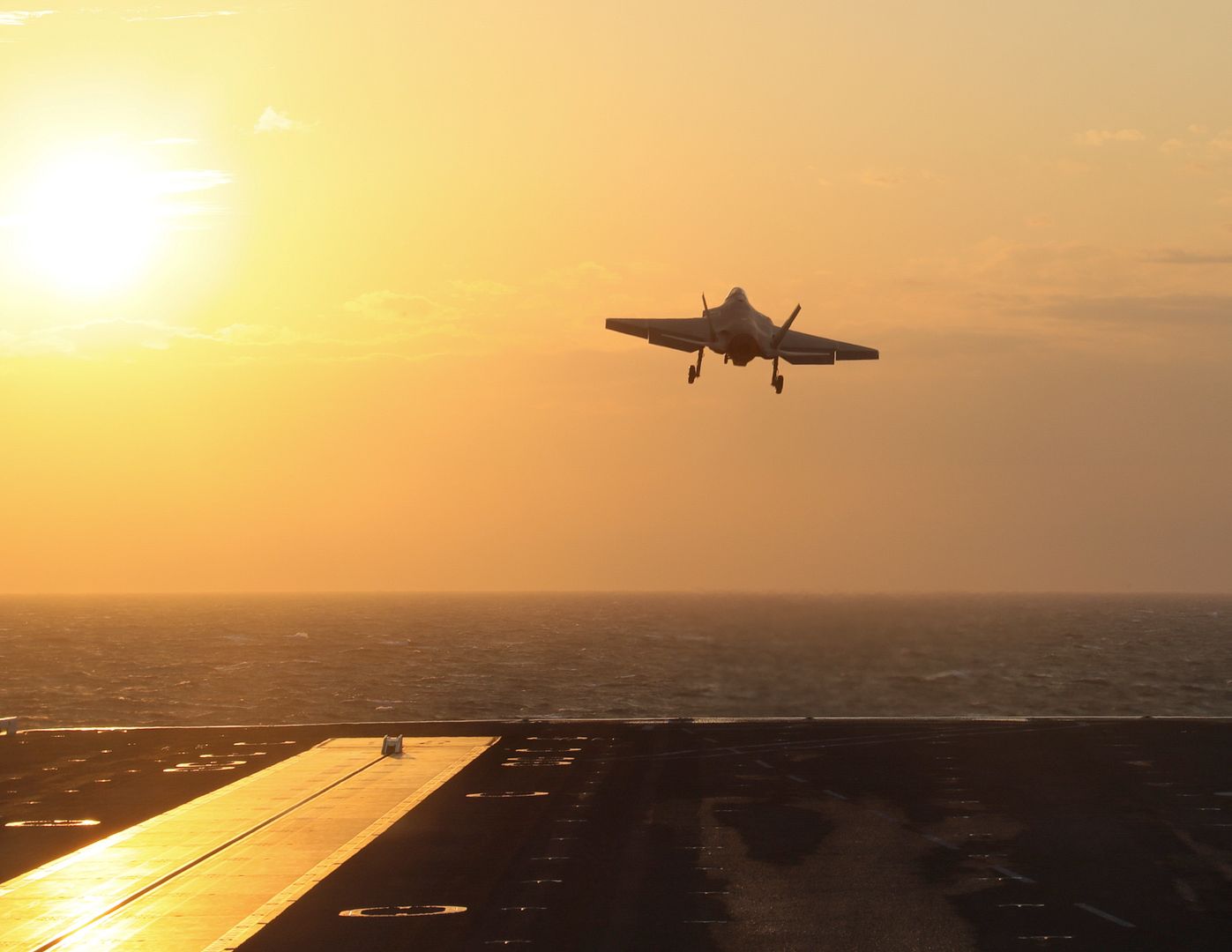
ATLANTIC OCEAN (March 18, 2018) An F-35C Lightning II assigned to the Rough Raiders of Strike Fighter Attack Squadron (VFA) 125 performs a touch and go on the flight deck of the Nimitz-class aircraft carrier USS Abraham Lincoln (CVN 72). (U.S. Navy photo by Chief Mass Communication Specialist Mark Logico/Released)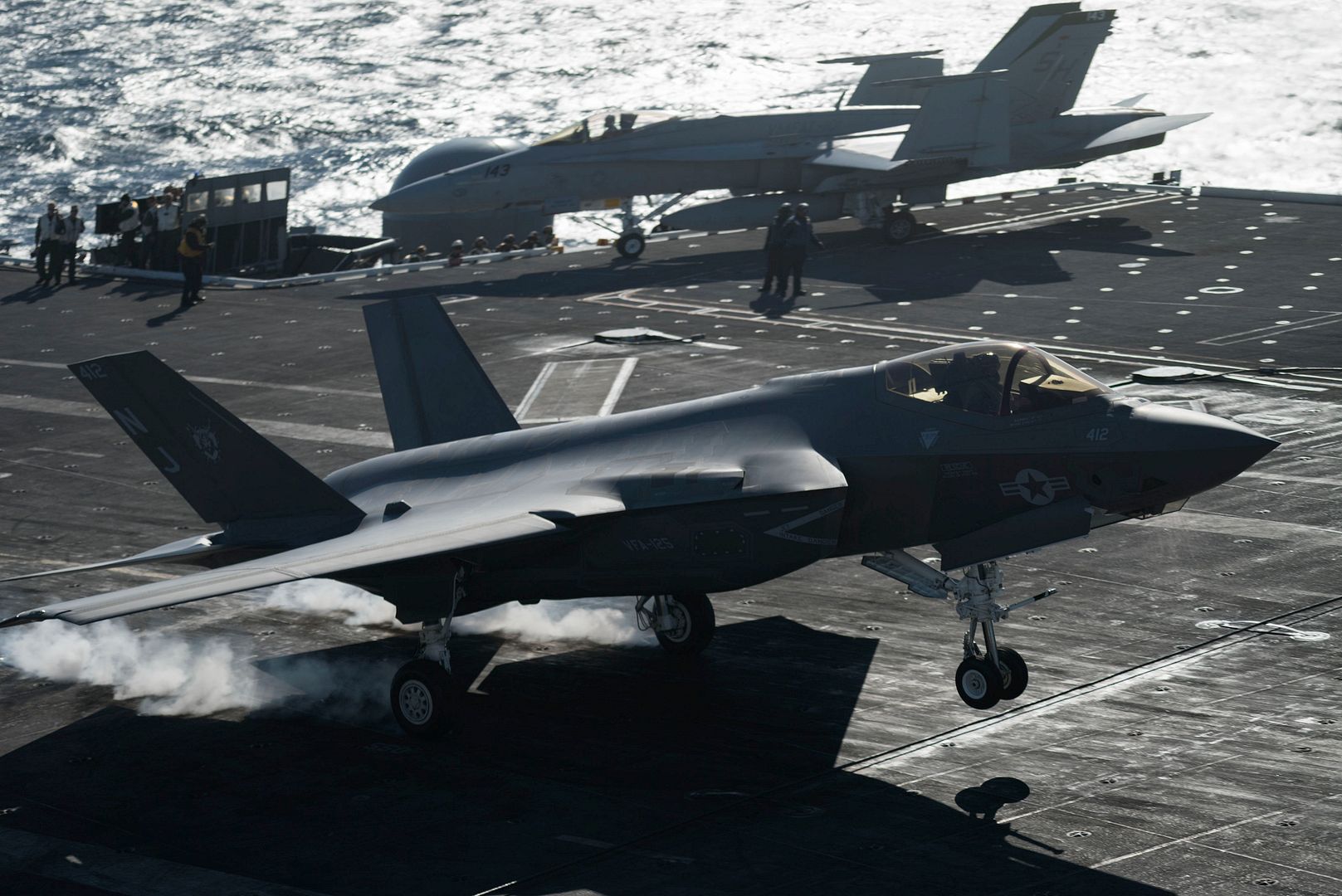
SEATTLE, March 16, 2018 /PRNewswire/ -- Boeing's [NYSE: BA] new 737 MAX 7 successfully completed its first flight today. The airplane remains on schedule and now begins a comprehensive flight test program leading to certification and delivery in 2019.
The 737 MAX 7 completed a successful first flight today. The airplane is seen here during its flight.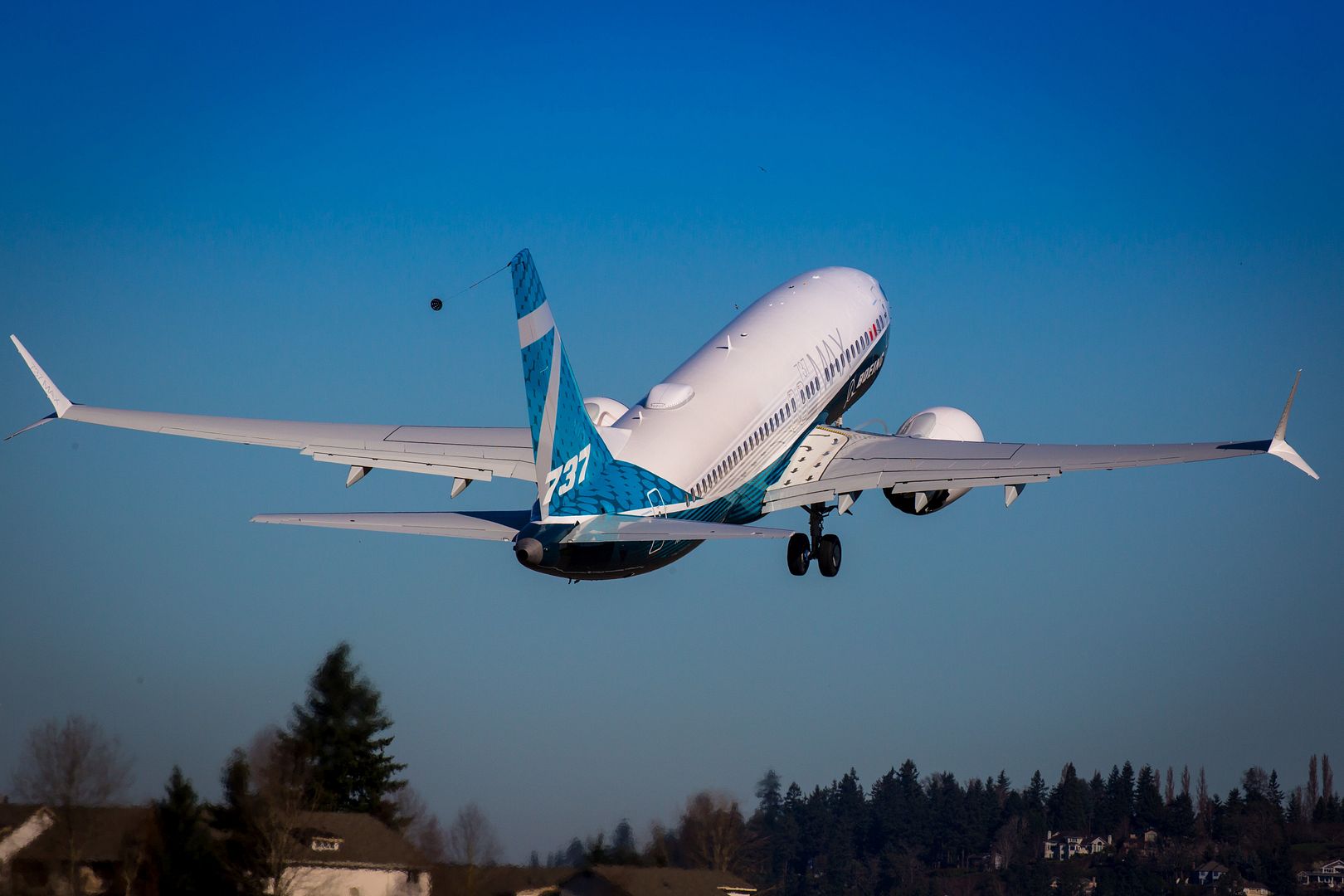
"Everything we saw during today's flight shows that the MAX 7 is performing exactly as designed," said Keith Leverkuhn, vice president and general manager of the 737 MAX program, Boeing Commercial Airplanes. "I know our airline customers are going to enjoy the capabilities this airplane will bring to their fleets."
Piloted by Boeing Test and Evaluation Captains Jim Webb and Keith Otsuka, the airplane completed a successful 3 hour, 5-minute flight, taking off from Renton Field in Renton, Wash., at 10:17 a.m. Pacific, and landing at 1:22 p.m. at Seattle's Boeing Field. The airplane was put through tests on its flight controls, as well as checks of its systems and handling qualities.
The airplane is the third and newest member of Boeing's 737 MAX family to be produced, with a maximum capacity of 172 passengers. The MAX 7 has a range of 3,850 nautical miles, the longest of any MAX family airplane. It is designed for exceptional performance for airline customers flying out of airports at high altitudes and hot climates.
"The MAX 7 will provide airlines an efficient product for opening and flying thinner markets and accessing challenging airports, while enjoying all the benefits of being part of the 737 MAX family," said Randy Tinseth, vice president of Marketing, Boeing Commercial Airplanes.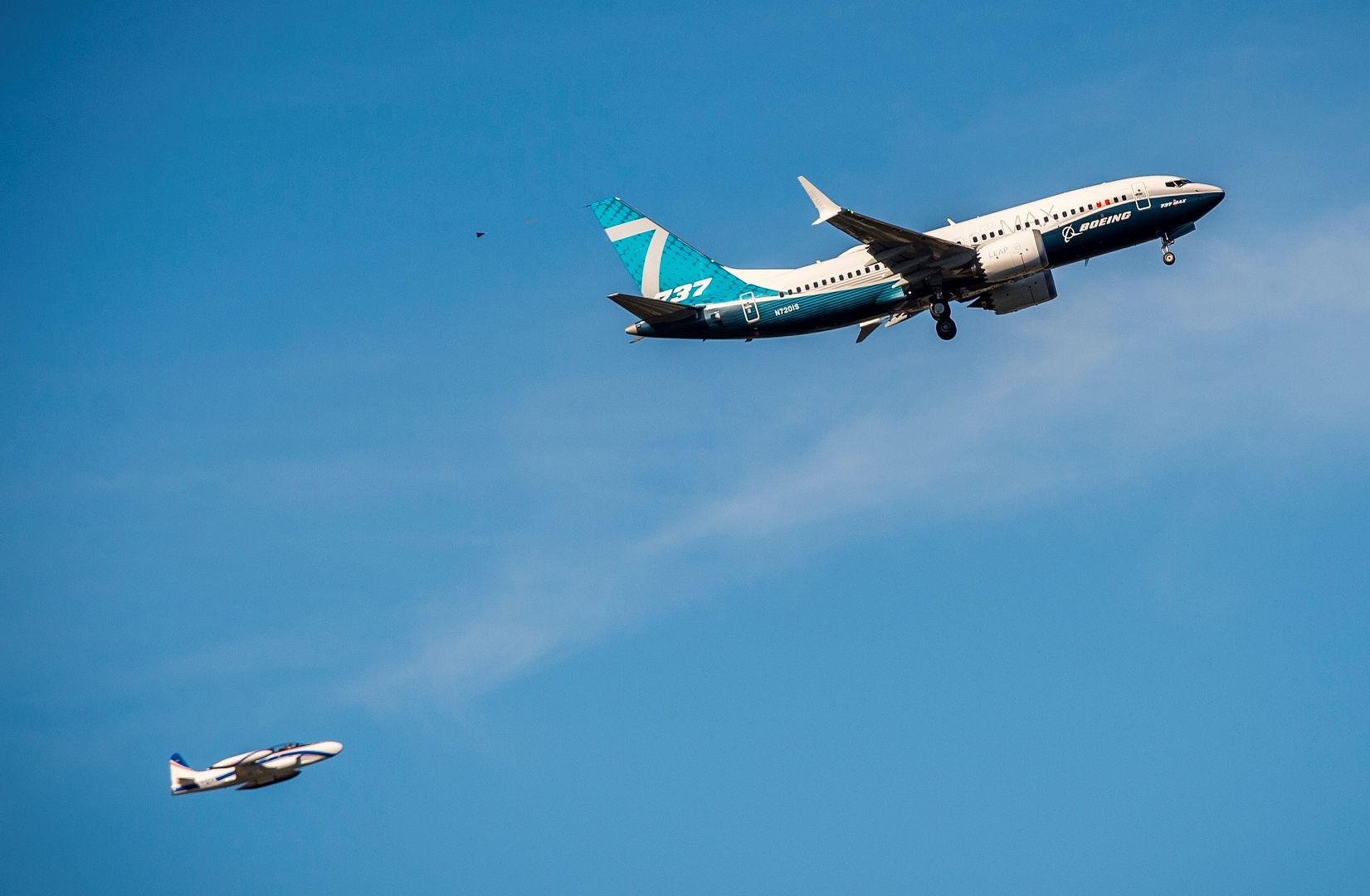
The MAX 7 also offers superior performance to the competition, carrying 12 more passengers 400 nautical miles farther than the A319neo, on 7 percent lower fuel costs.
The 737 MAX family incorporates the latest CFM International LEAP-1B engines, Advanced Technology winglets, Boeing Sky Interior, large flight deck displays and other features to deliver the highest efficiency, reliability and passenger comfort in the single-aisle market.
The 737 MAX is the fastest-selling airplane in Boeing history, accumulating more than 4,300 orders from 93 customers worldwide. For more information and feature content, visit www.boeing.com/commercial/737max.
RAF pilots from 3 (Fighter) Sqn have begun the final week of Exercise Iniochos 18 in Greece. Normally based at Royal Air Force Coningsby the pilots are testing themselves flying simulated combat missions with aircrew from Greece the United States, Italy, and the United Arab Emirates.
In addition to the challenges faced by the aircrew of working together in a coalition. The ground crews of the various nations have had to learn to work together cooperating on a very busy airbase.
Flight Lieutenant Andy King one of the Engineer officers with 3 (F) Sqn said: ?We are working alongside a number of other nations including the Italians. The challenges are sharing spaces like maintenance hangers, we have only one slot for us and the Italians which the Greeks are coordinating. So we work together to understand each other?s cultures and the difference between each other?s rules.?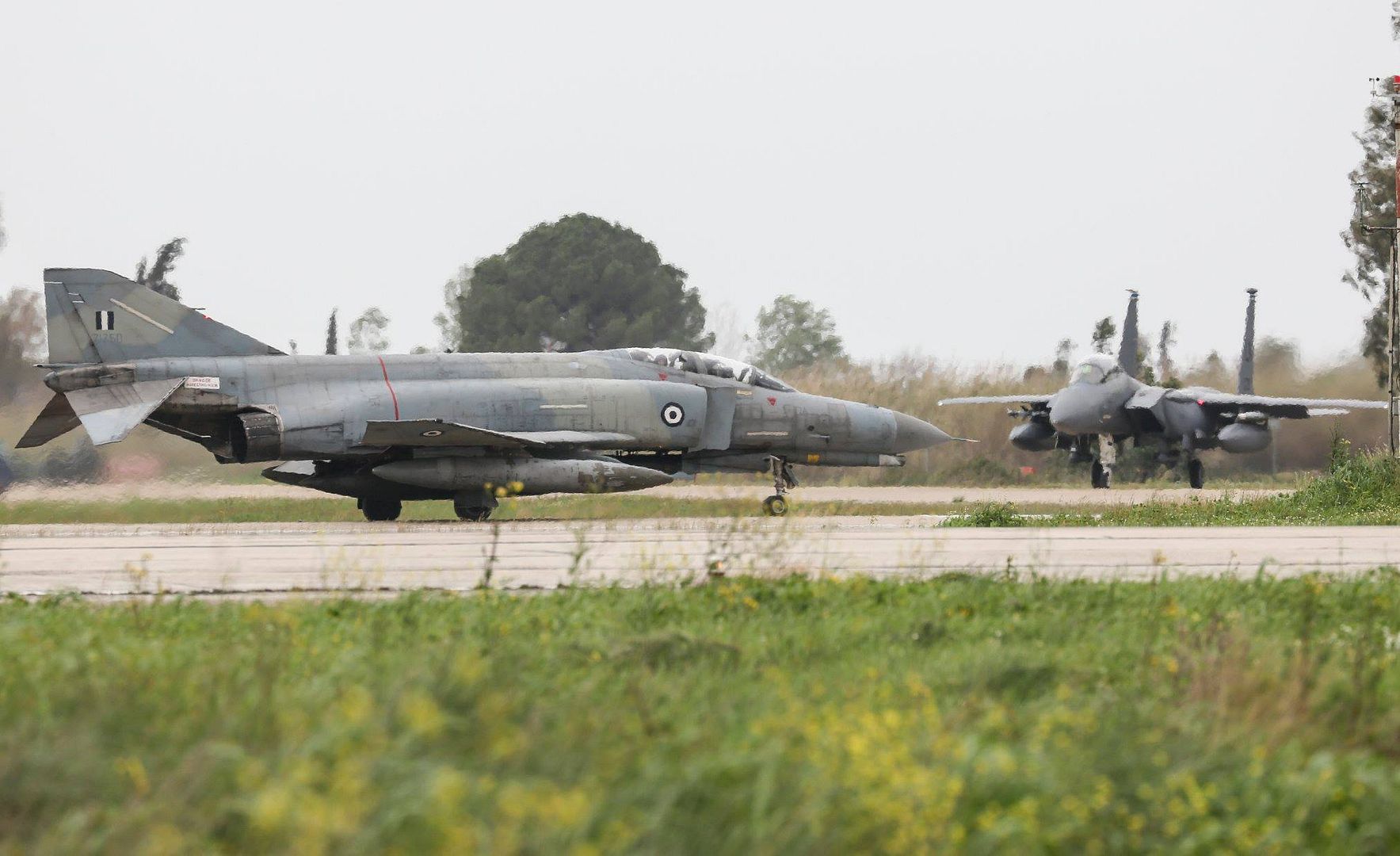
The exercise runs until the end of the week when the various contingents will return to their home bases.
-
 Main AdminARABIAN GULF (March 19, 2018) An F/A-18C Hornet, assigned to the Checkerboards of Marine Strike Fighter Attack Squadron (VMFA) 312, launches from the flight deck of the aircraft carrier USS Theodore Roosevelt (CVN 71). Theodore Roosevelt and its carrier strike group are deployed to the U.S. 5th Fleet area of operations in support of maritime security operations to reassure allies and partners and preserve the freedom of navigation and the free flow of commerce in the region. (U.S. Navy photo by Mass Communication Specialist 3rd Class Alex Perlman/Released)
Main AdminARABIAN GULF (March 19, 2018) An F/A-18C Hornet, assigned to the Checkerboards of Marine Strike Fighter Attack Squadron (VMFA) 312, launches from the flight deck of the aircraft carrier USS Theodore Roosevelt (CVN 71). Theodore Roosevelt and its carrier strike group are deployed to the U.S. 5th Fleet area of operations in support of maritime security operations to reassure allies and partners and preserve the freedom of navigation and the free flow of commerce in the region. (U.S. Navy photo by Mass Communication Specialist 3rd Class Alex Perlman/Released)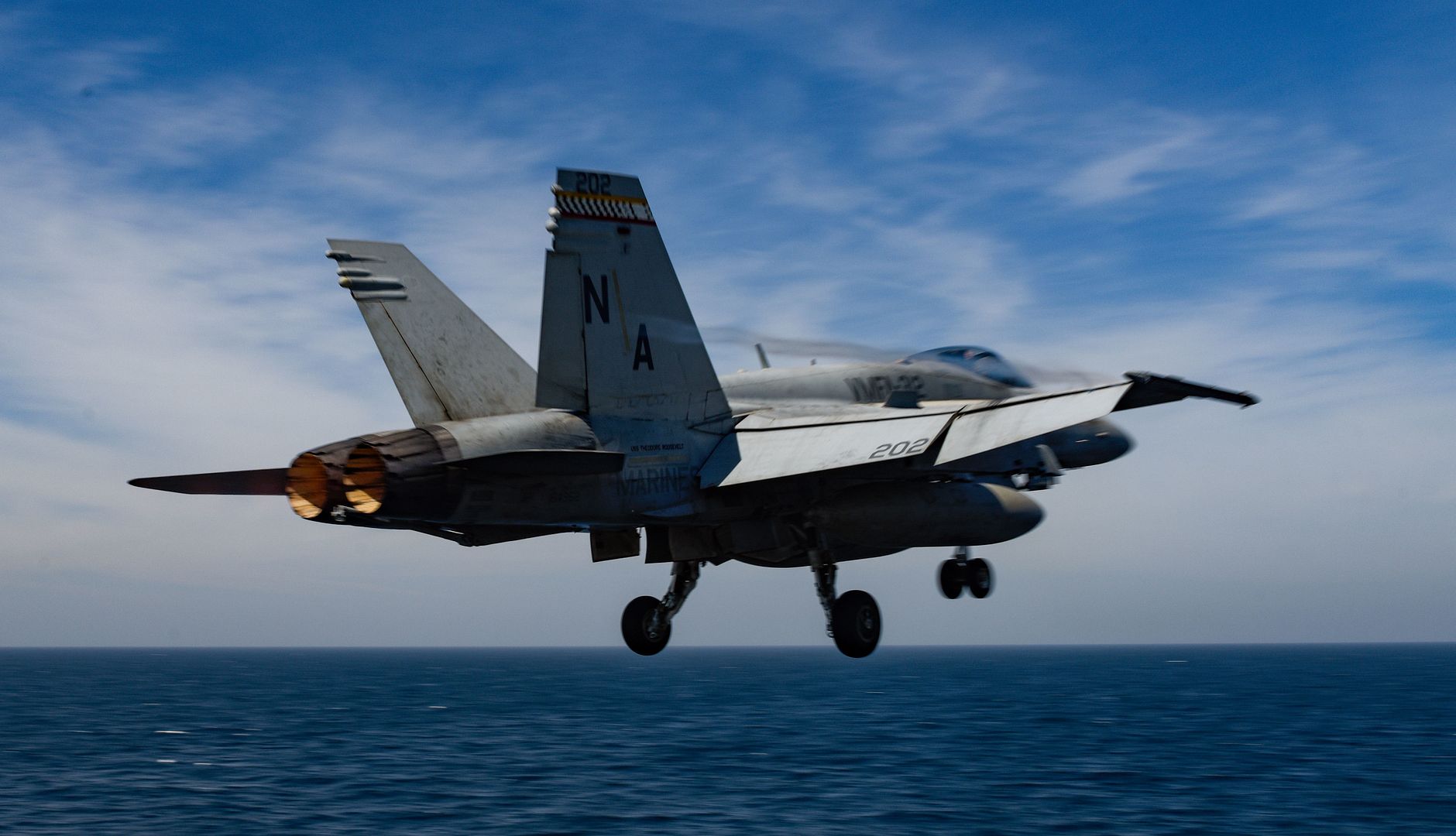
ARABIAN GULF (March 19, 2018) An F/A-18E Hornet, assigned to the Stingers of Strike Fighter Attack Squadron (VFA) 113, launches from the flight deck of the aircraft carrier USS Theodore Roosevelt (CVN 71). Theodore Roosevelt and its carrier strike group are deployed to the U.S. 5th Fleet area of operations in support of maritime security operations to reassure allies and partners and preserve the freedom of navigation and the free flow of commerce in the region. (U.S. Navy photo by Mass Communication Specialist 3rd Class Alex Perlman/Released)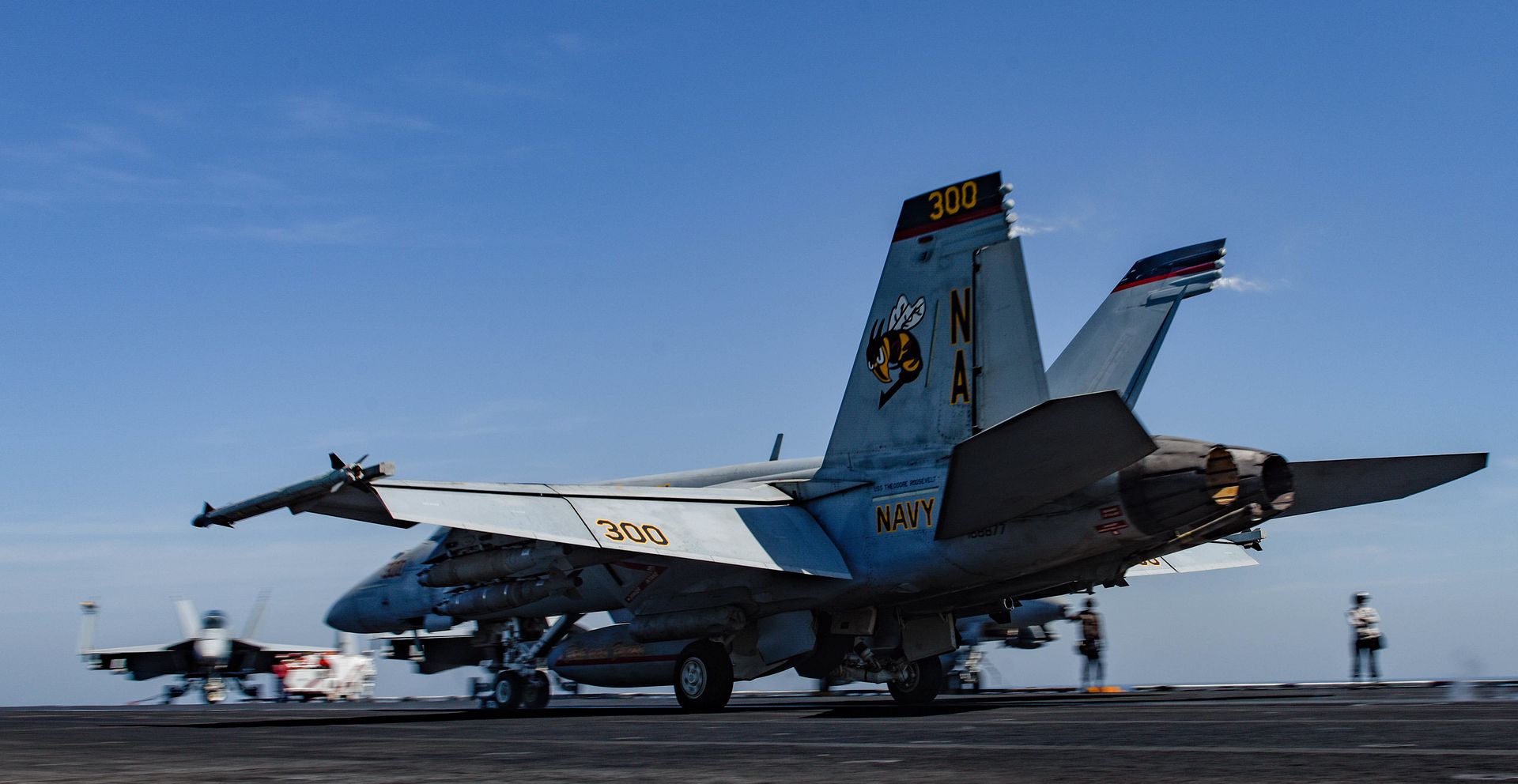
ARABIAN GULF (March 19, 2018) An F/A-18F Super Hornet, assigned to the Mighty Shrikes of Strike Fighter Attack Squadron (VFA) 94, launches from the flight deck of the aircraft carrier USS Theodore Roosevelt (CVN 71). Theodore Roosevelt and its carrier strike group are deployed to the U.S. 5th Fleet area of operations in support of maritime security operations to reassure allies and partners and preserve the freedom of navigation and the free flow of commerce in the region. (U.S. Navy photo by Mass Communication Specialist 3rd Class Alex Perlman/Released)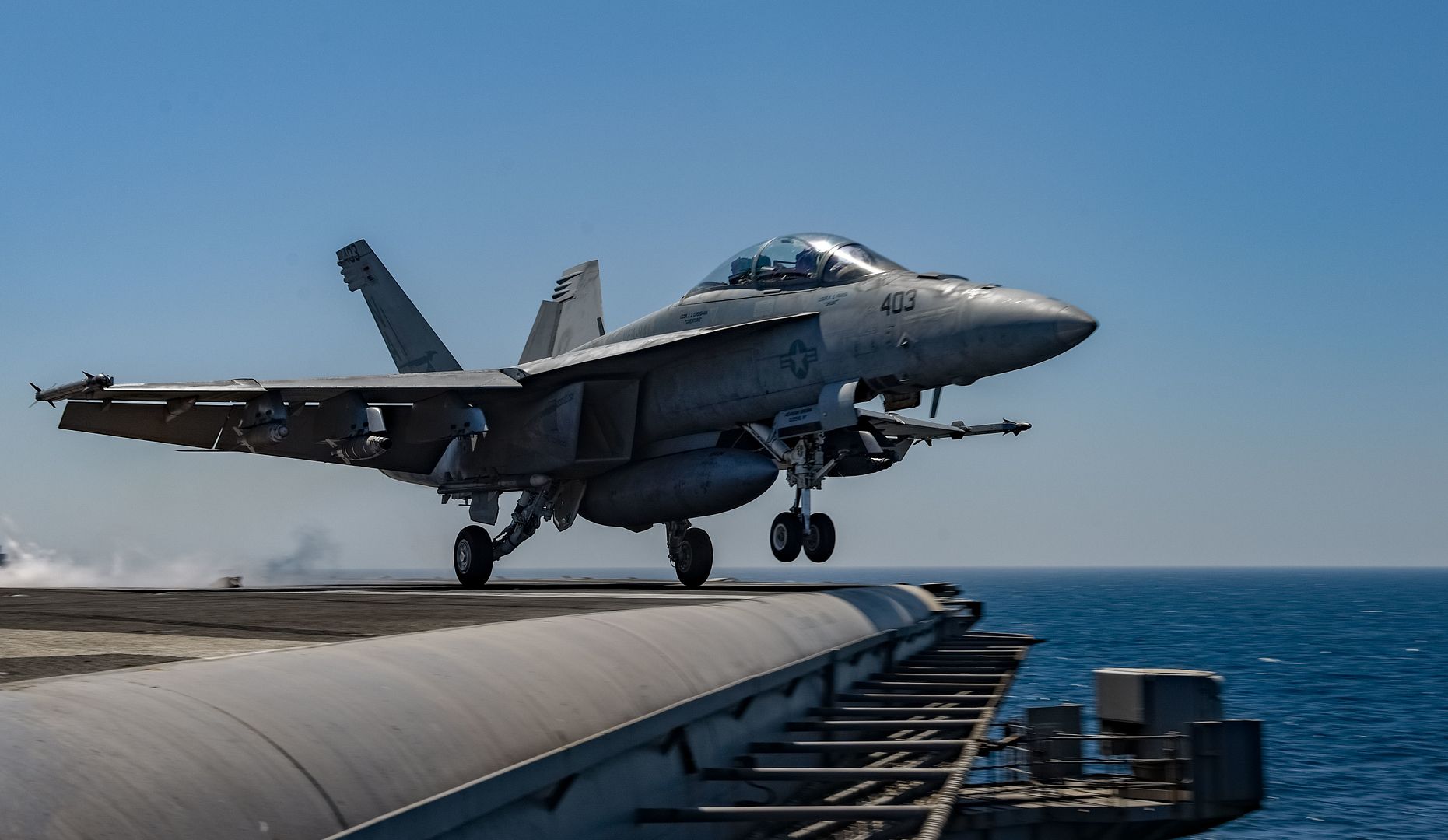
ARABIAN GULF (March 19, 2018) A C-2A Greyhound, assigned to the Providers of Fleet Logistics Support Squadron (VRC) 30, taxis on the flight deck of the aircraft carrier USS Theodore Roosevelt (CVN 71). Theodore Roosevelt and its carrier strike group are deployed to the U.S. 5th Fleet area of operations in support of maritime security operations to reassure allies and partners and preserve the freedom of navigation and the free flow of commerce in the region. (U.S. Navy photo by Mass Communication Specialist 3rd Class Andrew Langholf/Released)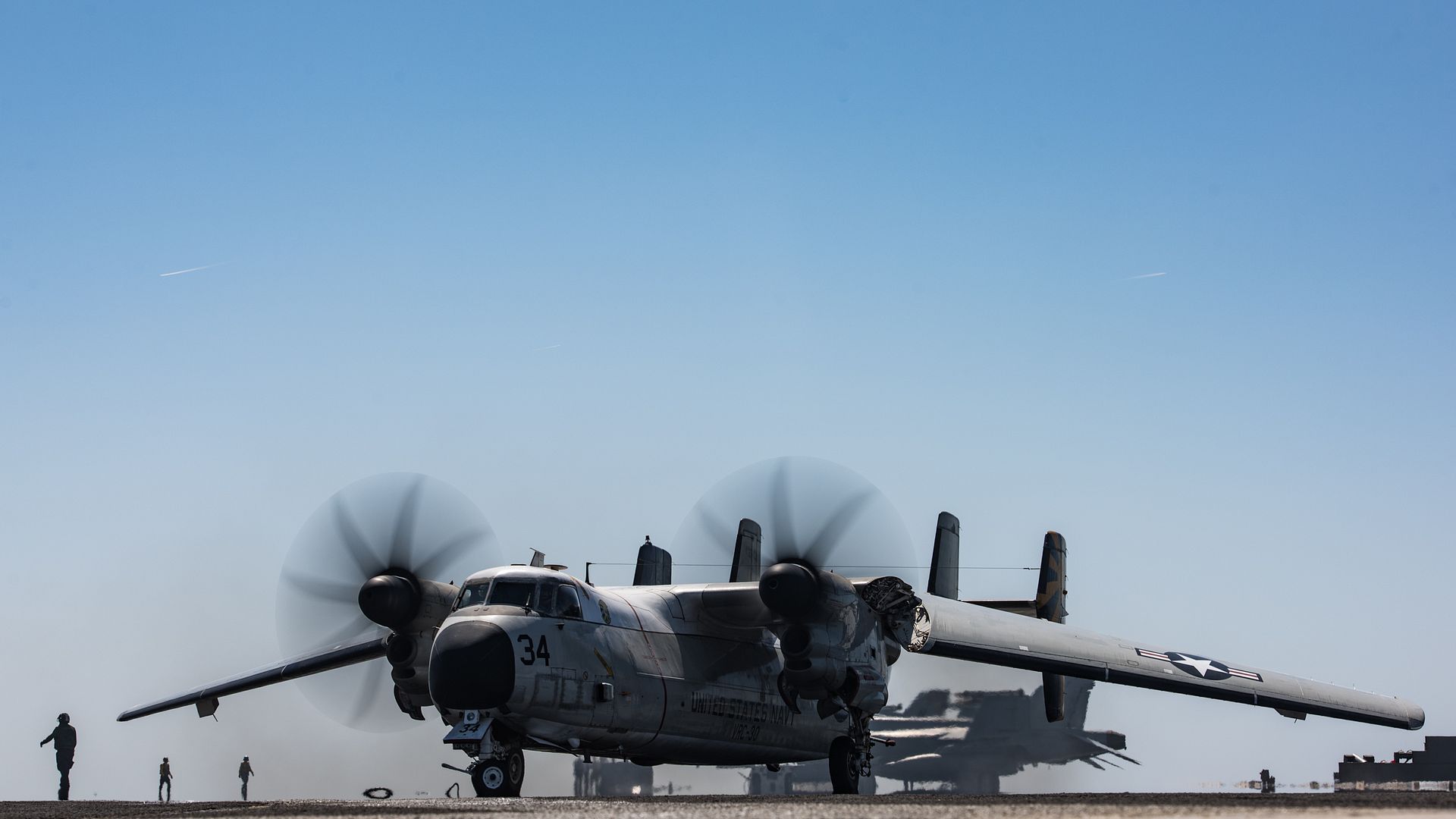
Lt. Cmdr. Christopher Tabert, F-35 Pax River Integrated Test Force test pilot, takes CF-5, a Navy F-35 variant, on one of the last system development and design tests with a 2,000 pound external weapons catapult March 19 at Naval Air Station Patuxent River, Maryland.
The F-35C is a carrier variant designed for the U.S. Navy as a first-day-of-war, survivable strike fighter complement to the F/A-18E/F Super Hornet.
U. S. Navy photo by Arnel Parker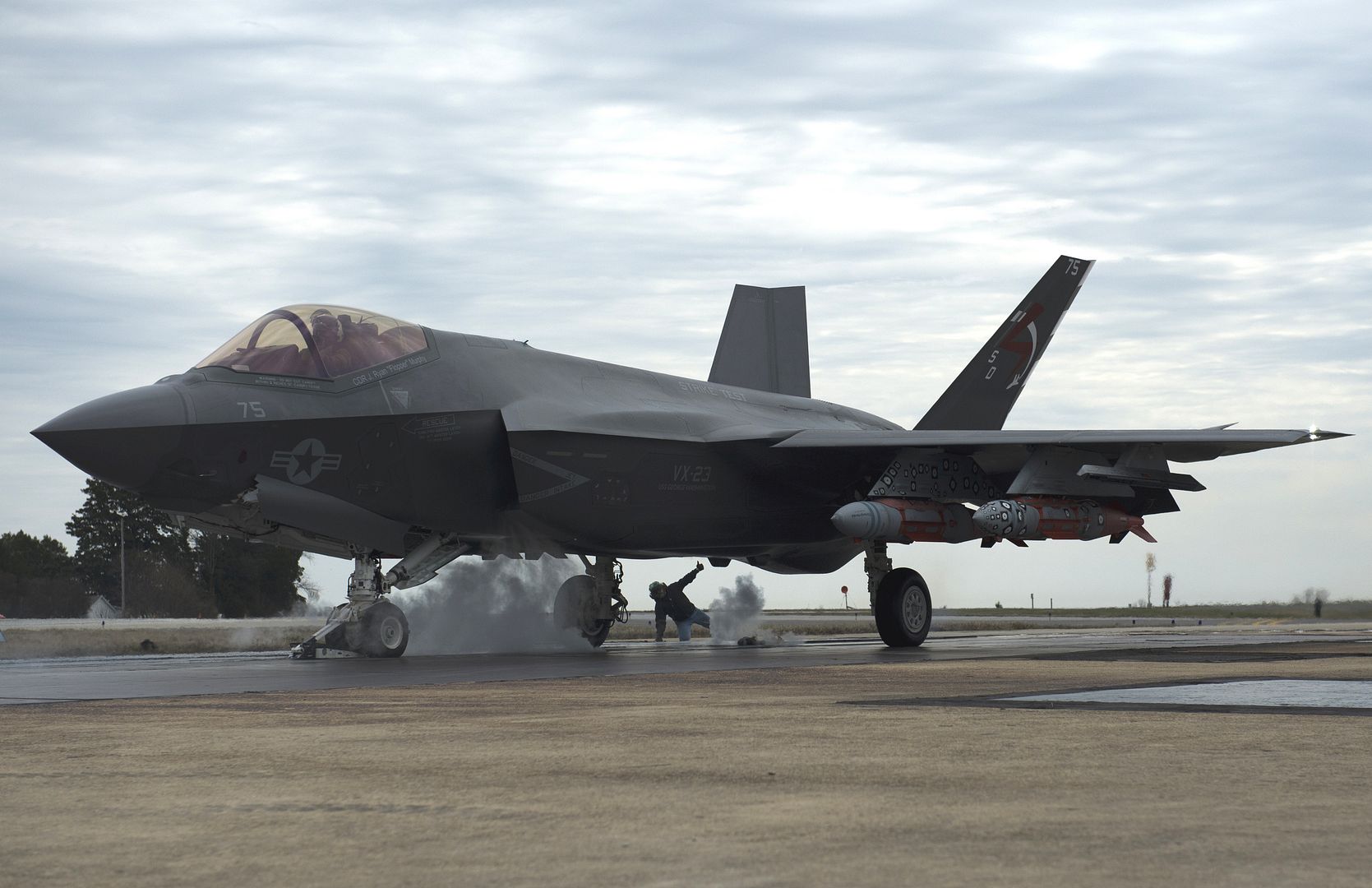
An F-35 Lightning II flies over as part of the Heritage Flight, also comprising of the P-51 Mustang, A-10 Thunderbolt, and F-22 Raptor, during Luke Days at Luke Air Force Base, Ariz., March 18, 2018. Luke Days demonstrates the capabilities of modern military and civilian airpower through the display of more than 30 live air and ground demonstrations and static exhibits. (U.S. Air Force photo by Staff Sgt. Tyler J. Bolken)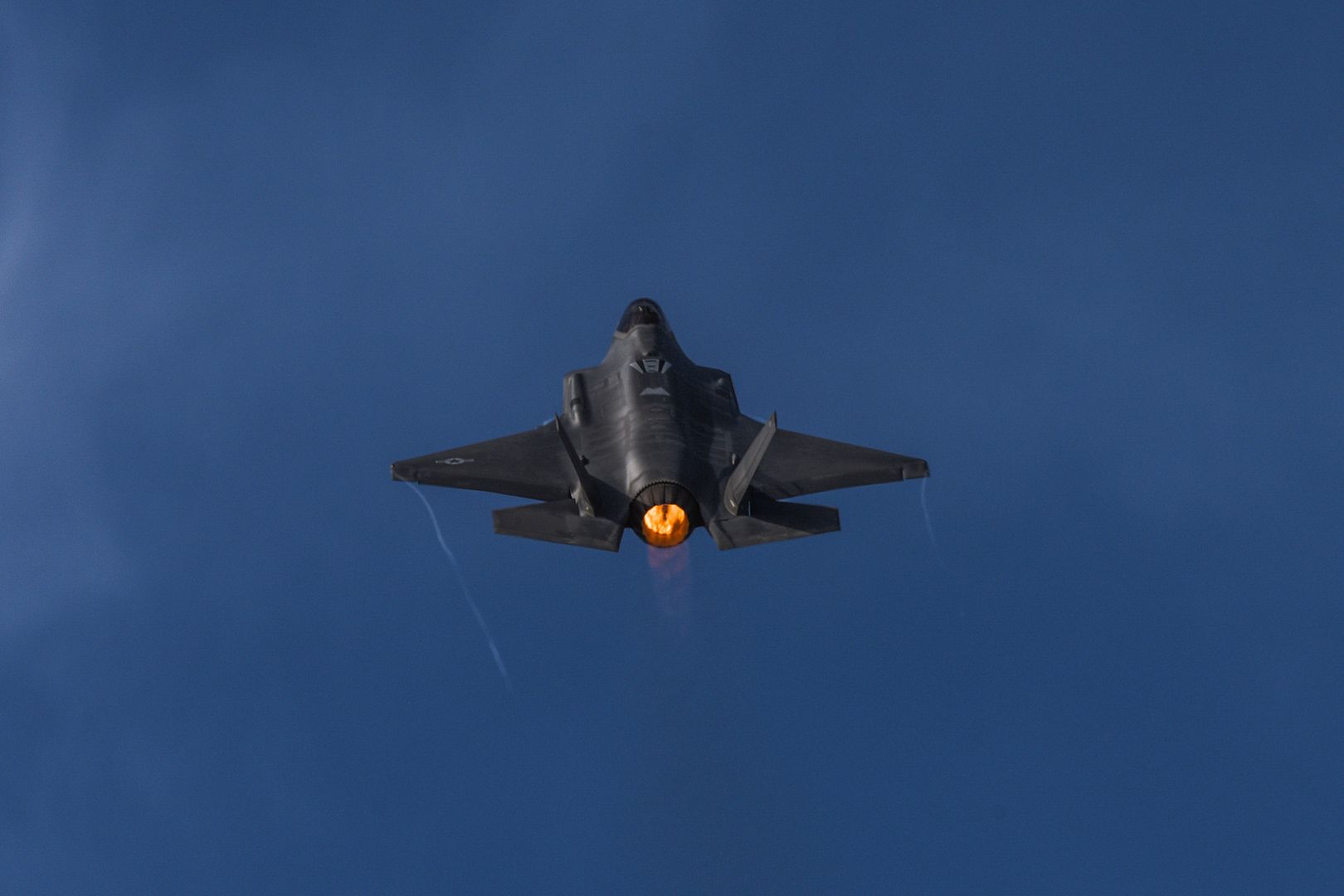
A KC-135R Stratotanker assigned to the 916th Air Refueling Wing takes off at Yokota Air Base, Japan, March 19, 2018. The mission of the 916th ARW, Air Force Reserve Command, located at Seymour Johnson Air Force Base, N.C. is to fly the KC-135R in air-to-air refueling missions and is deployable to support U.S. military interests at home and abroad. (U.S. Air Force photo by Yasuo Osakabe)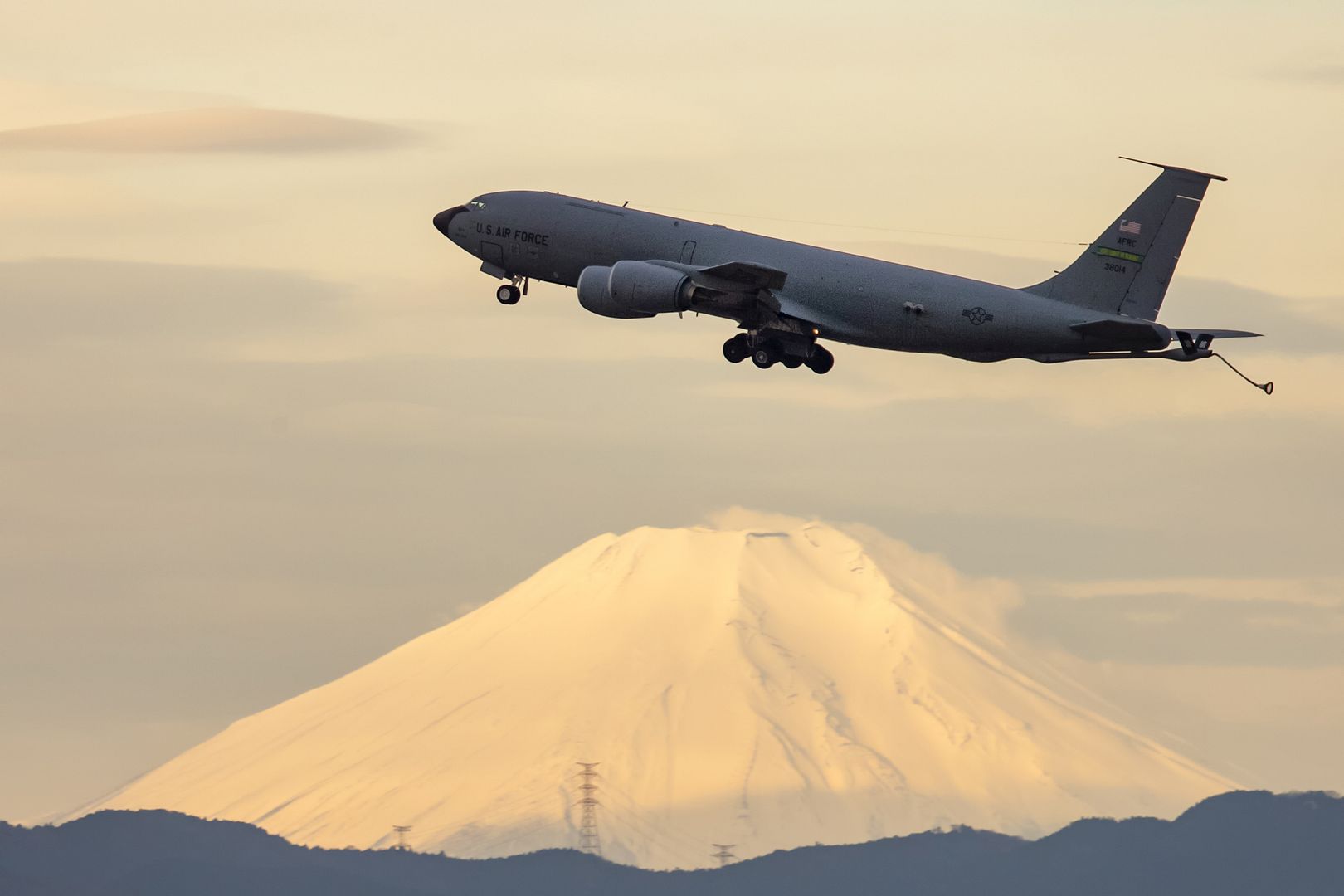
Air Force One departs from Joint Base Andrews, Md. with President of the United States Donald J. Trump and First Lady Melania Trump on board, March 19, 2018. The president traveled from JBA to Manchester, N.H. to give a speech on the countries opioid epidemic. The 89th Airlift Wing provides global Special Air Mission airlift, logistics, aerial port and communications for the president, vice president, cabinet members, combatant commanders and other senior military and elected leaders as tasked by the White House, Air Force chief of staff and Air Mobility Command. (U.S. Air Force Photo/Staff Sgt. Kenny Holston)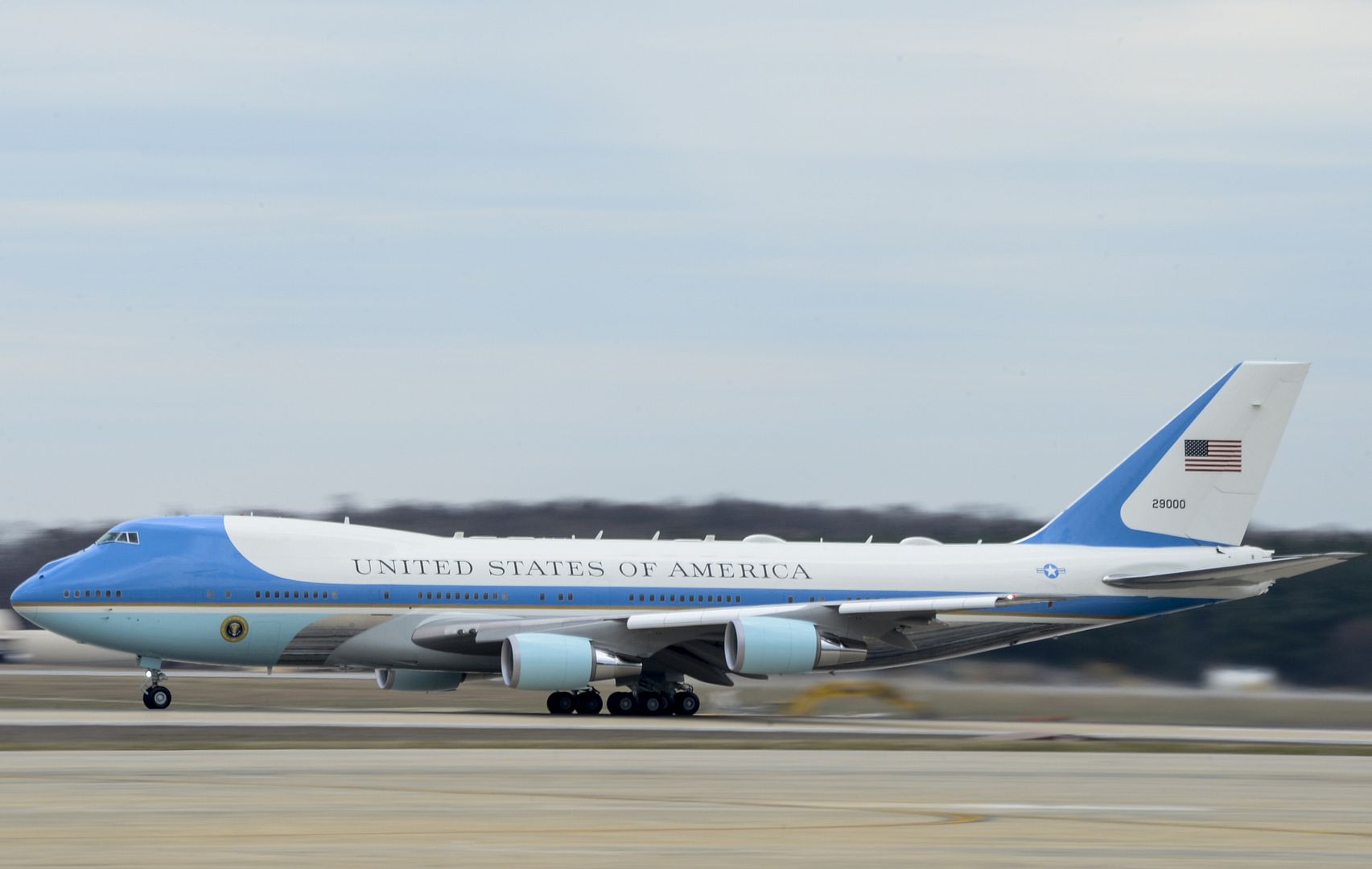
F-16 Fighting Falcons, 112th Expeditionary Fighter Squadron from the 180th Fighter Wing, Ohio Air National Guard, participate in a readiness exercise at Spangdahlem Air Base, Germany, March 13, 2018. The ability of Airmen to survive and operate in a combat environment and effectively perform wartime missions is getting renewed attention in response to Defense Department and Department of the Air Force priorities calling for more focus on readiness. (U.S. Air Force photo by Staff Sgt. Jonathan Snyder)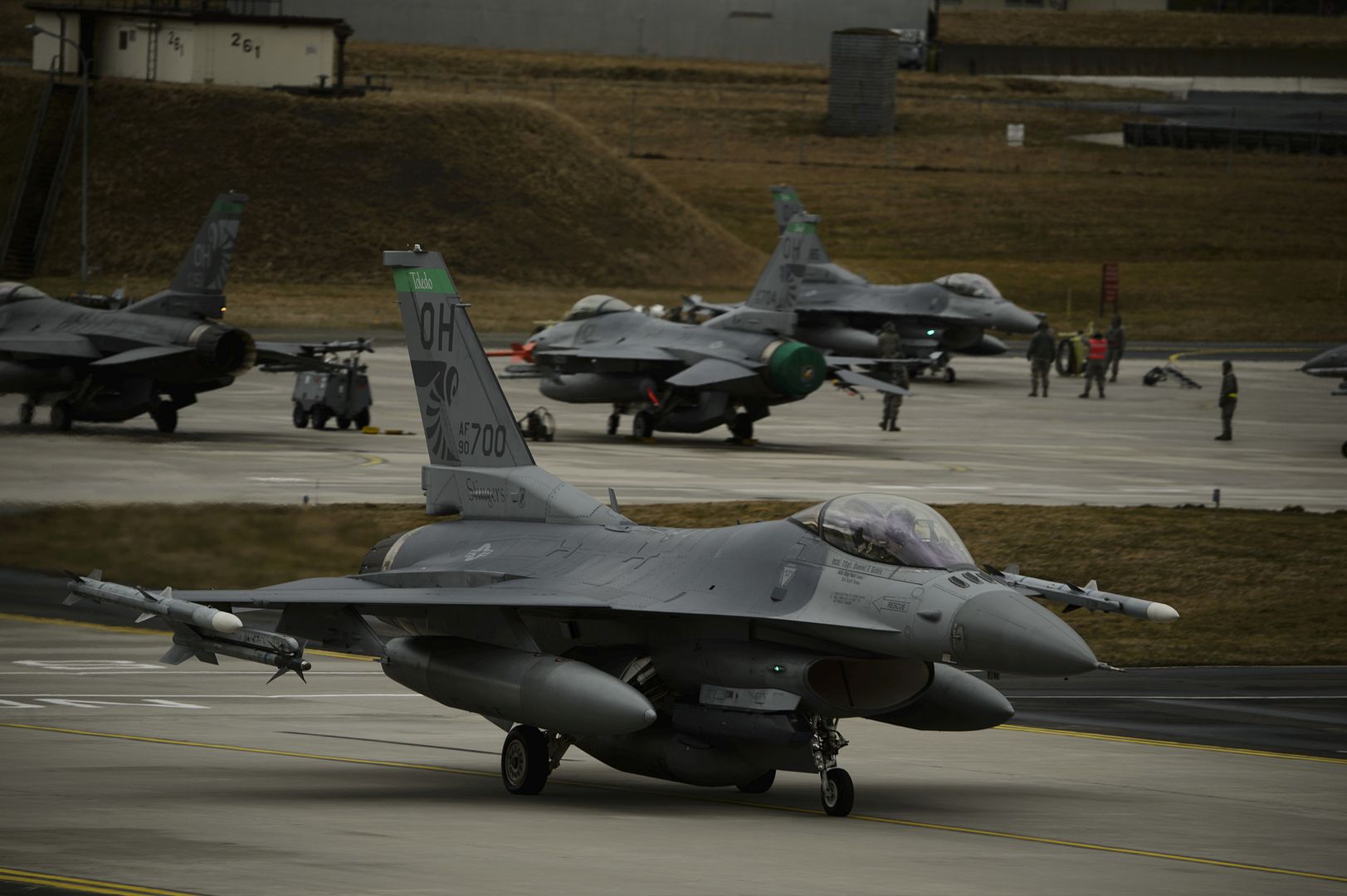
Two F-16 Fighting Falcons, 112th Expeditionary Fighter Squadron, made up of Airmen from the 180th Fighter Wing out of the Ohio Air National Guard, participate in a readiness exercise at Spangdahlem Air Base, Germany, March 13, 2018. The 112th EFS is deployed here to participate in 52nd FW led exercise. (U.S. Air Force photo by Staff Sgt. Jonathan Snyder)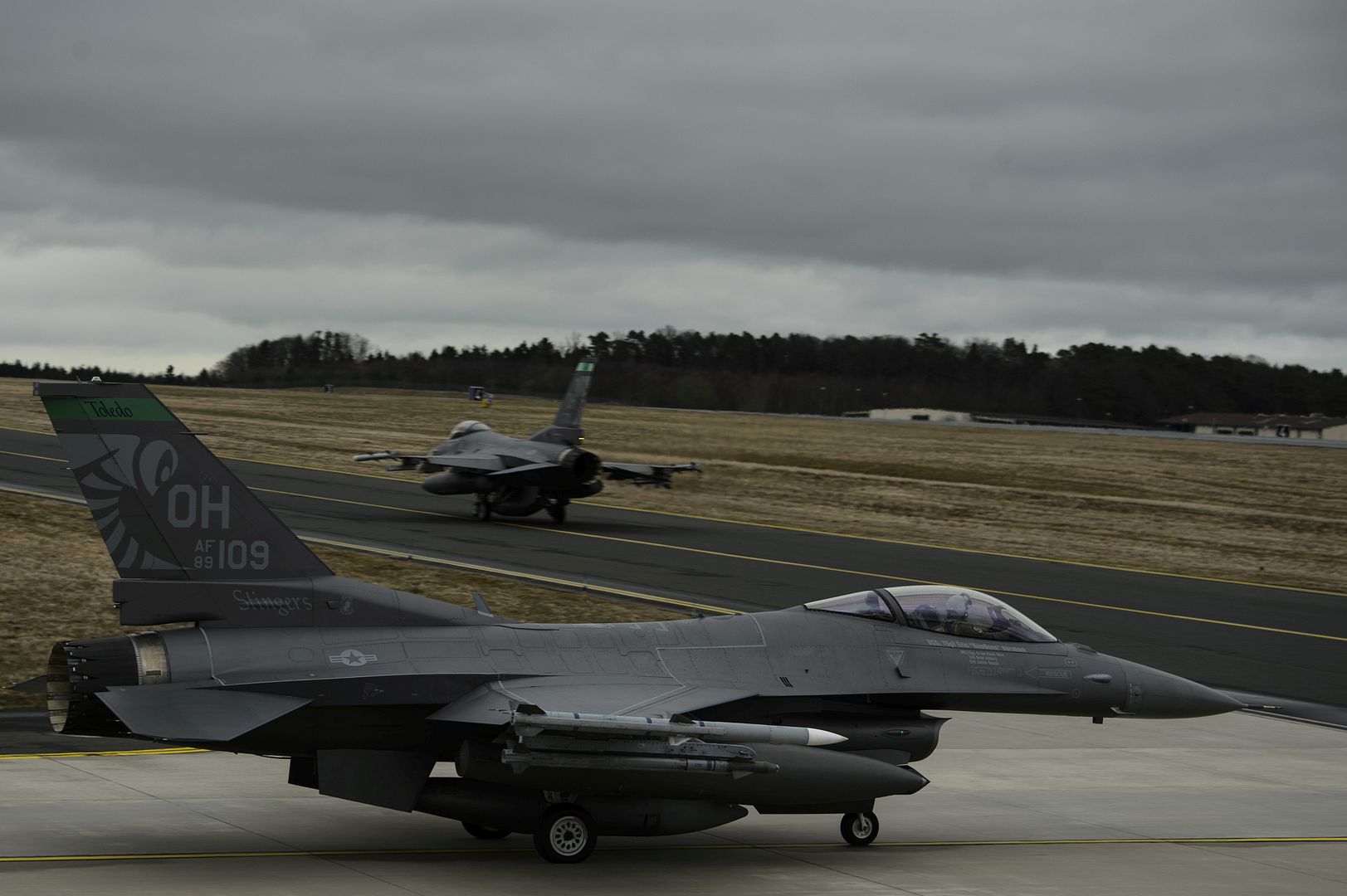
A U.S. F-16 Fighting Falcon assigned to the 112th Expeditionary Fighter Squadron, from the 180th Fighter Wing, Ohio Air National Guard, taxis down the flightline at Spangdahlem Air Base, Germany, March. 6, 2018. The 112th EFS helped finesse the ability to quickly respond and reassure allies and partners that the 52nd Fighter Wing is combat forward and ready. (U.S. Air Force photo by Senior Airman Dawn M. Weber)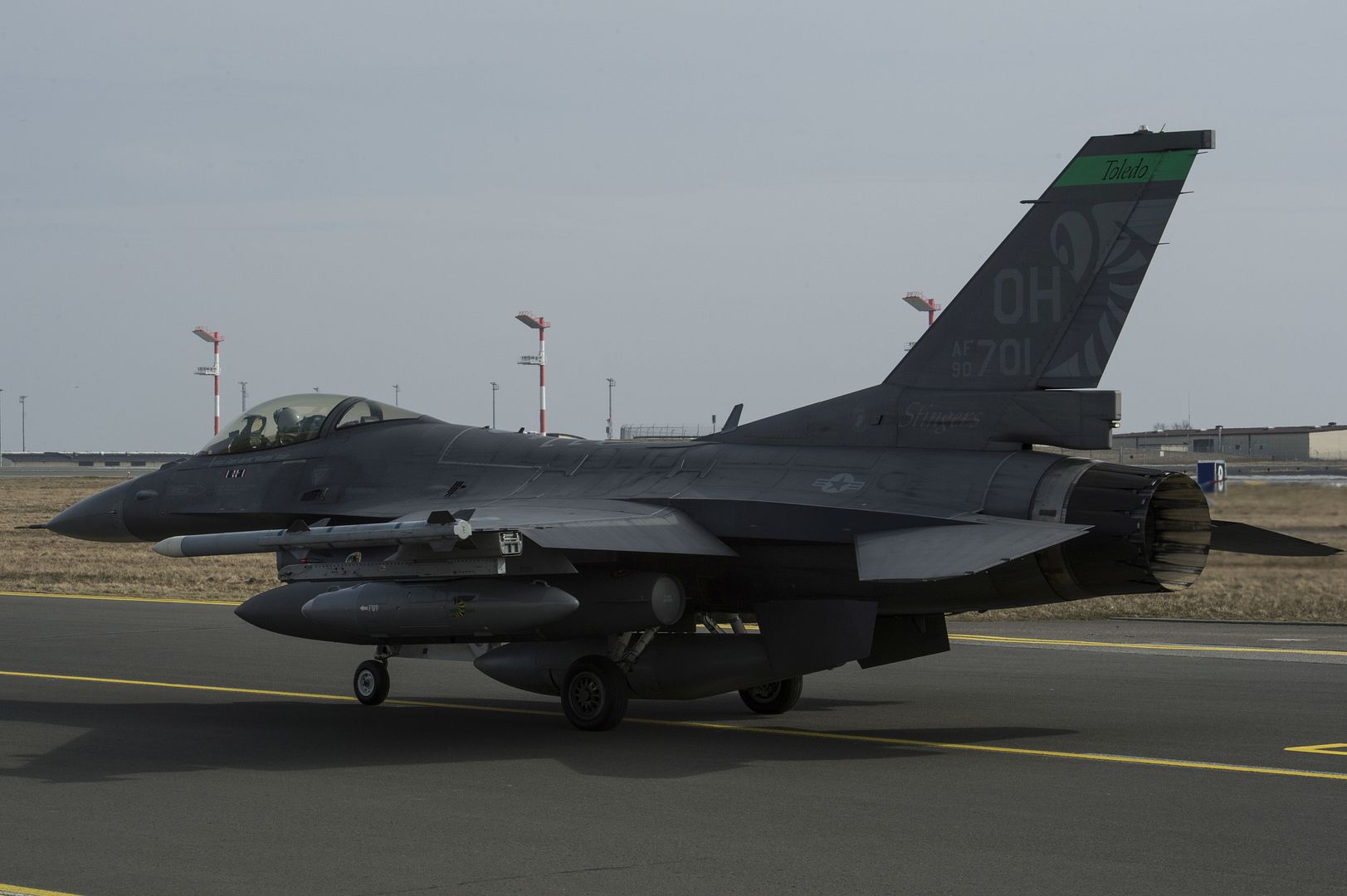
Australia?s new maritime surveillance aircraft the P-8A Poseidon has achieved Initial Operating Capability (IOC), five months ahead of the original schedule.
Minister for Defence, Senator the Hon Marise Payne, congratulated Air Force and CASG on the significant milestone that has been achieved.
?Together the P-8A Poseidon and the future MQ-4C Triton aircraft will provide Australia with one of the world?s most advanced maritime patrol and surveillance capabilities,? Minister Payne said.
?The P-8A is a very capable and effective successor to the AP-3C Orion, which will soon retire from the role after nearly 40 years of distinguished service.
?The Poseidon will improve Defence?s ability to conduct Anti-Submarine warfare, maritime patrol and surveillance of Australia?s maritime approaches.?
Chief of Air Force, Air Marshal Leo Davies, said declaring IOC was a significant milestone because the P-8A is a fundamental element of Australian Defence Forces future maritime strategy.
?The arrival of the P-8A has allowed Air Force, under Plan Jericho, to develop and evolve new operating concepts, support arrangements and sustainment options," Air Marshal Davies said.
?These will best exploit the P-8A?s sensors and networking as part of integrated Navy and Air Force integrated Maritime Intelligence, Surveillance and Reconnaissance Family of Systems.
?The acquisition of the P-8A represents a $5 billion investment in Australia?s maritime patrol capability and along with the MQ-4C Triton, will be a very capable and effective successor to the AP-3C Orion.?
To date, six of Australia?s 12 P-8As have arrived in Australia, operated by Number 11 Squadron from RAAF Base Edinburgh in South Australia.
-
 Main AdminAn AH-64D Apache Longbow helicopter assigned to 1st Battalion, 3rd Aviation Regiment, 12th Combat Aviation Brigade supports Company A, 2nd Battalion, 503rd Infantry Regiment, 173rd Airborne Brigade during a Platoon Level Live Fire Exercise at the 7th Army Training Command?s Grafenwoehr Training Area, Germany, March 19, 2018. (U.S. Army photo by Gertrud Zach)
Main AdminAn AH-64D Apache Longbow helicopter assigned to 1st Battalion, 3rd Aviation Regiment, 12th Combat Aviation Brigade supports Company A, 2nd Battalion, 503rd Infantry Regiment, 173rd Airborne Brigade during a Platoon Level Live Fire Exercise at the 7th Army Training Command?s Grafenwoehr Training Area, Germany, March 19, 2018. (U.S. Army photo by Gertrud Zach)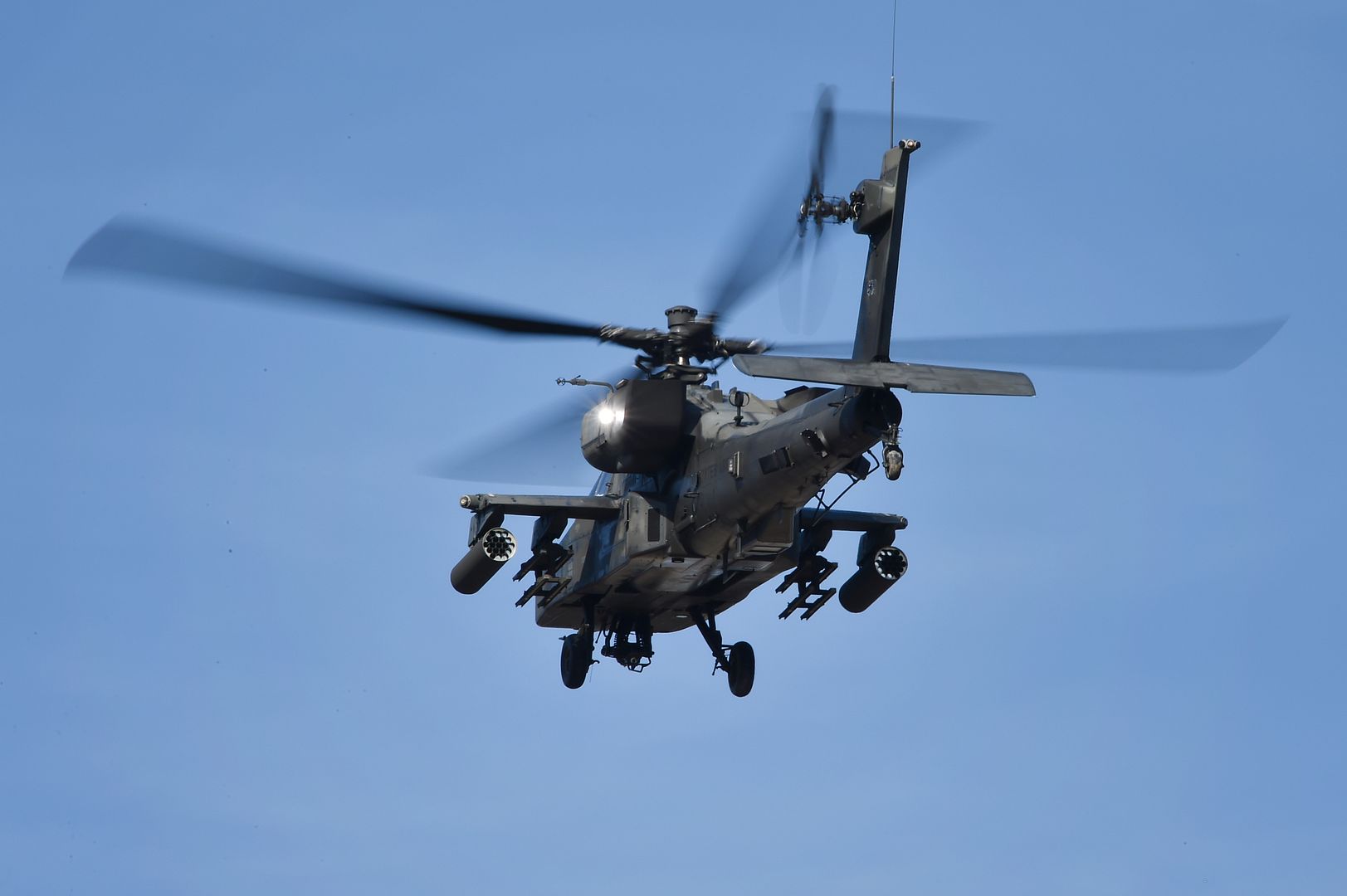
A CH-47 Chinook helicopter assigned to 1st Battalion, 3rd Aviation Regiment, 12th Combat Aviation Brigade supports Company A, 2nd Battalion, 503rd Infantry Regiment, 173rd Airborne Brigade during a Platoon Level Live Fire Exercise at the 7th Army Training Command?s Grafenwoehr Training Area, Germany, March 19, 2018. (U.S. Army photo by Gertrud Zach)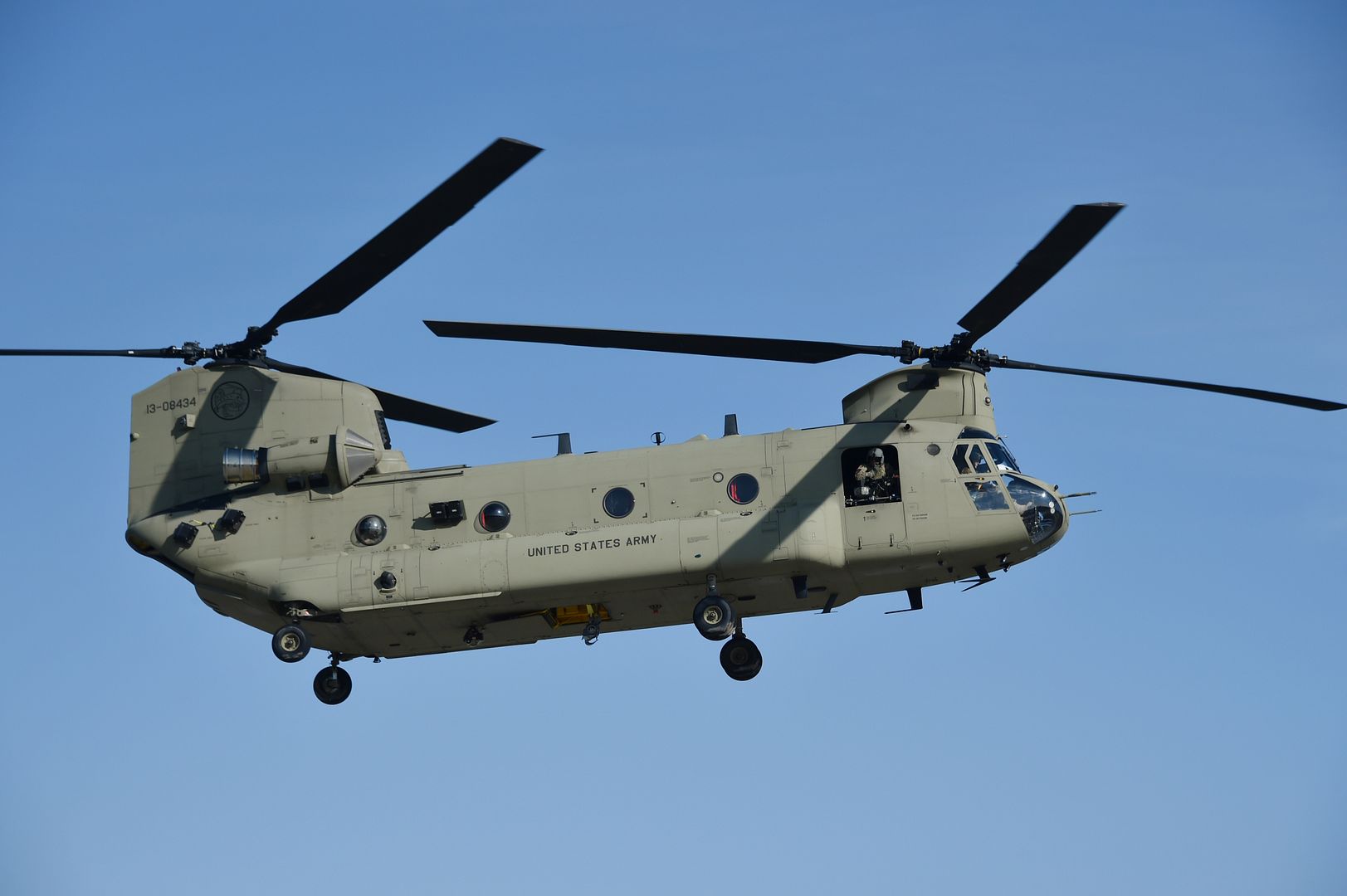
A U.S. Air Force F-16C Fighting Falcon assigned to the 13th Expeditionary Fighter Squadron, 35th Fighter Wing based out of Misawa Air Base, Japan along with an Indonesian air force F-16 taxi after landing during exercise Cope West 18 (CW18) at Sam Ratulangi International Airport, Indonesia, March 19, 2018. CW18 is a Pacific Air Forces-sponsored, bilateral, tactical fighter aircraft exercise involving the U.S. and Indonesian air force and is designed to advance interoperability and build upon already established partnerships between the air forces. (U.S. Air Force photo by Tech. Sgt. Richard Ebensberger)
An Indonesian air force F-16C Fighting Falcons taxi after landing during exercise Cope West 18 (CW18) at Sam Ratulangi International Airport, Indonesia, March 19, 2018. CW18 is a Pacific Air Forces-sponsored, bilateral, tactical fighter aircraft exercise involving the U.S. and Indonesian air force and is designed to advance interoperability and build upon already established partnerships between the air forces. (U.S. Air Force photo by Tech. Sgt. Richard Ebensberger)
TINKER AIR FORCE BASE, Okla. -- Reserve Citizen Airmen from the 507th Air Refueling Wing at Tinker Air Force Base, Okla., refueled seven F/A-18 Hornets from the U.S. Navy Blue Angels team March 19, 2018. The Blue Angels returned home to Pensacola Naval Air Station, Fla., after three months of training at El Centro Naval Air Facility, Calif. (U.S. Air Force photo's/Tech. Sgt. Samantha Mathison)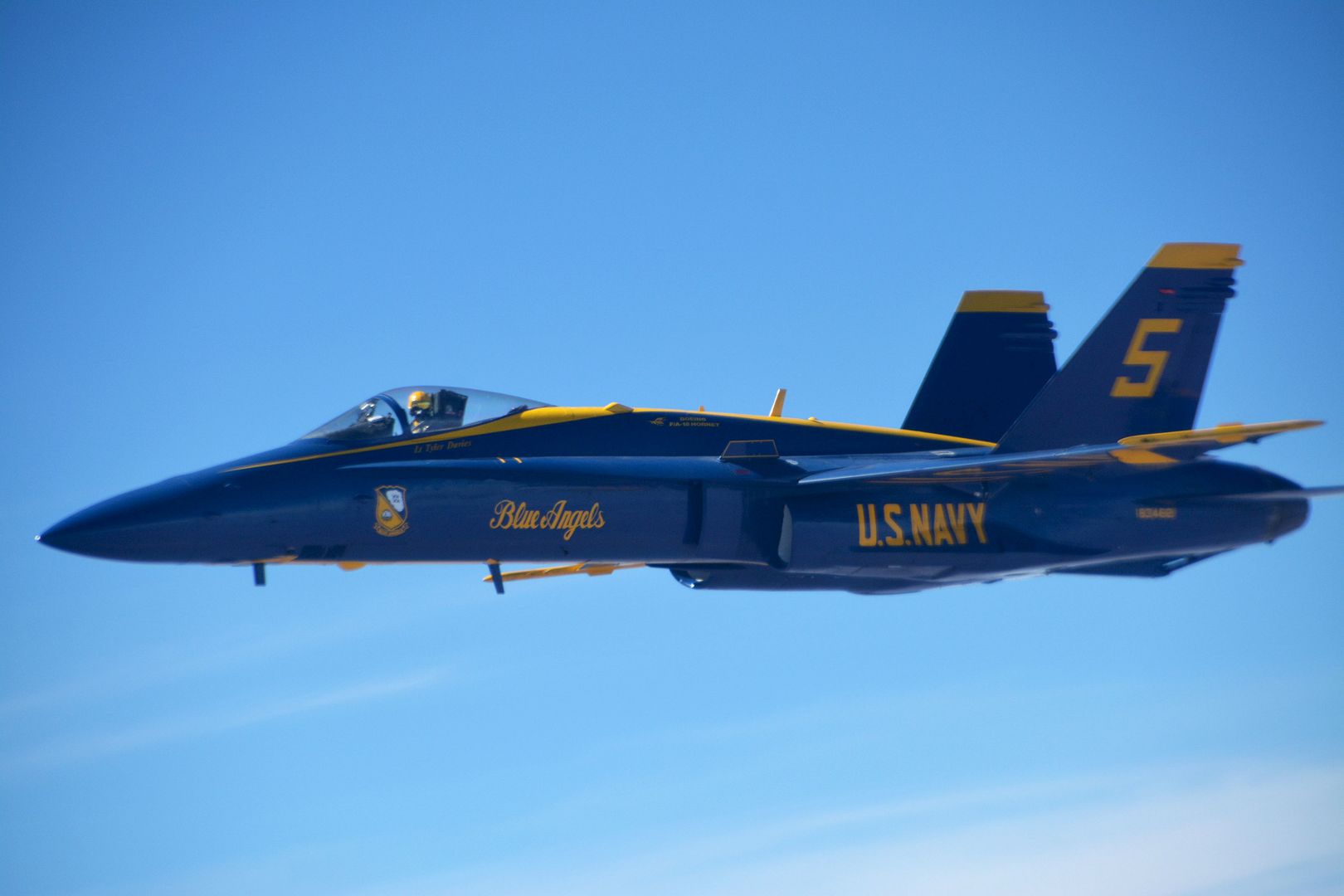
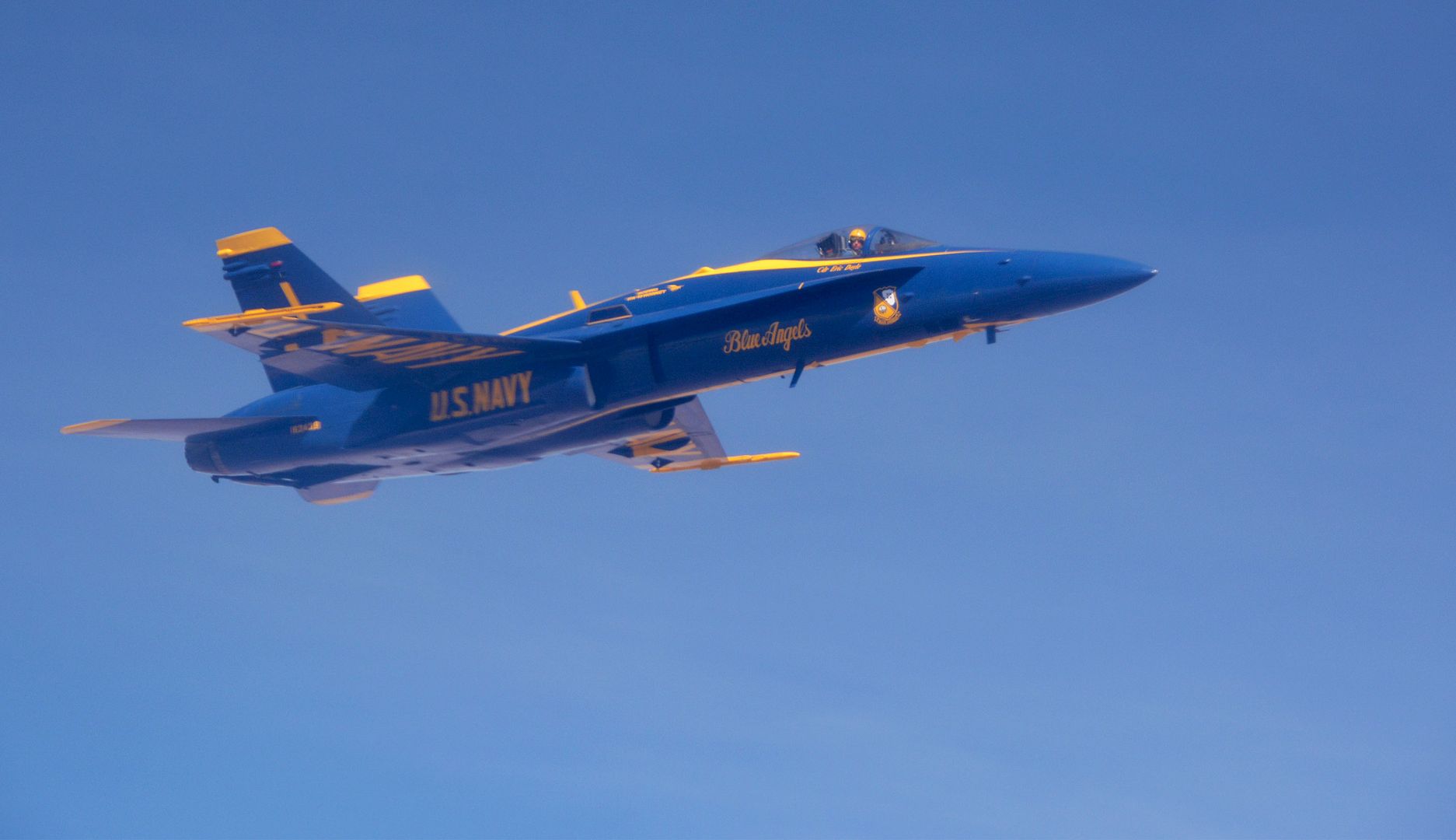
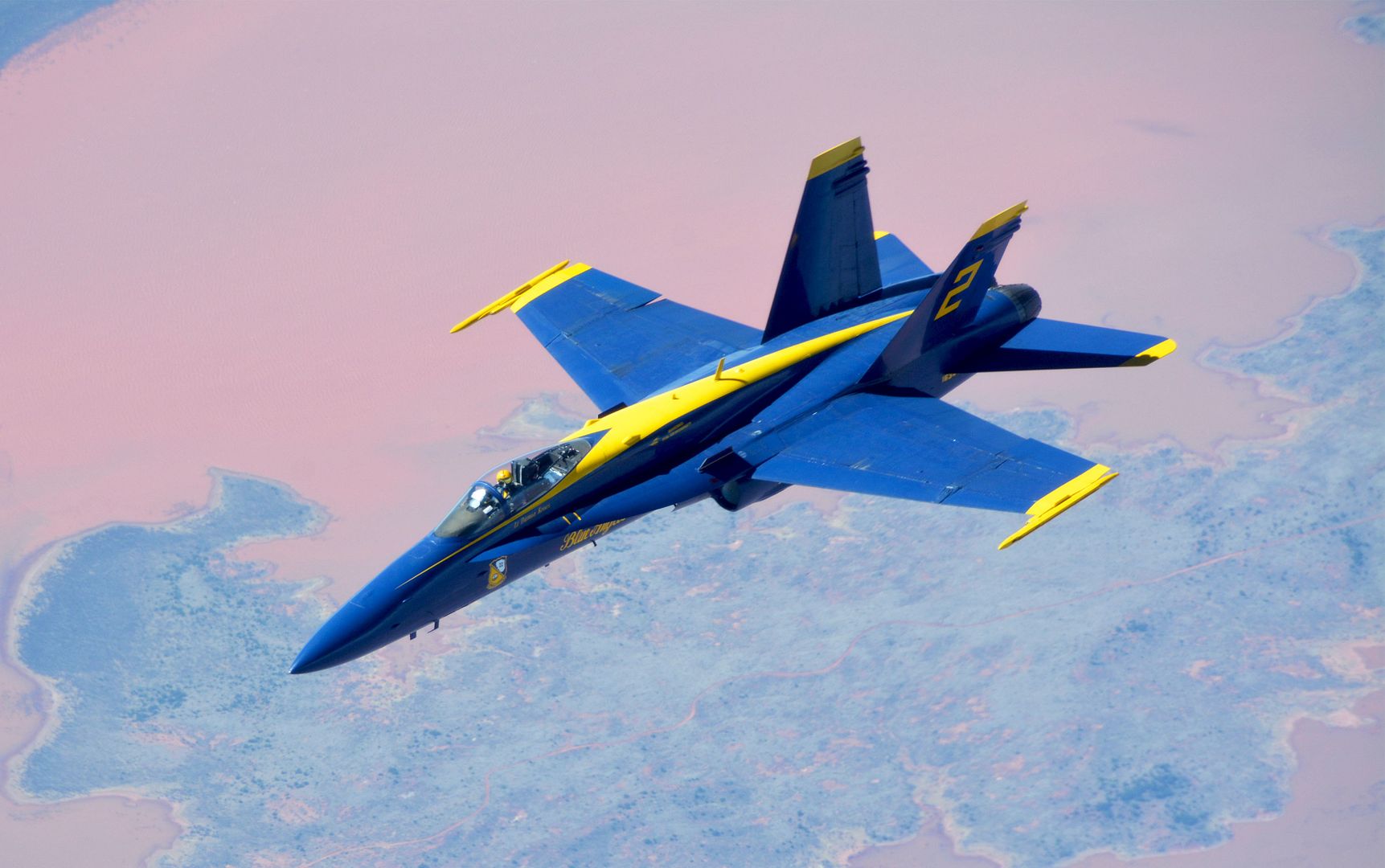

Engine shop specialists with 177th Fighter Wing, New Jersey Air National Guard, perform a high power run to check the engine operation of an F-16C Fighting Falcon at the Air Dominance Center in Savannah, Georgia, March 21, 2018. The 177th FW participated in an air-to-air training exercise to sharpen air combat capabilities and accomplish multiple training upgrades. (U.S. Air National Guard photo's by Senior Airman Cristina J. Allen)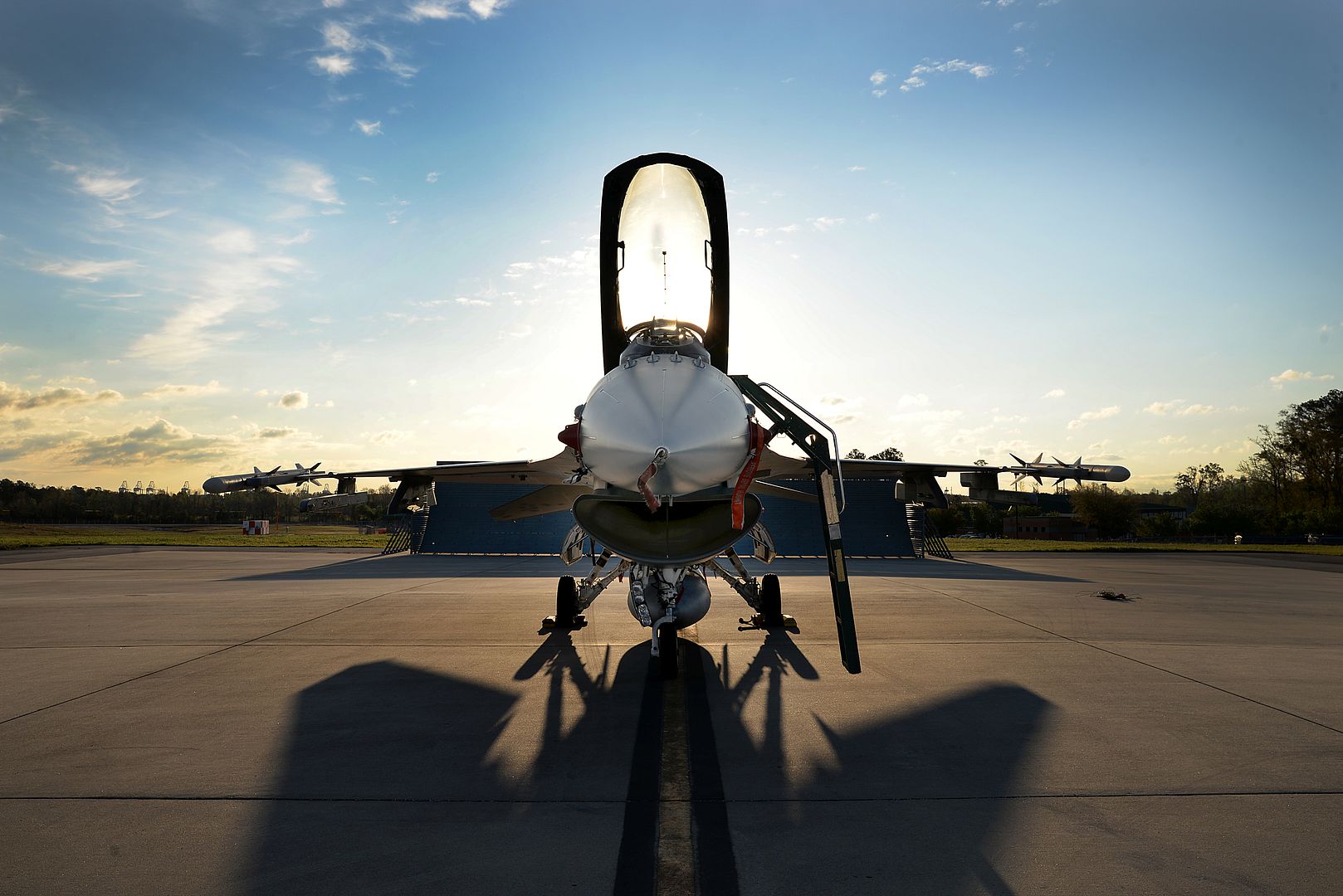
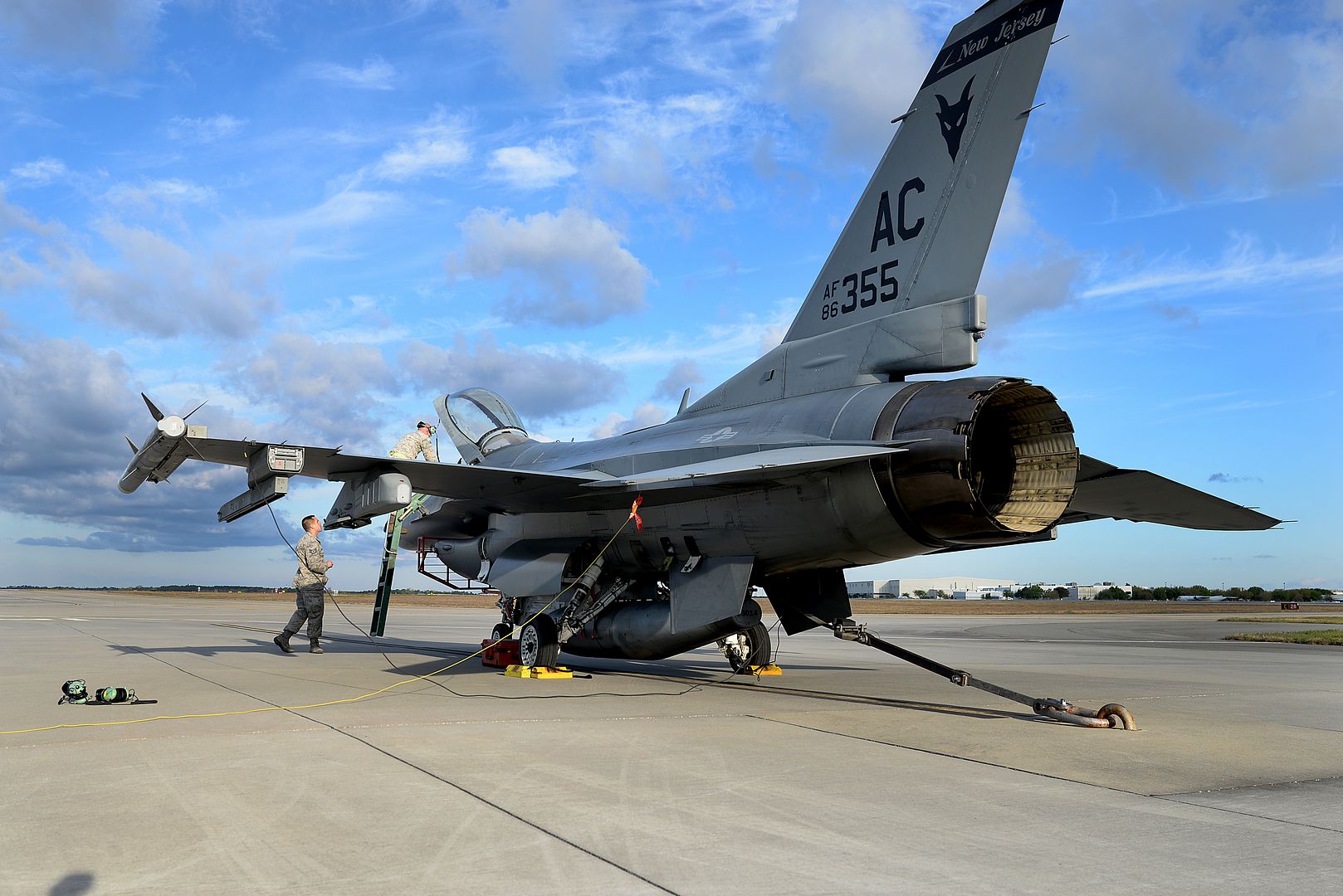
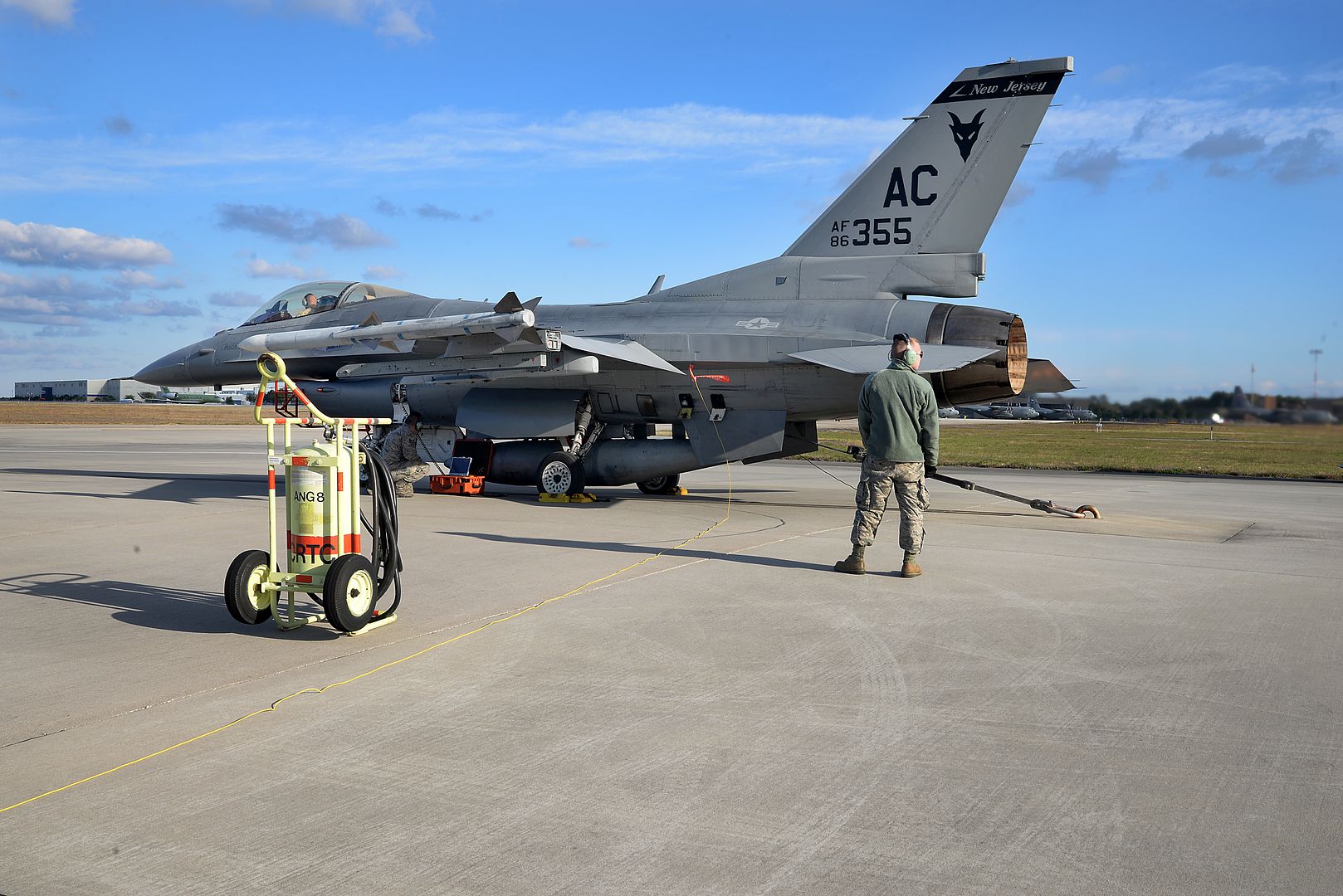
U.S. Air Force fighter pilots with the 177th Fighter Wing, New Jersey Air National Guard, prepare their F-16C Fighting Falcons for flight at the Air Dominance Center in Savannah, Georgia, March 13, 2018. The 177th FW participated in an air-to-air training exercise to sharpen air combat capabilities and accomplish multiple training upgrades. (U.S. Air National Guard photo by Senior Airman Cristina J. Allen)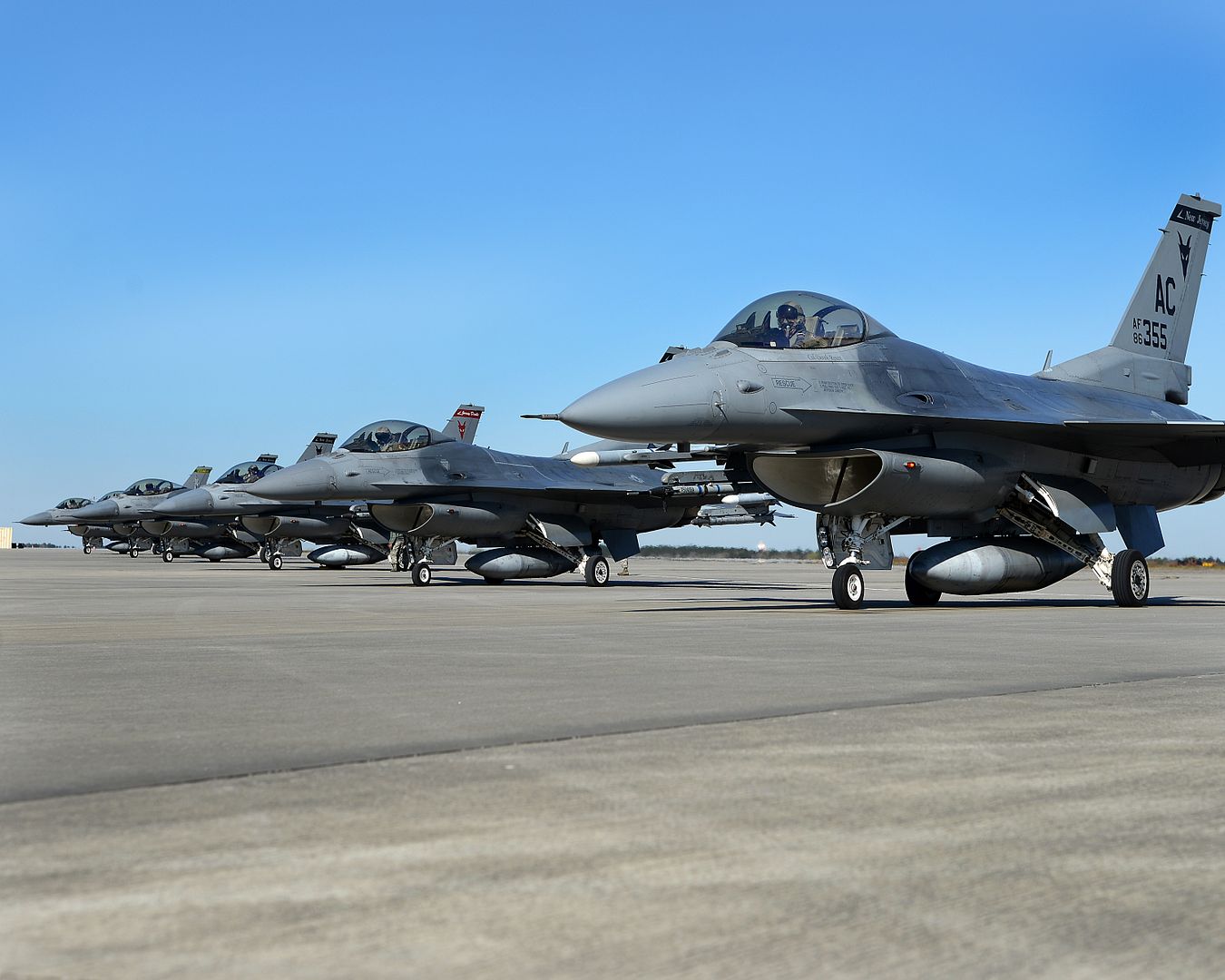
SEATTLE, March 21, 2018 /PRNewswire/ -- Boeing [NYSE: BA] and the Lion Air Group today celebrated the very first 737 MAX 9 to be delivered. The airplane will go into service with Thai Lion Air, where its added capacity will help the airline launch several international routes.
Boeing delivered its very first 737 MAX 9 to Thai Lion Air. The MAX 9's extra capacity will help the airline add several international routes.
"The 737 MAX 9 is a perfect fit for our growing business in Thailand," said Capt. Darsito Hendro Seputro, CEO and Chairman of Thai Lion Air. "The 737 has been the backbone of our business since we began and we will use the added capacity the airplane provides to expand our network and start additional routes to Bangladesh, China and India."
The Lion Air Group is the launch customer for the MAX 9. They were also the first operator to put the MAX 8 into service, and have announced a commitment for 50 MAX 10s. The Group also has an additional 200 737 MAXs on order and is one of the world's largest operators of the 737.
"The Lion Air Group is the perfect example of how the 737 MAX family provides a common fleet solution across the single-aisle spectrum," said Boeing Commercial Airplanes president and CEO Kevin McAllister. "Not only will Lion Air Group benefit from the MAX's range and capacity, they will enjoy the best economics and reliability in the industry."
The 737 MAX 9 is designed for a capacity of up to 220 passengers and a maximum range of 3,550 nautical miles. With three additional seat rows compared to the 737 MAX 8, this airplane provides operators added capacity while maximizing profitability within their network.
The 737 MAX family is designed to offer customers exceptional performance, with lower per-seat costs and an extended range that is opening up new destinations in the single-aisle market. The 737 MAX incorporates the latest CFM International LEAP-1B engines, Advanced Technology winglets, Boeing Sky Interior, large flight deck displays and other features to deliver the highest efficiency, reliability and passenger comfort in the single-aisle market.
The 737 MAX is the fastest-selling airplane in Boeing history, accumulating more than 4,300 orders from 95 customers worldwide. For more information and feature content, visit www.boeing.com/commercial/737max.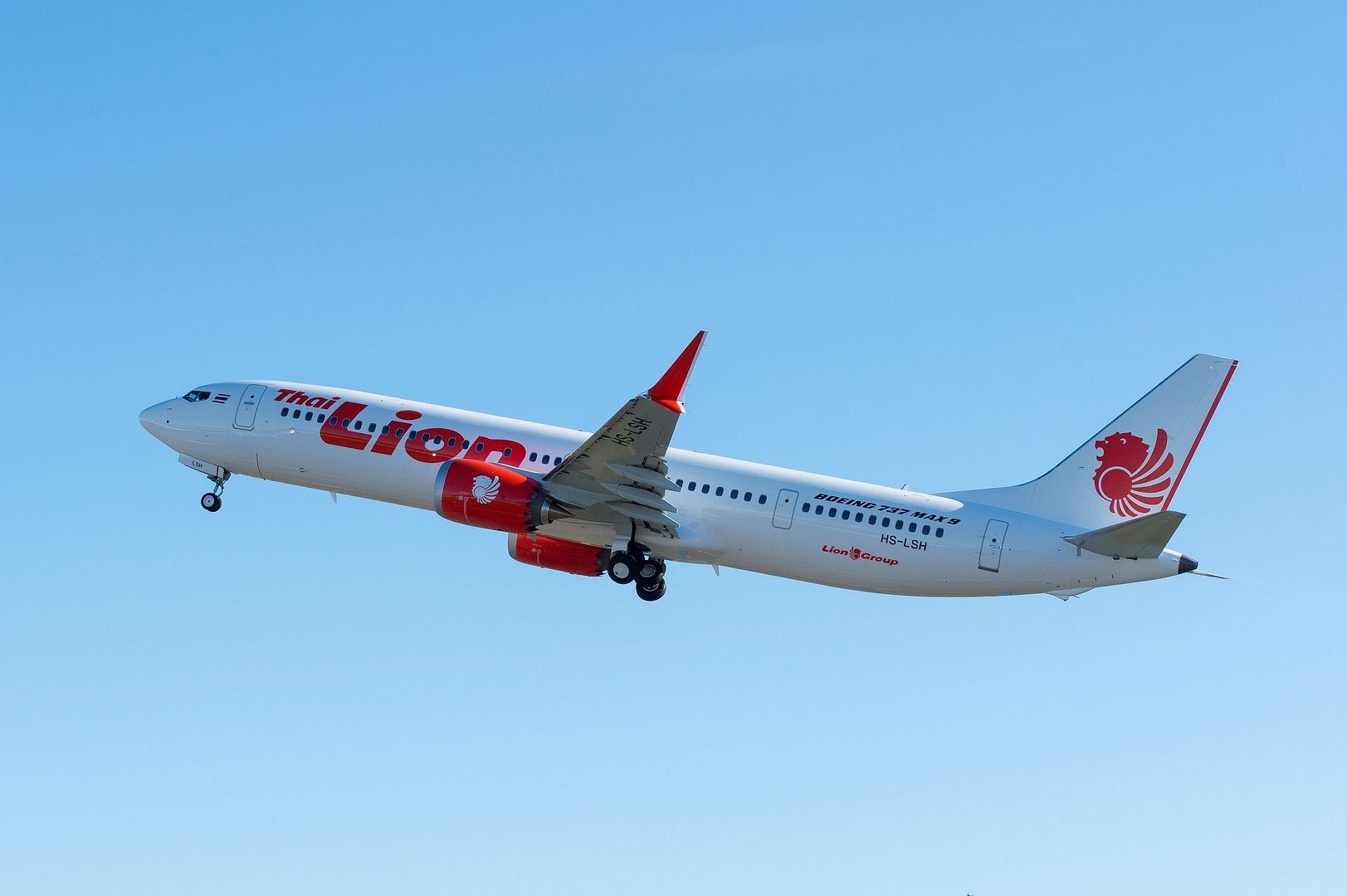
-
 Main AdminAn F-15C Eagle from the 44th Fighter Squadron, Kadena Air Base, takes off during COPE TIGER 2018 from Korat Air Base, Thailand, March 20, 2018. Cope Tiger 2018 is a Pacific Air Forces-sponsored, joint trilateral field training exercise involving Thai, Singaporean and U.S. military forces. Its purpose is to reinforce our already strong relationships by improving combined readiness and interoperability among military partners in the Indo-Pacific region. (U.S. Air Force photo by Tech. Sgt. Steven R. Doty)
Main AdminAn F-15C Eagle from the 44th Fighter Squadron, Kadena Air Base, takes off during COPE TIGER 2018 from Korat Air Base, Thailand, March 20, 2018. Cope Tiger 2018 is a Pacific Air Forces-sponsored, joint trilateral field training exercise involving Thai, Singaporean and U.S. military forces. Its purpose is to reinforce our already strong relationships by improving combined readiness and interoperability among military partners in the Indo-Pacific region. (U.S. Air Force photo by Tech. Sgt. Steven R. Doty)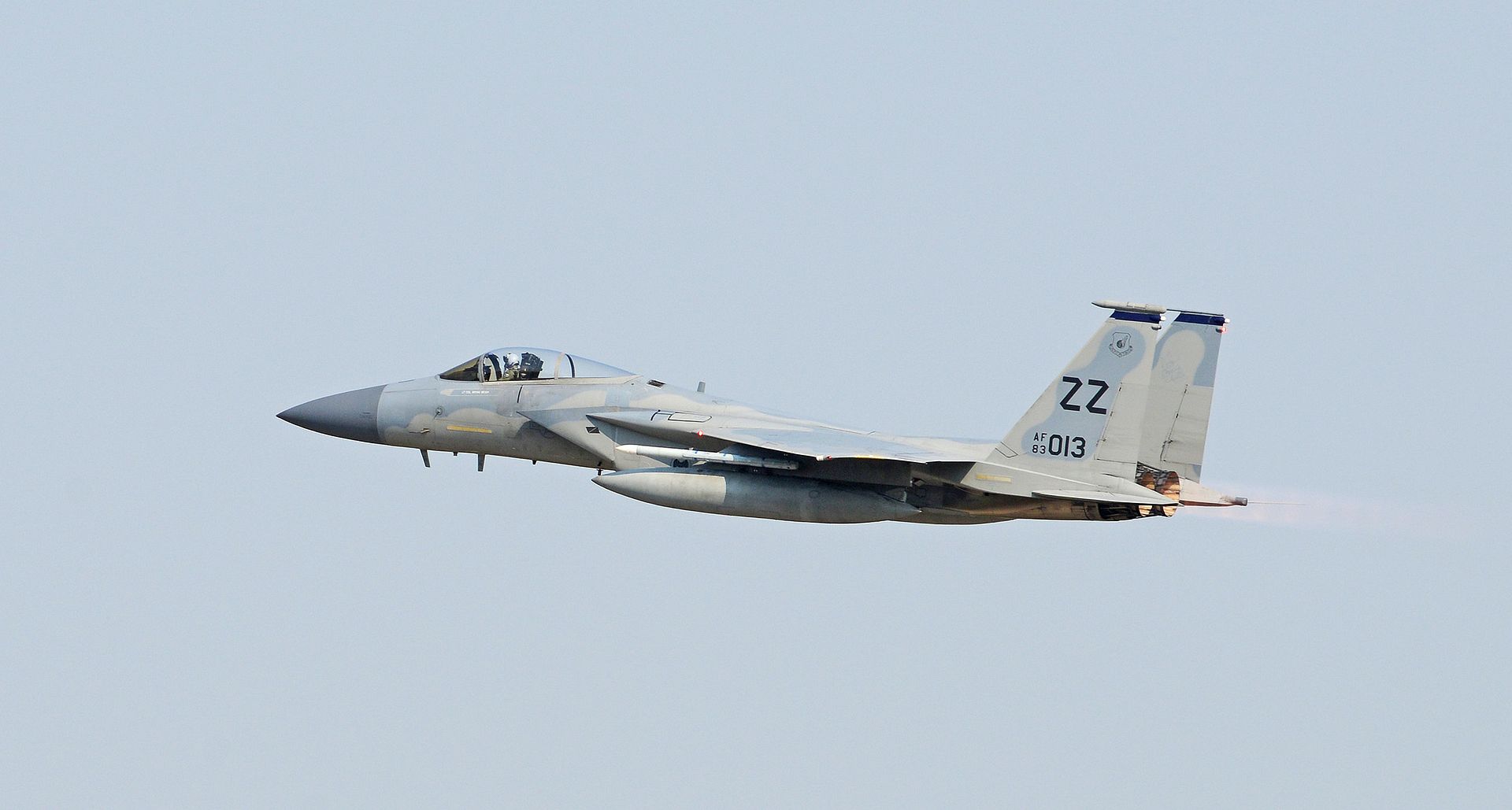
Pilots and maintainers with the 149 Squadron, Republic of Singapore Air Force, complete final check on an F-15SG during COPE TIGER 2018, Korat Air Base, Thailand, March 12, 2018. The annual Cope Tiger exercise series demonstrates the U.S. commitment to our partners and the region and to addressing regional security challenges and ensuring freedom of navigation through multilateral collaboration. (U.S. Air Force photo by Tech. Sgt. Steven R. Doty)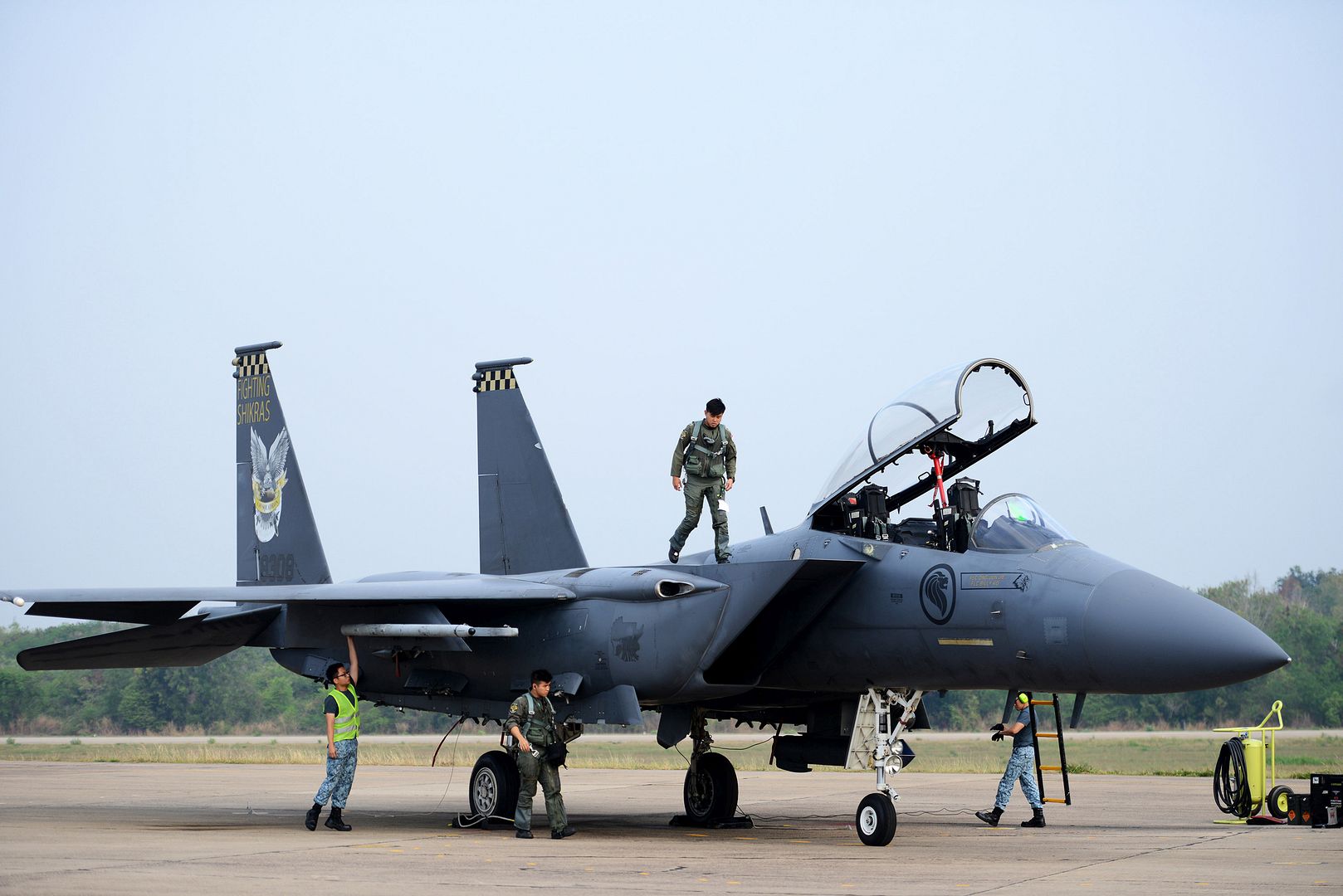
Maintainers with the 149 Squadron, Republic of Singapore Air Force, prepare to marshal an F-15SG during COPE TIGER 2018, Korat Air Base, Thailand, March 12, 2018. Approximately 100 U.S. personnel will participate in the exercise along with approximately 1,000 service members from Thailand and Singapore. The trilateral exercise will involve a combined total of 67 aircraft and from the three participating countries. (U.S. Air Force photo by Tech. Sgt. Steven R. Doty)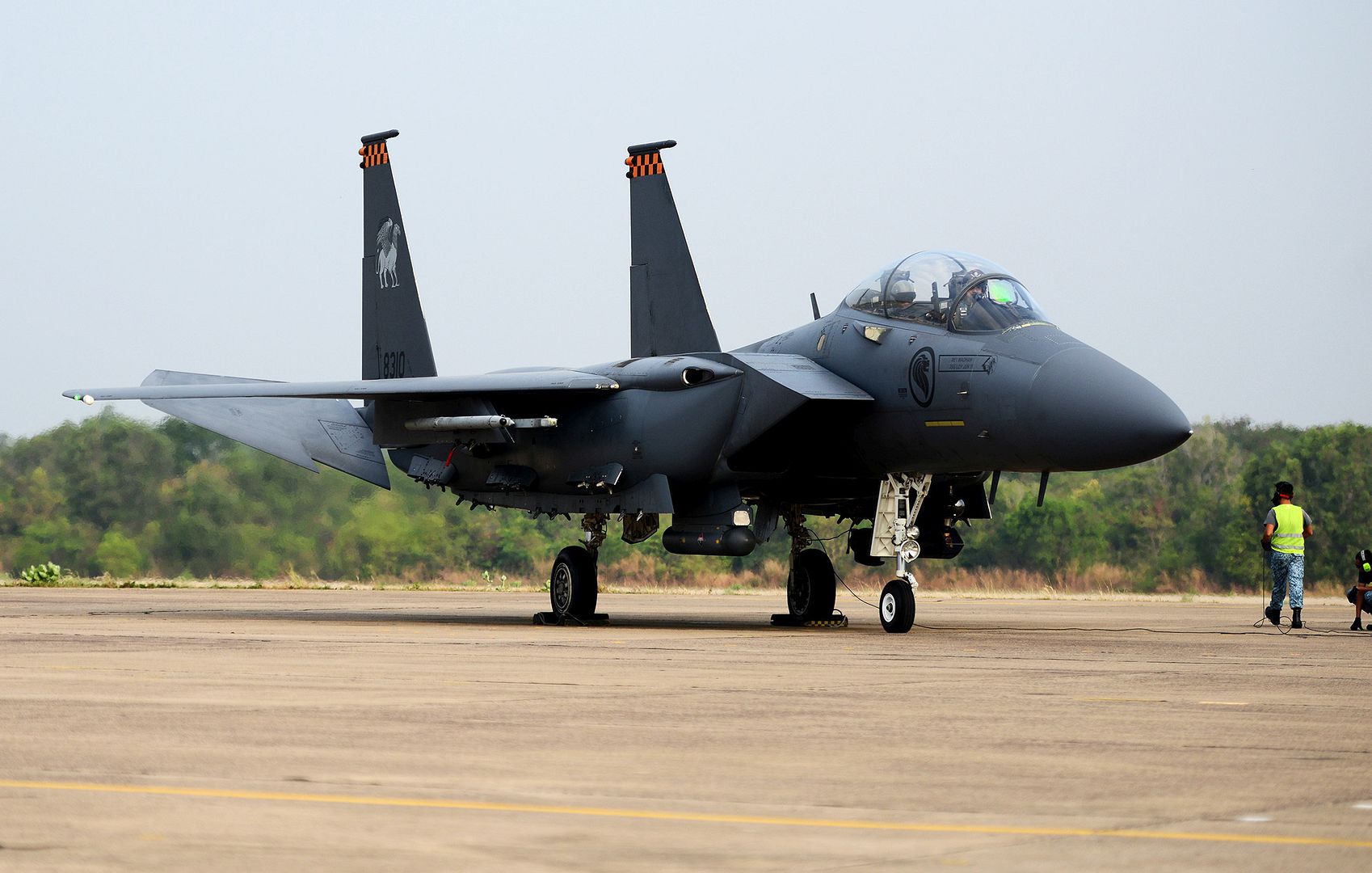
A Royal Netherlands Air Force F-16 prepares to receive fuel from a U.S. Air Force KC-135 Stratotanker during an aerial refueling training mission March 21, 2018, over the Netherlands. The F-16 flew in a formation with U.S. Air Force F-15C Eagles from the 142nd Fighter Wing, Portland, Oregon, operating from Leeuwarden Air Base, Netherlands, as part of a Theater Security Package in support of Operation Atlantic Resolve. (U.S. Air Force photo by Senior Airman Luke Milano)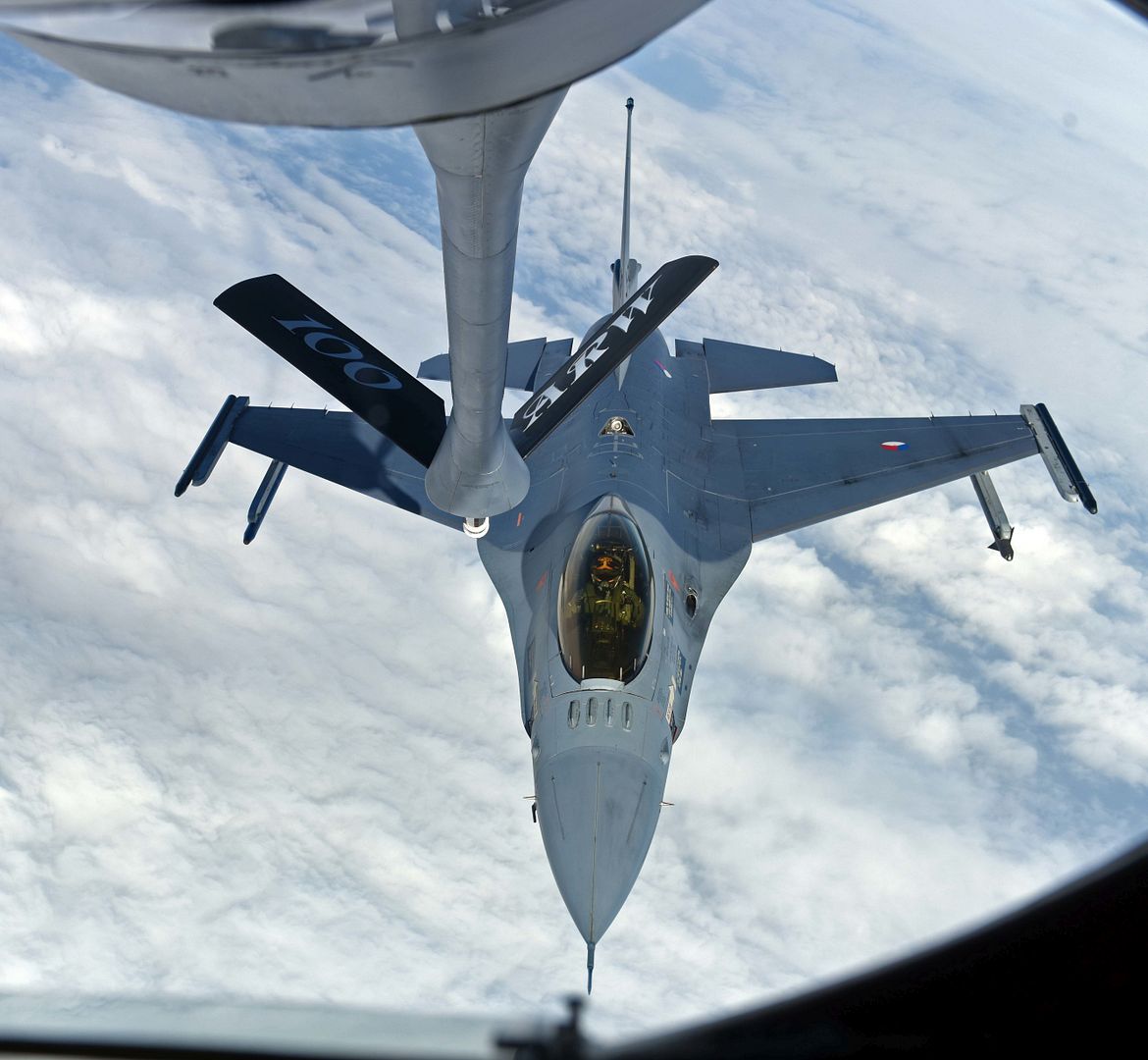
A Royal Netherlands Air Force F-16 and U.S. Air Force F-15C Eagles fly in formation together behind a U.S. Air Force KC-135 Stratotanker during an aerial refueling training mission March 21, 2018, over the Netherlands. Nearly 260 Airmen from the 142nd Fighter Wing deployed with F-15Cs operating from Leeuwarden Air Base, Netherlands, as part of a Theater Security Package in support of Operation Atlantic Resolve. (U.S. Air Force photo by Senior Airman Luke Milano)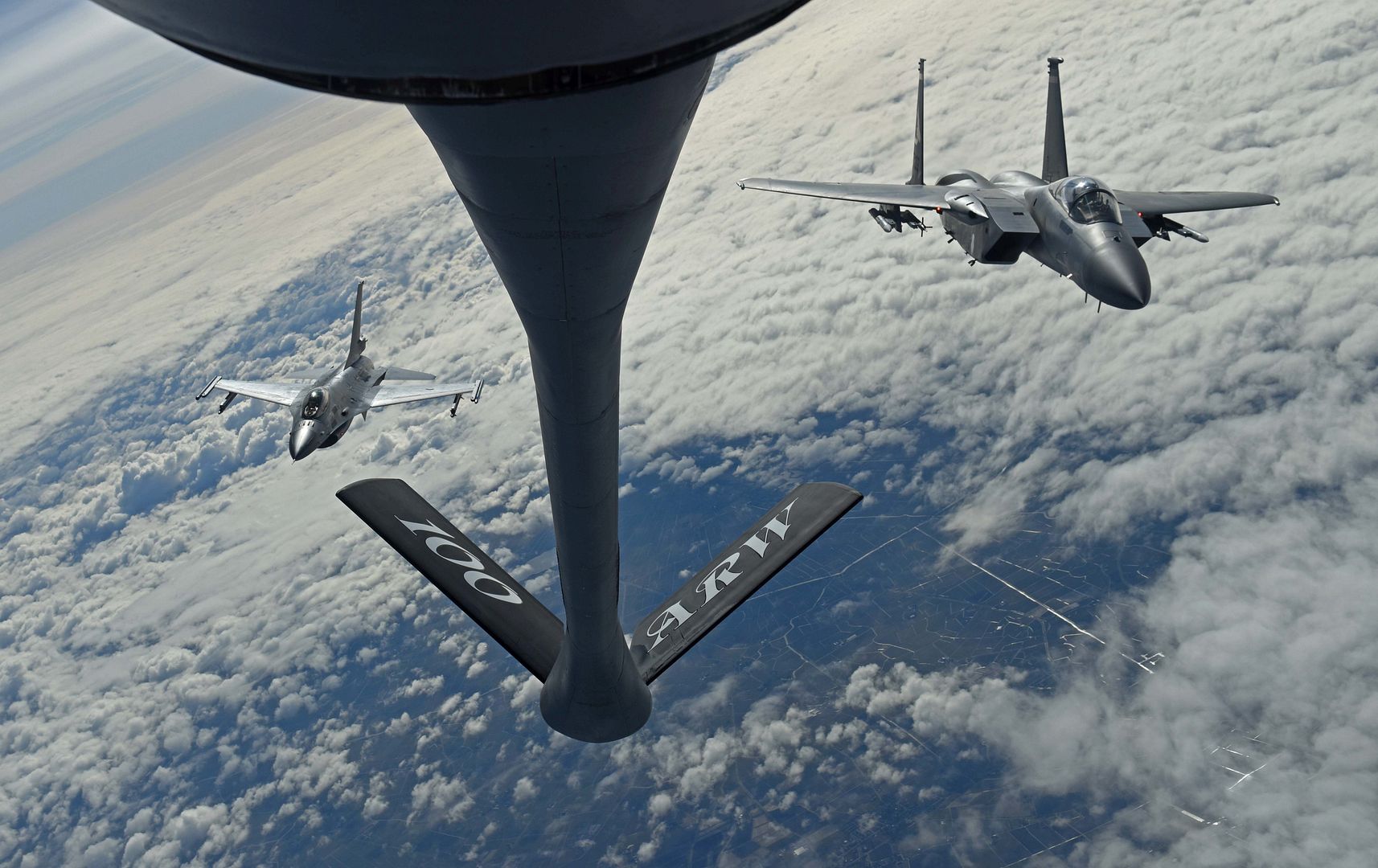
An AH-64D Apache Longbow helicopter assigned to 1st Battalion, 3rd Aviation Regiment, 12th Combat Aviation Brigade, supports Company A, 2nd Battalion, 503rd Infantry Regiment, 173rd Airborne Brigade during a combined arm life fire exercise (CALFEX) at the 7th Army Training Command?s Grafenwoehr Training Area, Germany, March 20, 2018. (U.S. Army photo's by Georgios Moumoulidis)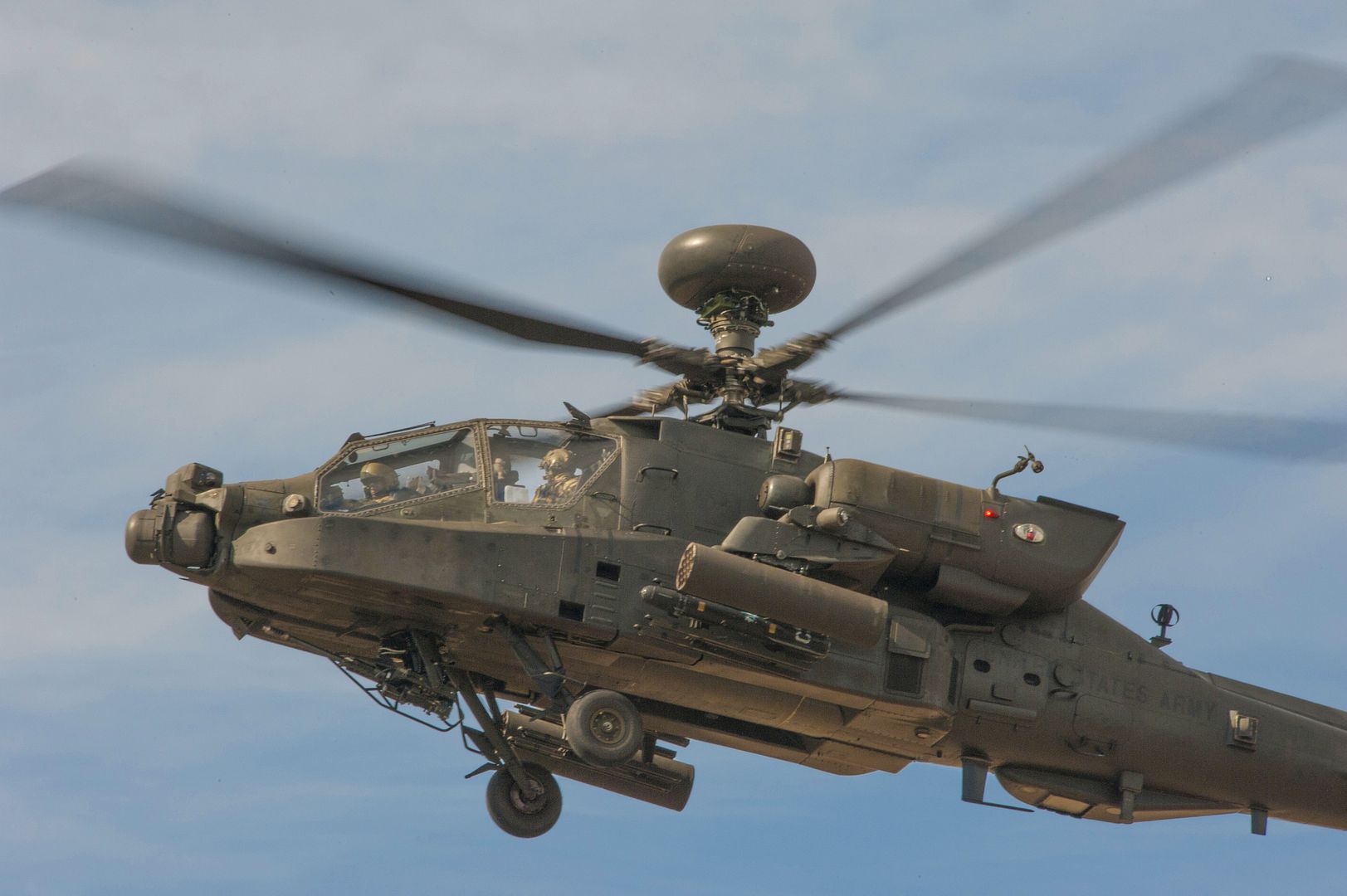
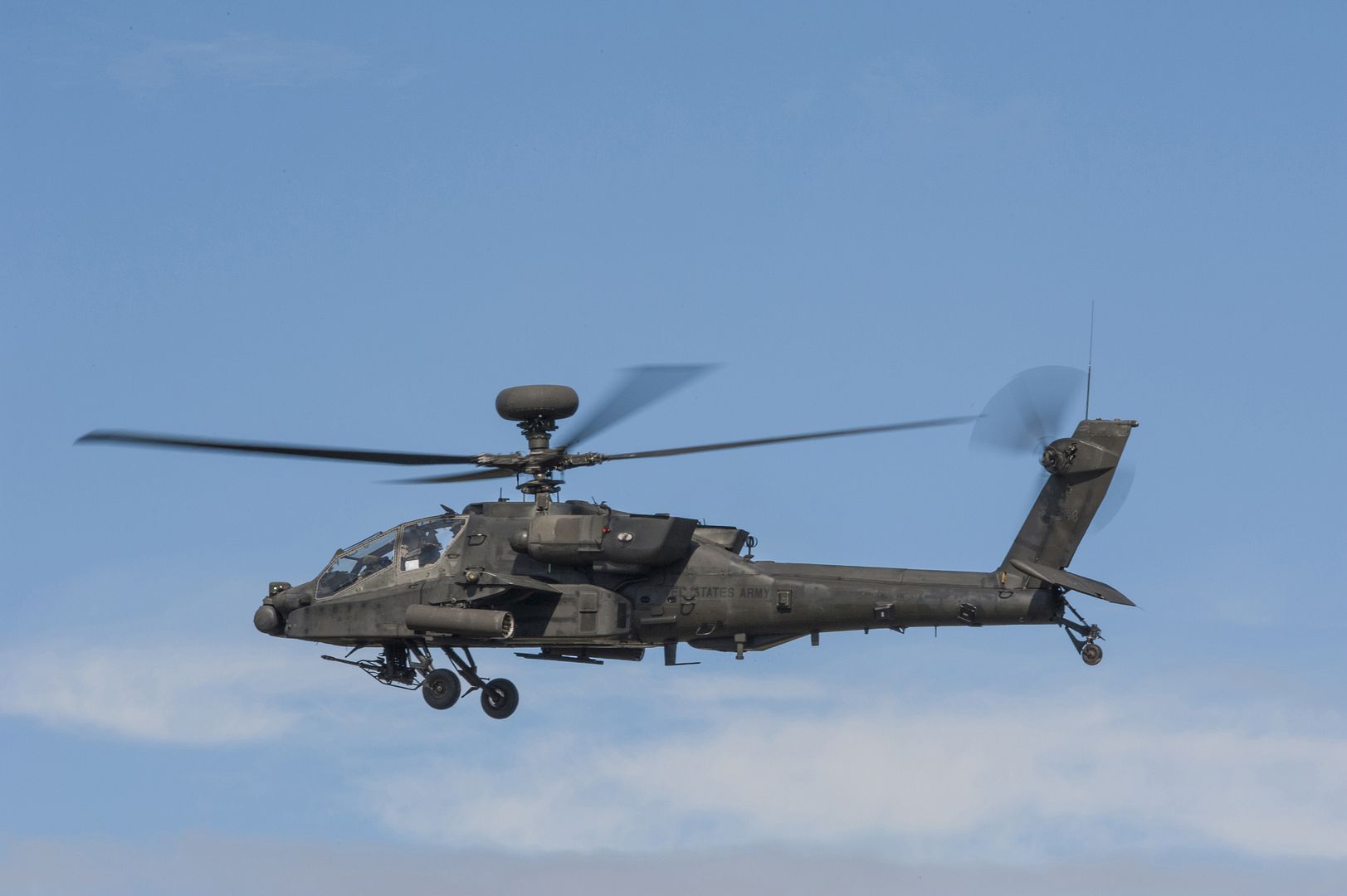
PACIFIC OCEAN (March 20, 2018) An F/A-18C Hornet assigned to the Blue Blasters of Strike Fighter Squadron (VFA) 34 makes an arrested landing on the flight deck of Nimitz-class aircraft carrier USS Carl Vinson (CVN 70). Carl Vinson Strike Group is currently operating in the Western Pacific as part of a regularly scheduled deployment. (U.S. Navy photo by Mass Communication Specialist 3rd Class Dylan M. Kinee/Released)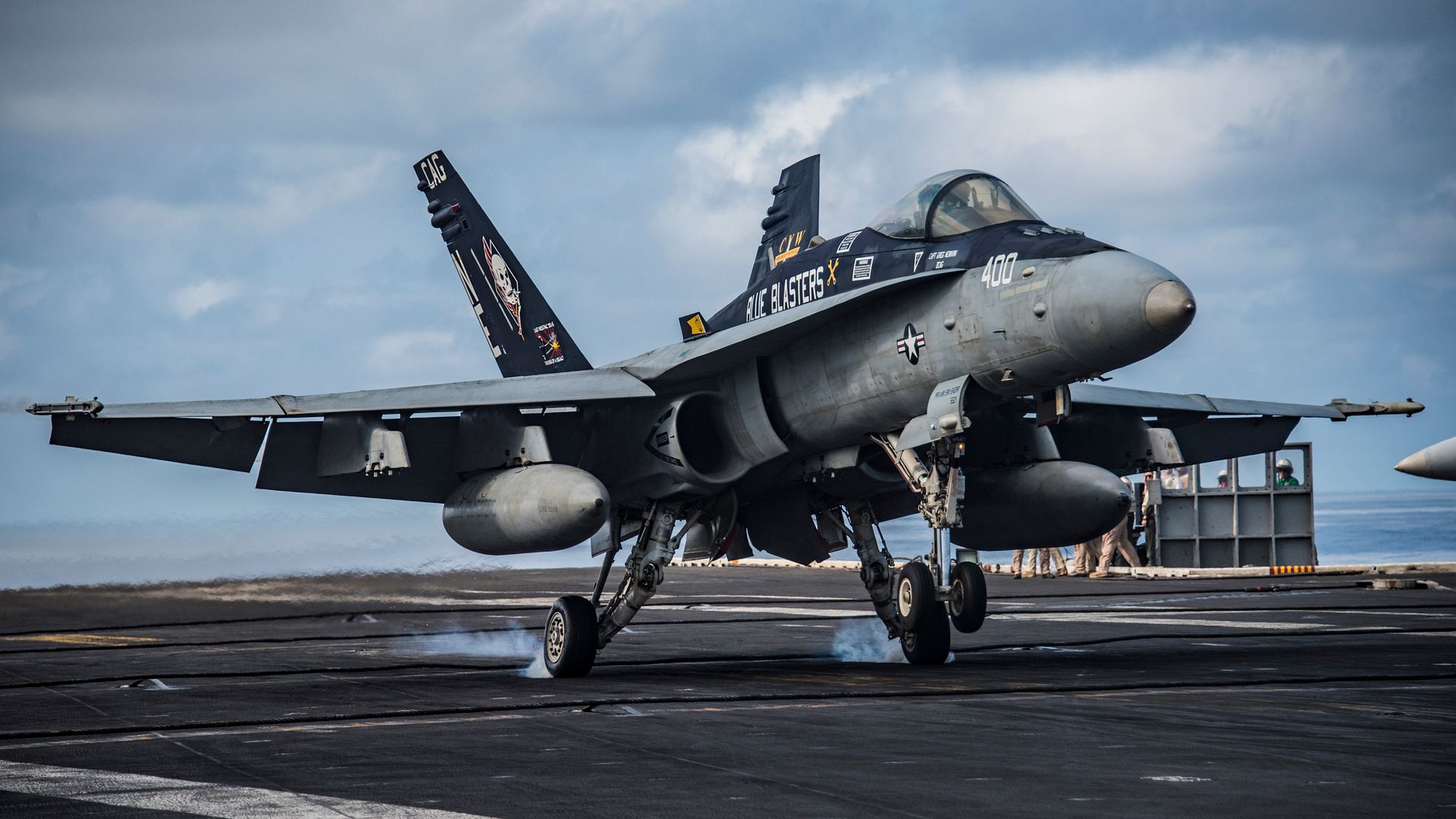
Seville, 22 March 2018 ? Airbus has for the first time formally delivered two A400M new generation airlifters to two different nations in one day. The company handed over the aircraft on 20 March to the European Organisation for Joint Armament Cooperation (OCCAR), in charge of the management of the A400M Programme, representing Germany and France ? at a ceremony in Seville, Spain. OCCAR Director Arturo Alfonso-Meiri?o said: ?It is a great pleasure to see two of the leading OCCAR nations receiving these superb aircraft on the same day in a year when the organisation is itself celebrating the 20th anniversary of the signature of its Convention. This is testimony to the effective work performed by OCCAR?s A400M team over many years in managing this exceptionally complex programme.? These latest deliveries were the 60th and 61st A400Ms to be handed over and take the German and French fleets to 18 and 14 aircraft respectively.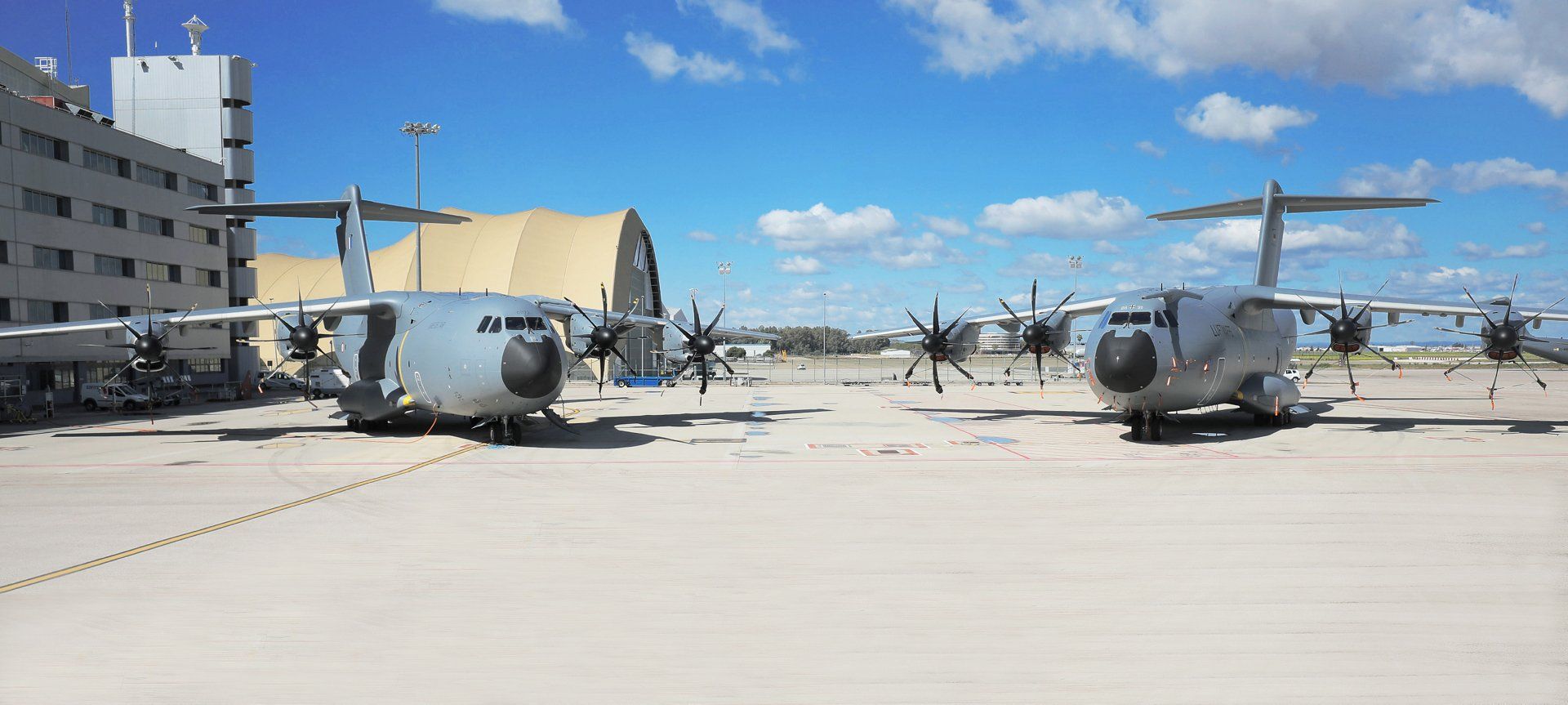
The photo shows the Airbus and OCCAR delivery teams, and French and German crews in front of the two aircraft following the official handover ceremony.
-
 Main AdminU.S. 5TH FLEET AREA OF OPERATIONS (March 22, 2018) An FA-18E Super Hornet, assigned to the Stingers of Strike Fighter Attack Squadron (VFA) 113, flies over the aircraft carrier USS Theodore Roosevelt (CVN 71). Theodore Roosevelt and its carrier strike group are deployed to the U.S. 5th Fleet area of operations in support of maritime security operations to reassure allies and partners and preserve the freedom of navigation and the free flow of commerce in the region. (U.S. Navy photo by Mass Communication Specialist Seaman Michael A. Colemanberry/Released)
Main AdminU.S. 5TH FLEET AREA OF OPERATIONS (March 22, 2018) An FA-18E Super Hornet, assigned to the Stingers of Strike Fighter Attack Squadron (VFA) 113, flies over the aircraft carrier USS Theodore Roosevelt (CVN 71). Theodore Roosevelt and its carrier strike group are deployed to the U.S. 5th Fleet area of operations in support of maritime security operations to reassure allies and partners and preserve the freedom of navigation and the free flow of commerce in the region. (U.S. Navy photo by Mass Communication Specialist Seaman Michael A. Colemanberry/Released)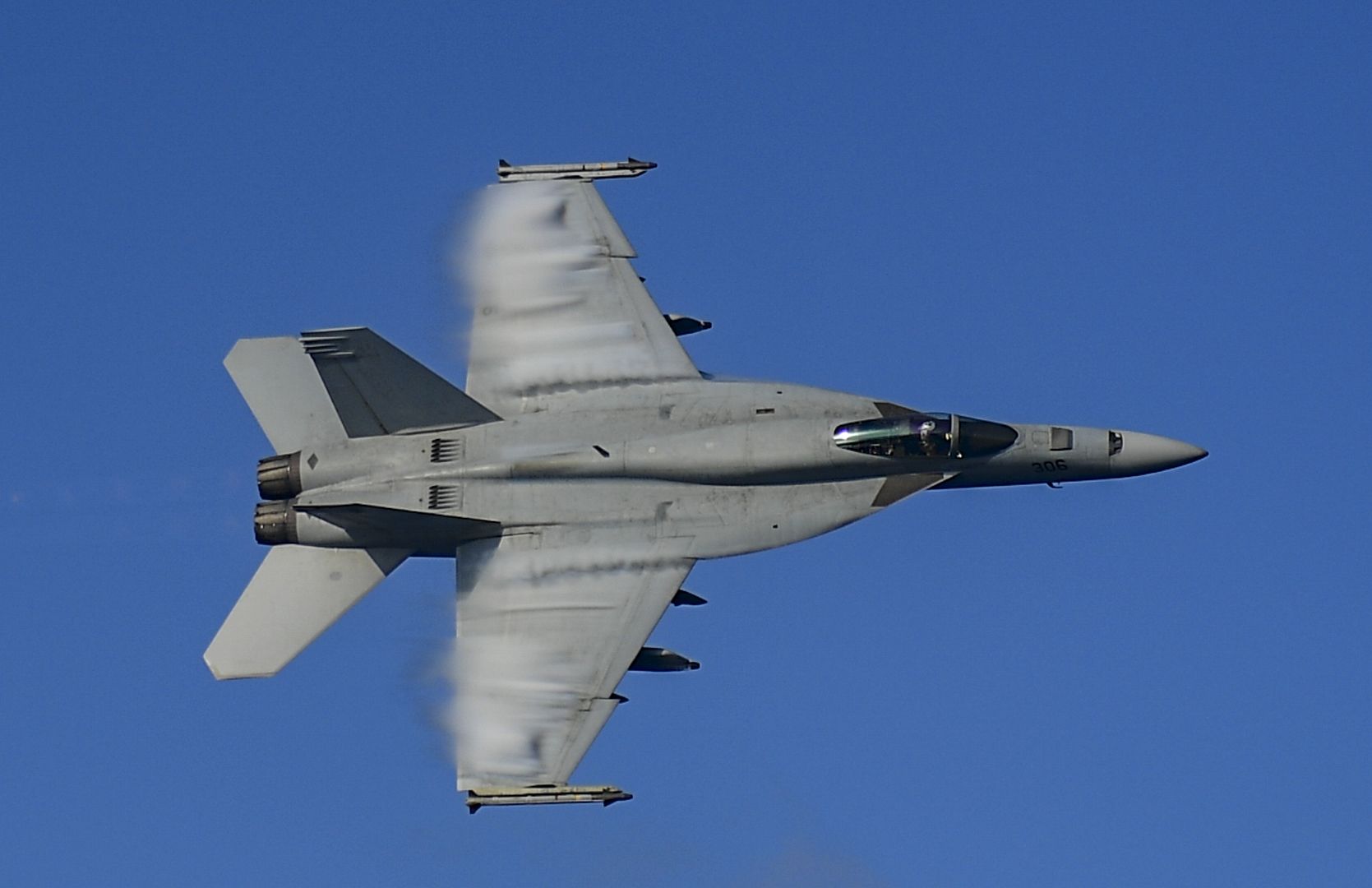
U.S. 5TH FLEET AREA OF OPERATIONS (March 22, 2018) An F/A-18F Super Hornet, assigned to the Mighty Shrikes of Strike Fighter Attack Squadron (VFA) 94, approaches the flight deck of the aircraft carrier USS Theodore Roosevelt (CVN 71). Theodore Roosevelt and its carrier strike group are deployed to the U.S. 5th Fleet area of operations in support of maritime security operations to reassure allies and partners and preserve the freedom of navigation and the free flow of commerce in the region. (U.S. Navy photo by Mass Communication Specialist Seaman Michael Hogan/Released)
U.S. 5TH FLEET AREA OF OPERATIONS (March 22, 2018) An F/A-18E Super Hornet, assigned to the Stingers of Strike Fighter Attack Squadron (VFA) 113, lands on the flight deck of the aircraft carrier USS Theodore Roosevelt (CVN 71). Theodore Roosevelt and its carrier strike group are deployed to the U.S. 5th Fleet area of operations in support of maritime security operations to reassure allies and partners and preserve the freedom of navigation and the free flow of commerce in the region. (U.S. Navy photo by Mass Communication Specialist Seaman Michael Hogan/Released)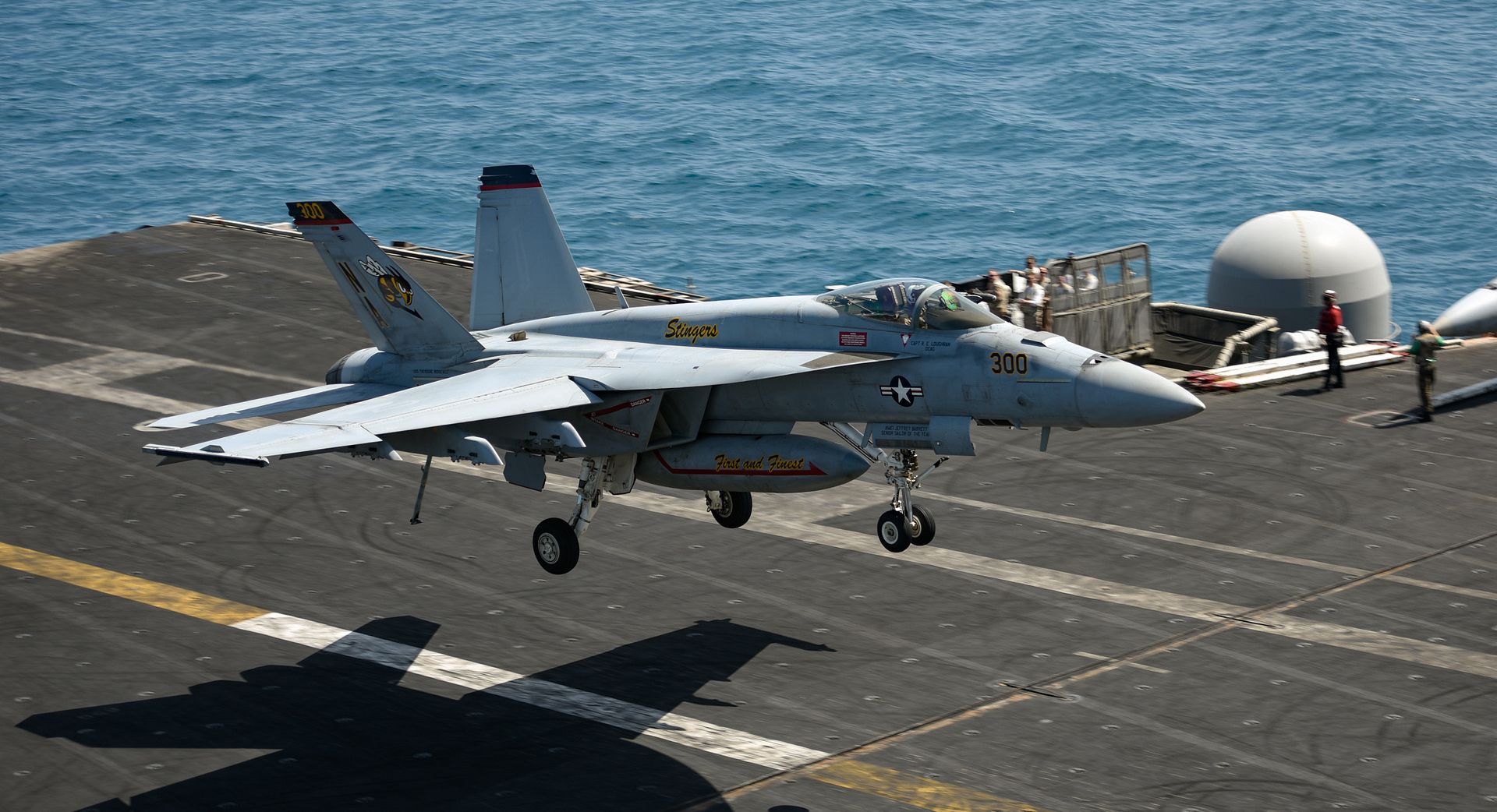
U.S. 5TH FLEET AREA OF OPERATIONS (March 22, 2018) An F/A-18C Hornet, assigned to the Checkerboards of Marine Strike Fighter Attack Squadron (VMFA) 312, flies over the aircraft carrier USS Theodore Roosevelt (CVN 71). Theodore Roosevelt and its carrier strike group are deployed to the U.S. 5th Fleet area of operations in support of maritime security operations to reassure allies and partners and preserve the freedom of navigation and the free flow of commerce in the region. (U.S. Navy photo by Mass Communication Specialist Seaman Michael Hogan/Released)
U.S. Air Force pilots assigned to the 560th Flying Training Squadron fly T-38 Talons in formation for the 45th Freedom Flyer Reunion over Joint Base San Antonio-Randolph, Texas, March 22, 2018. The Freedom Flyer Reunion is an annual celebration recognizing the incredible service of Air Force Prisoners of War during the Vietnam War, their honorable return, and their connection with the 12th Flying Training Wing during Operation Homecoming. (U.S. Air Force photo's by Senior Airman James R. Crow)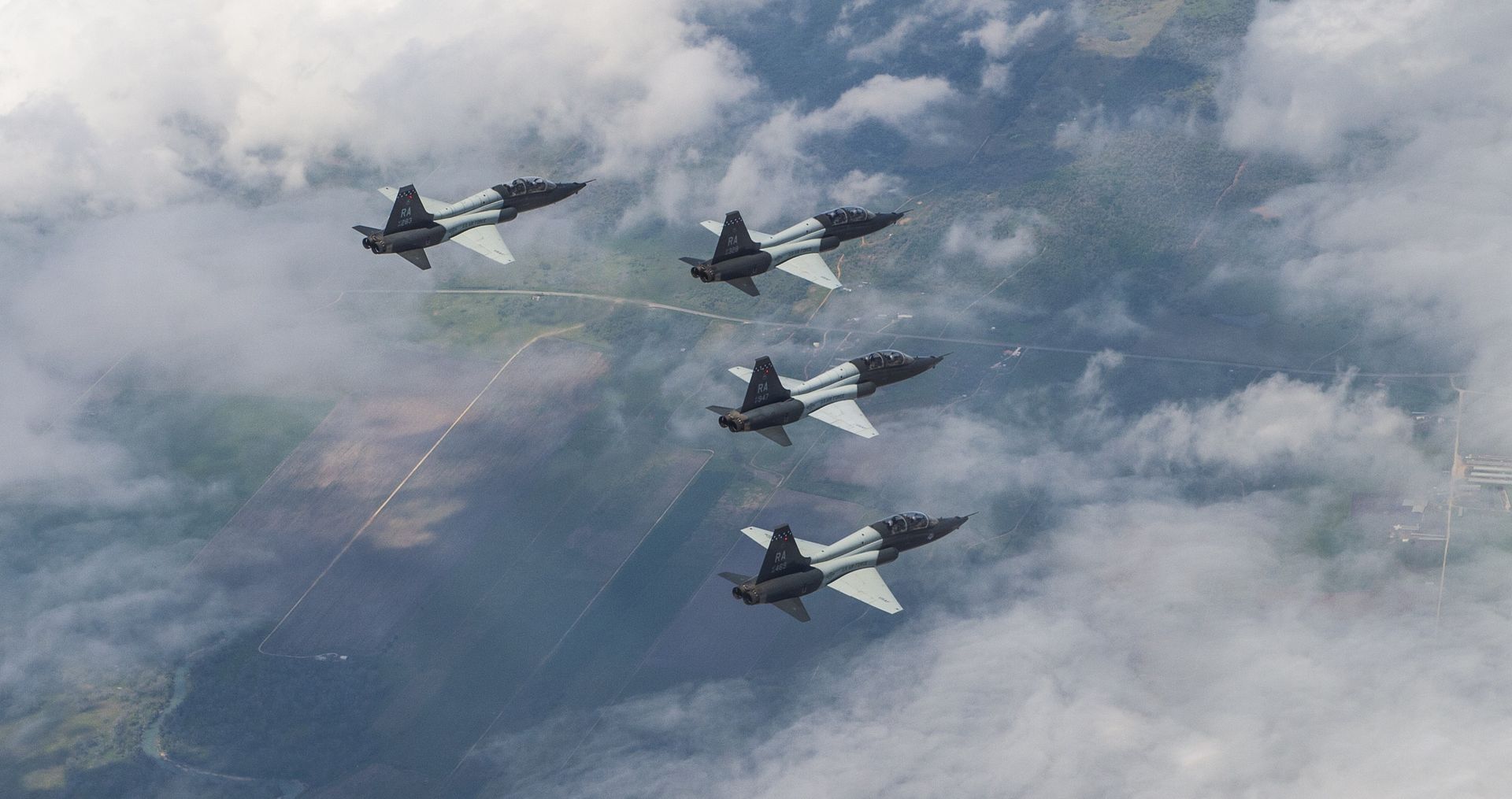
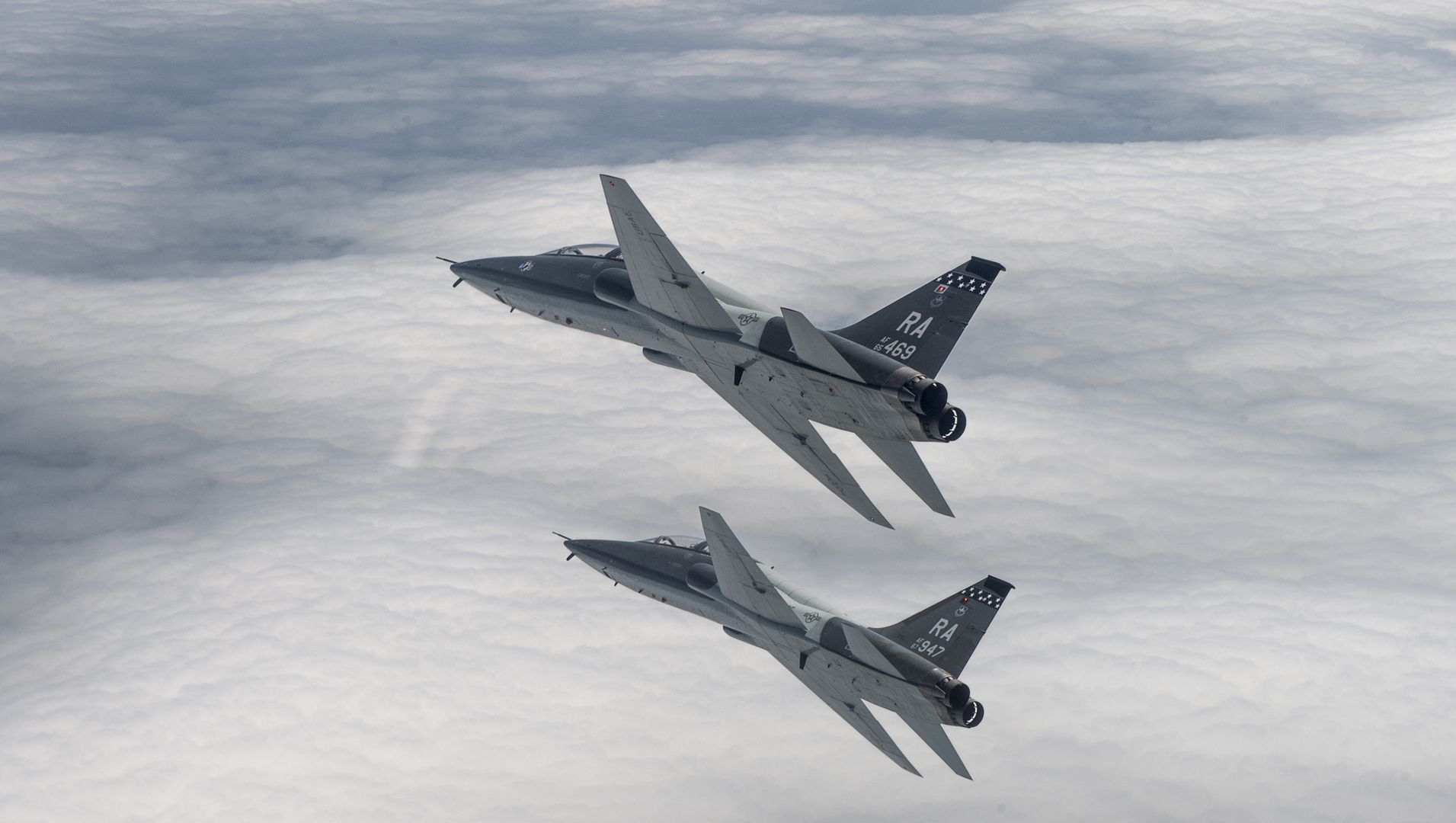
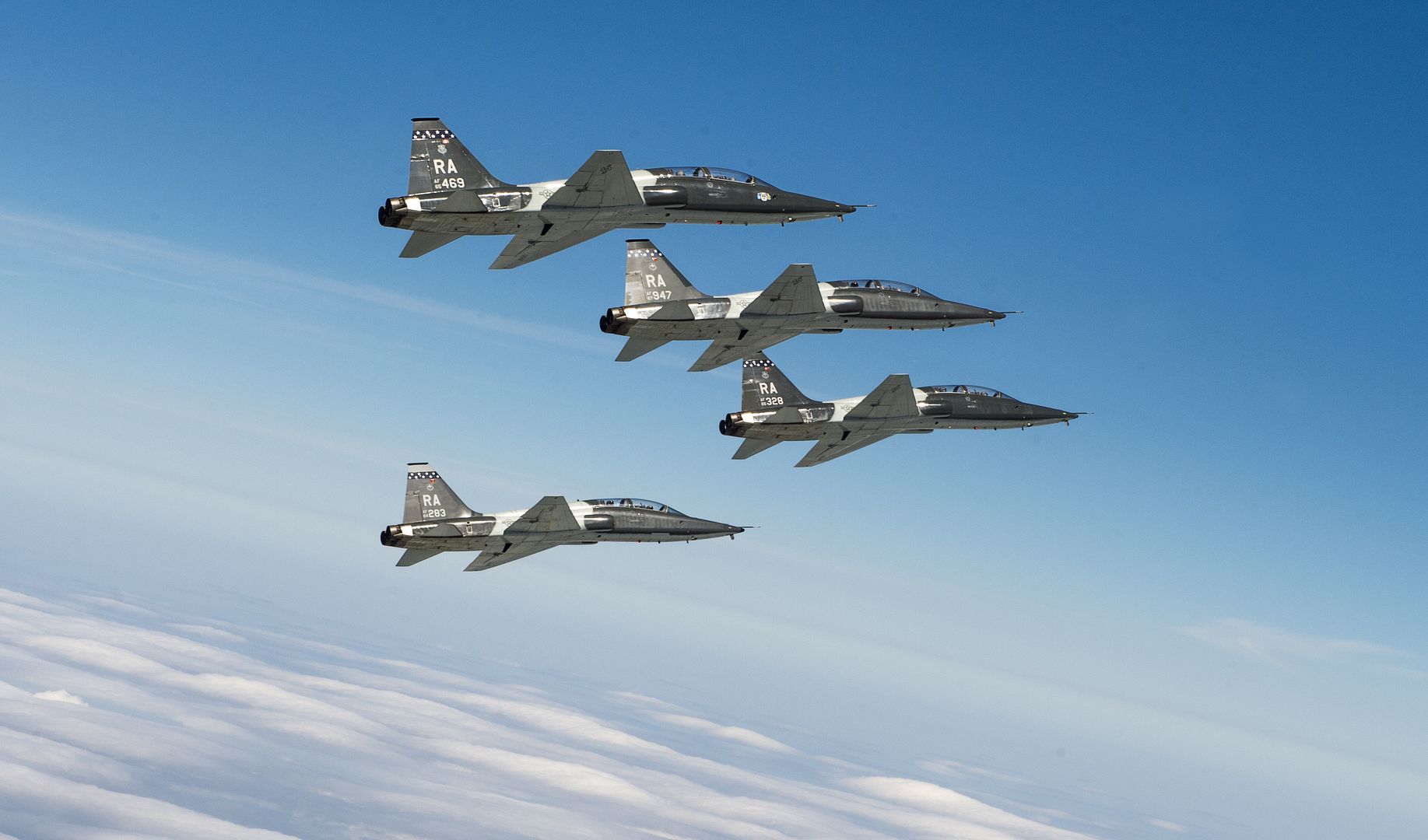
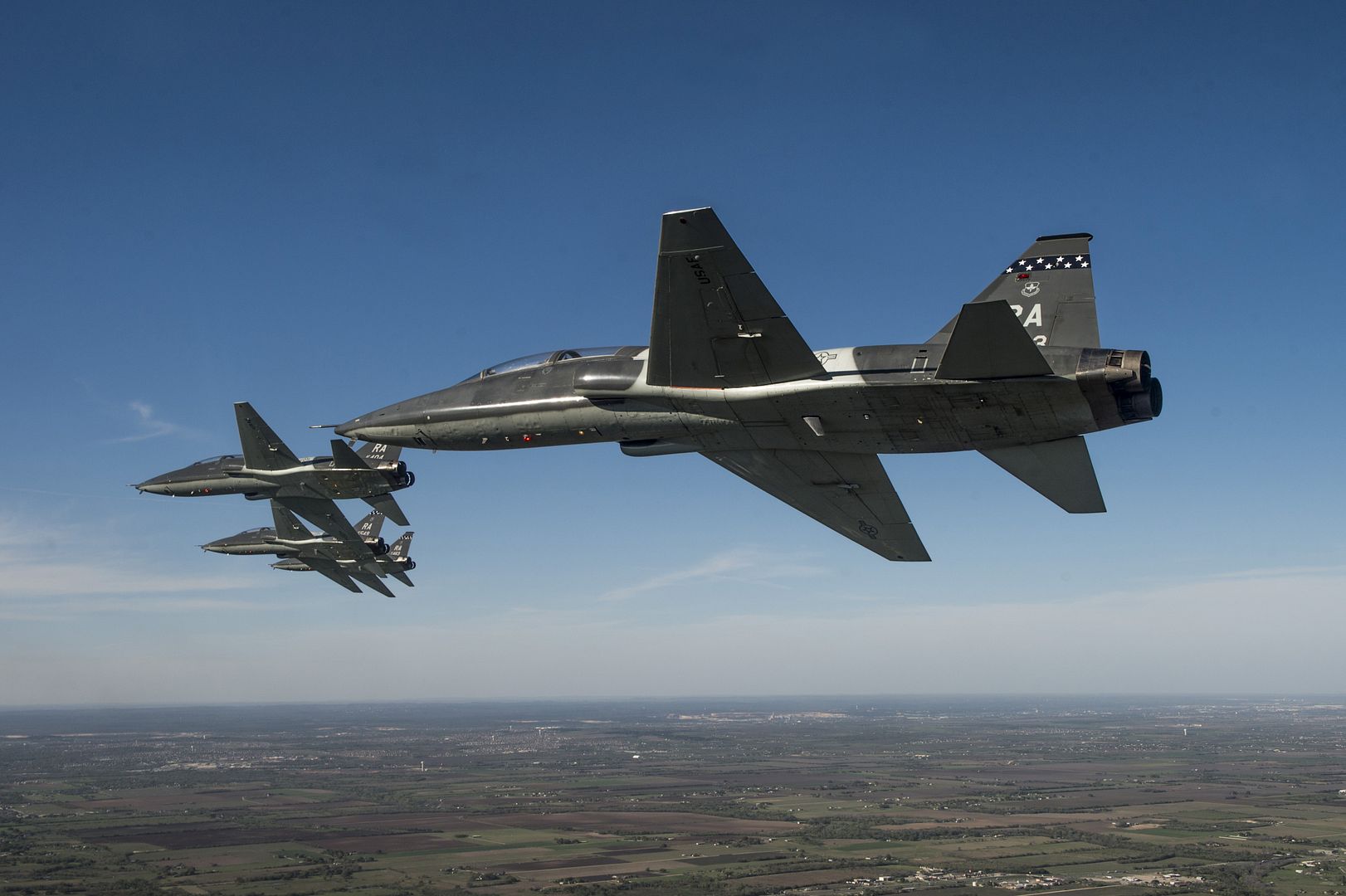

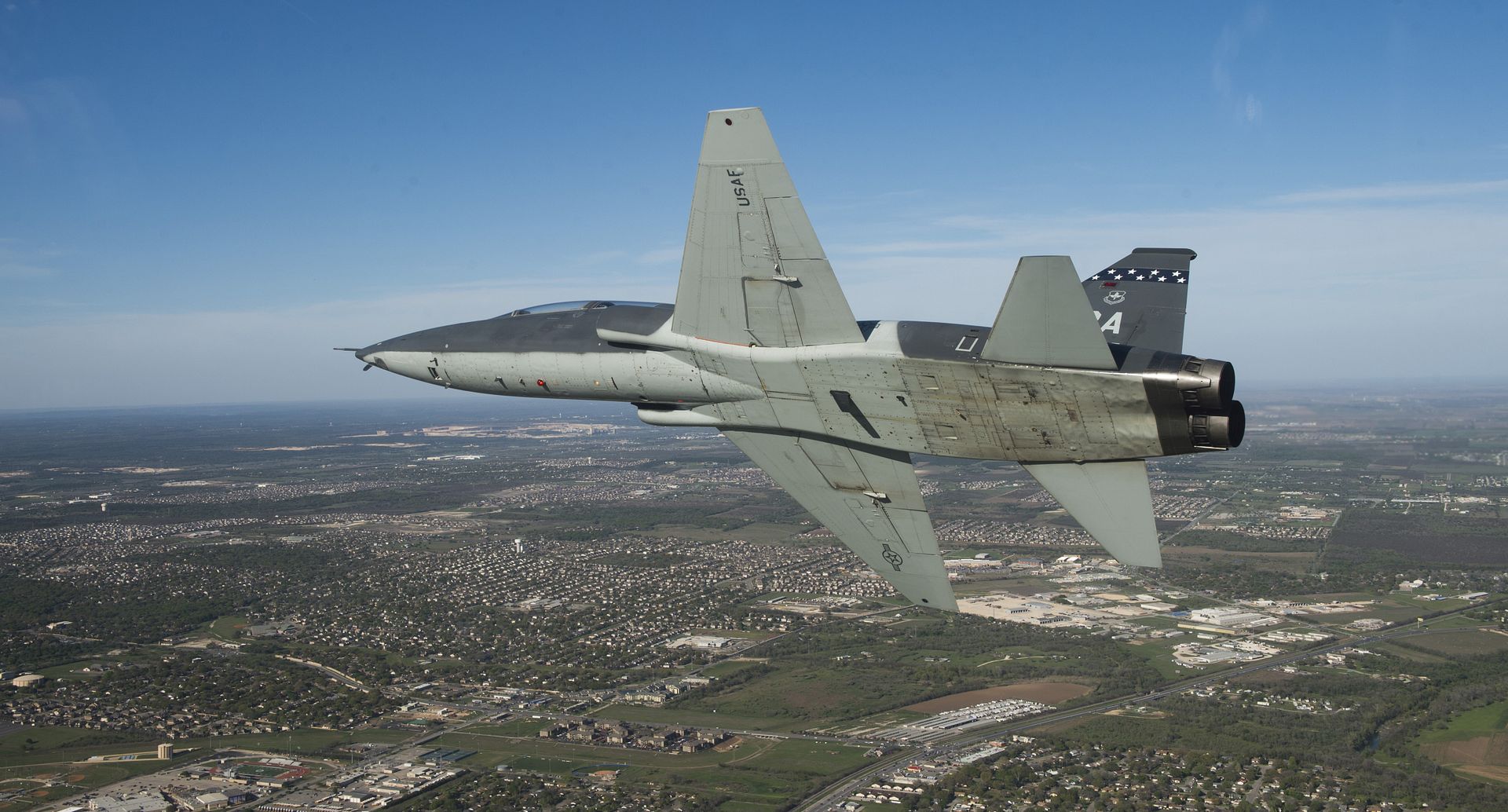
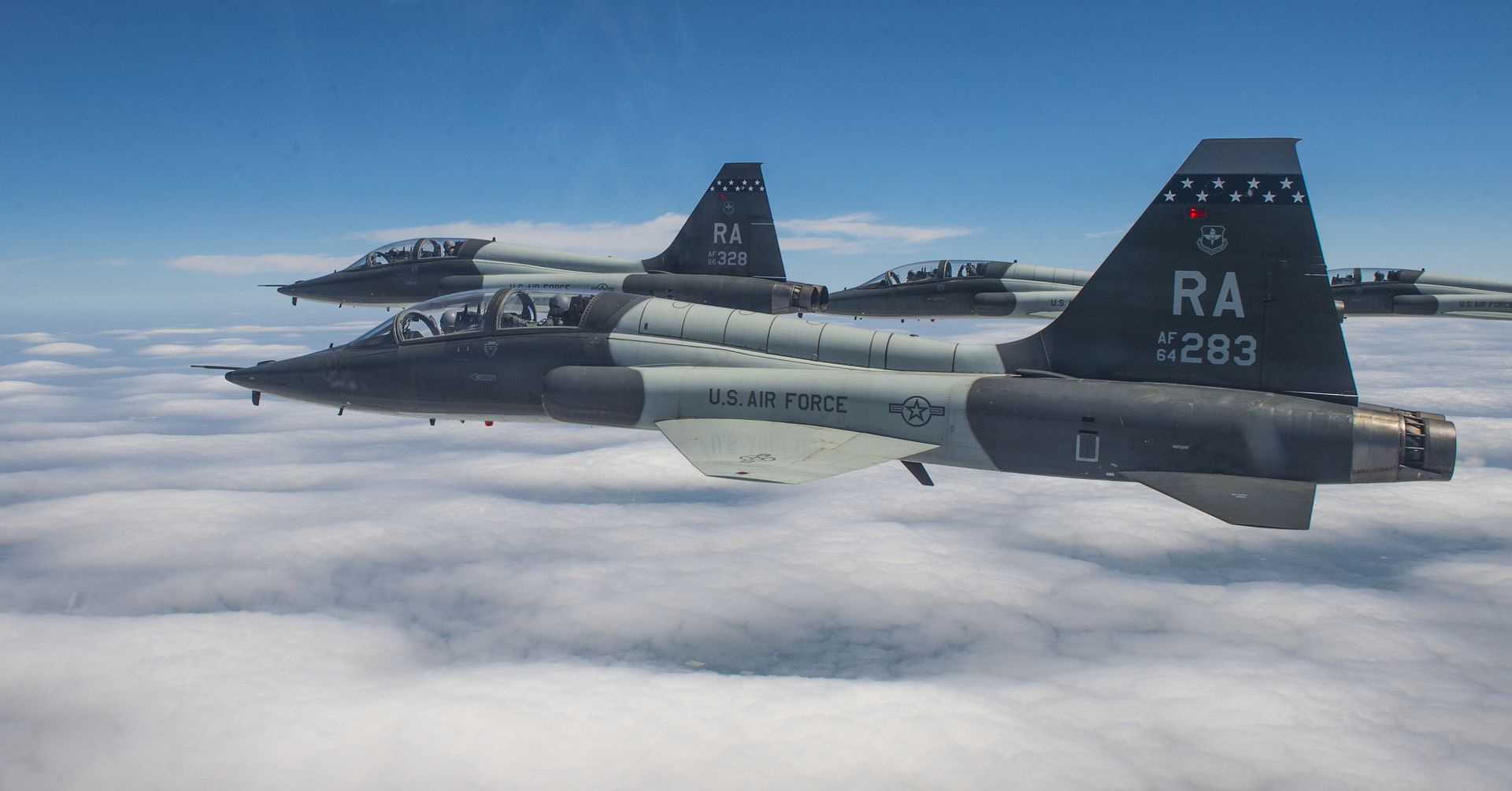
U.S. Air Force pilots assigned to the 560th Flying Training Squadron and the 99th Flying Training Squadron fly T-6 Texans, T-1 Jayhawks and T-38 Talons in a dissimilar formation in preparation for the 45th Annual Freedom Flyer Reunion over Joint Base San Antonio-Randolph, Texas, March 20, 2018. The Freedom Flyer Reunion is an annual celebration recognizing the incredible service of Air Force Prisoners of War during the Vietnam War, their honorable return, and their connection with the 12th Flying Training Wing during Operation Homecoming. (U.S. Air Force photo by Senior Airman James R. Crow)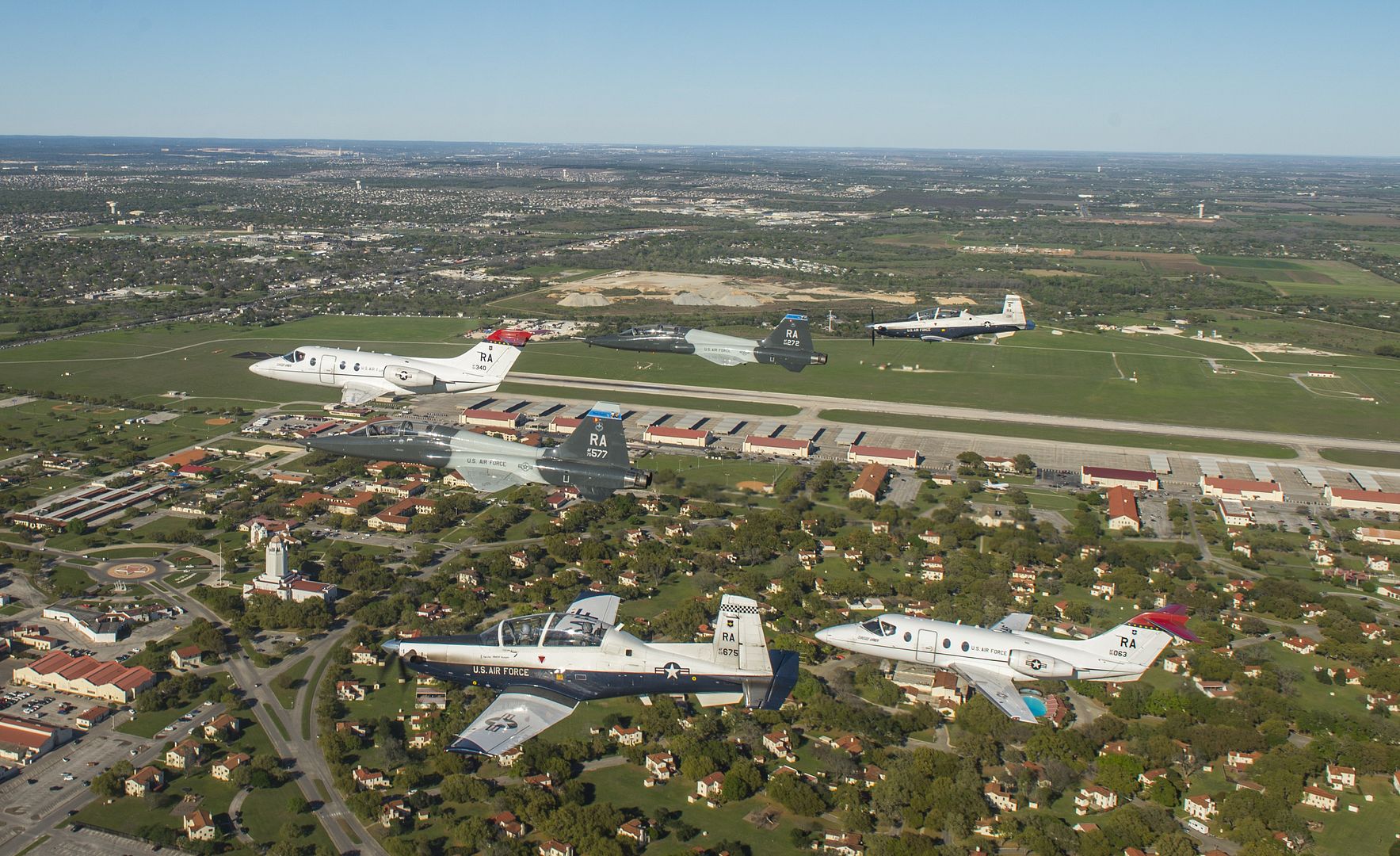
An F-15E Strike Eagle assigned to the 492nd Fighter Squadron, Royal Air Force Lakenheath, England prepares to land at Andravida Air Base, Greece, March 21, 2018, during exercise INIOHOS 18. Seventy-six fighter aircraft are participating in this years? iteration of the exercise. (U.S. Air Force photo/1st Lt. Elias Small)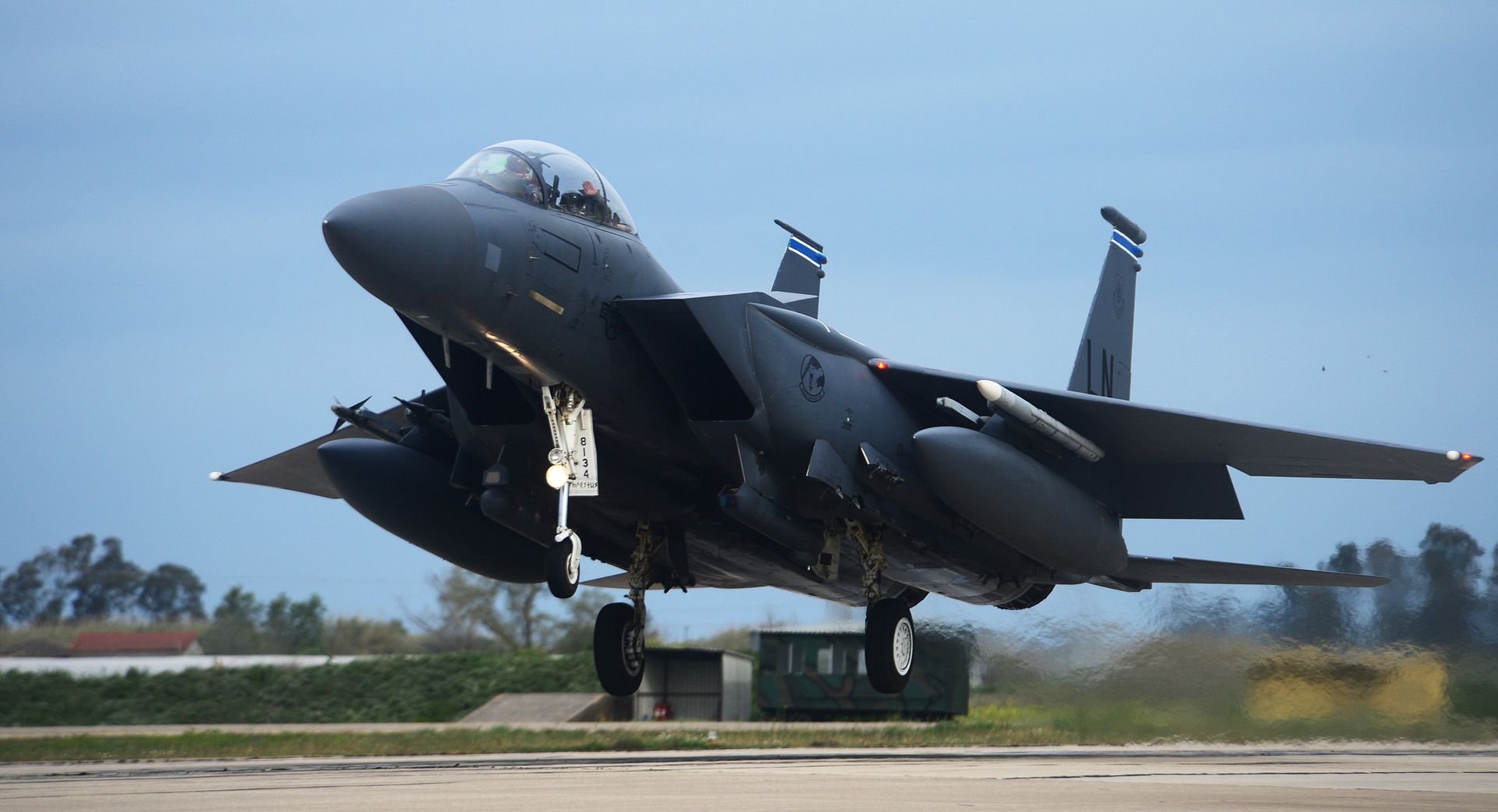
An F-15E Strike Eagle assigned to the 492nd Fighter Squadron, Royal Air Force Lakenheath, England takes off from Andravida Air Base, Greece, March 21, 2018, during exercise INIOHOS 18. The 492nd FS is flying alongside Hellenic Air Force airmen and other partners and Allies during the exercise to increase interoperability and strengthen partnerships. (U.S. Air Force photo/1st Lt. Elias Small)
PHILIPPINE SEA (March 23, 2018) Sailors prepare to tow an F-35B Lightning II on the flight deck of the amphibious assault ship USS Wasp (LHD 1). The Wasp Expeditionary Strike Group, with embarked 31st Marine Expeditionary Unit, is operating in the Indo-Pacific region to enhance interoperability with partners, serve as a ready-response force for any type of contingency and advance the Up-Gunned ESG Concept. (U.S. Navy photo by Mass Communication Specialist 3rd Class Michael Molina/Released)
Date: 23 Mar 2018
An air defence exercise has seen Royal Air Force and Arm?e de l'Air aircraft and Control Reporting Centres work closely together to ensure we are always ready to protect our skies.
Exercise Sheihan River is designed to test the resilience of UK and French air defence. In the counter-terrorist scenario a renegade aircraft was first intercepted in French controlled airspace by Mirage 2000C fighter jets. As the aircraft converged on UK controlled airspace the bi-lateral agreement with the France was invoked and close cooperation between the Control Reporting Centres of both nations ensured a seamless transition between the AdlA and RAF Typhoon fighter pilots.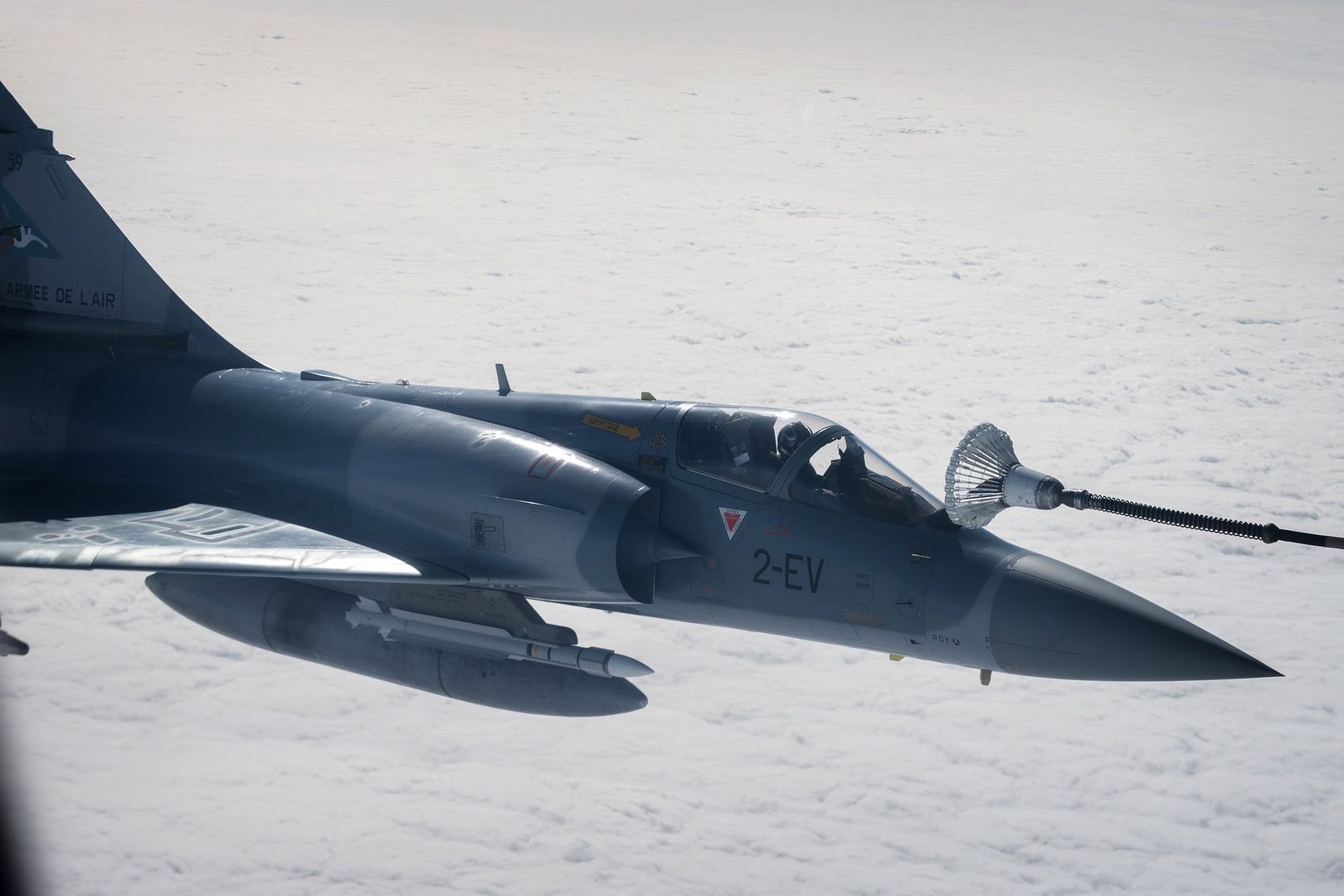
Whilst the exercise is routine, this was the first occasion an intercepting French aircraft had refuelled from a RAF Voyager air-air refuelling tanker.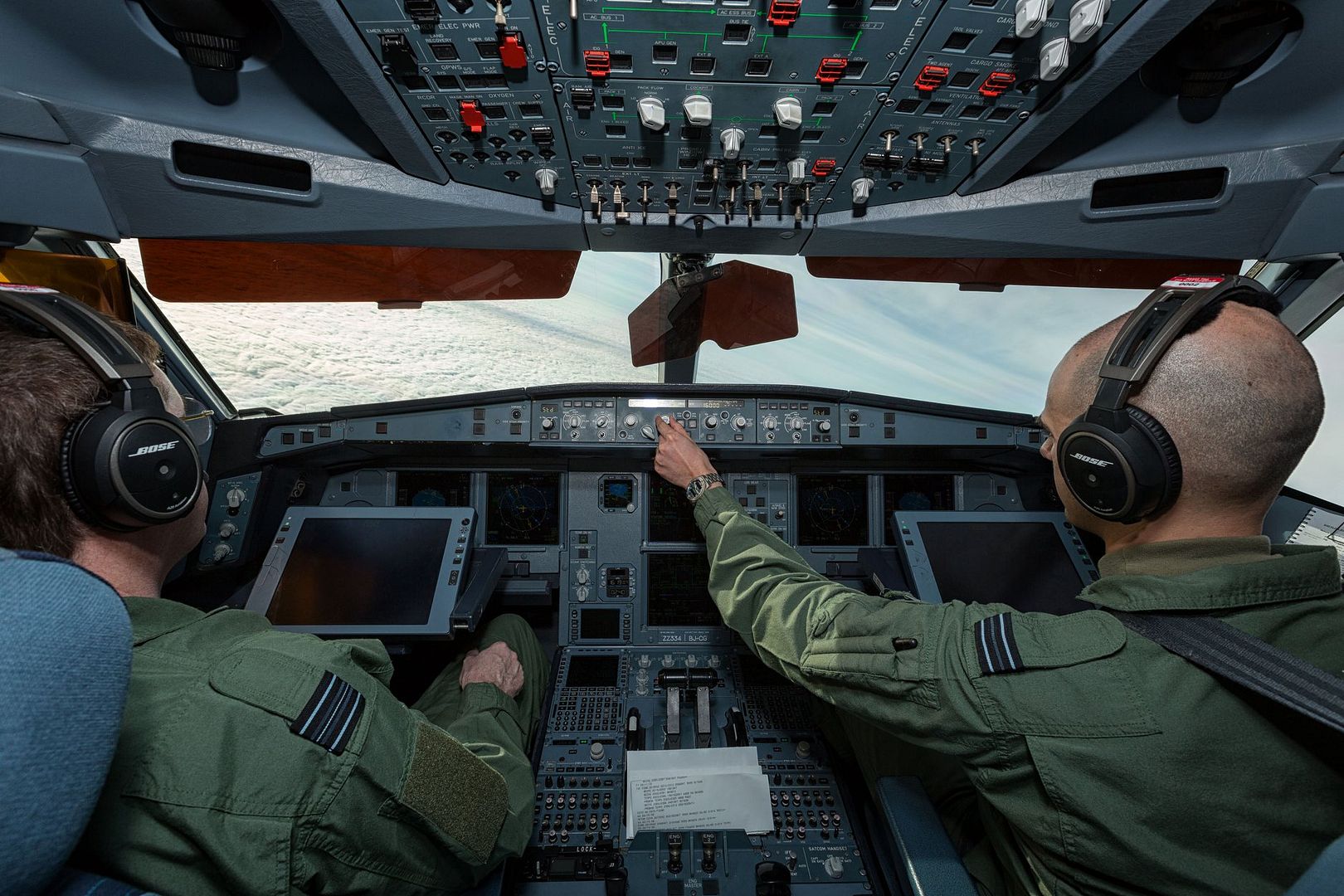
Interoperability with key allies is vital for our operations and this exercise is the latest example of the close cooperation which exists between both Air Forces. Each remains heavily engaged the fight against violent extremist organisations and continue to operate alongside each other on operations in the Middle East and Mali.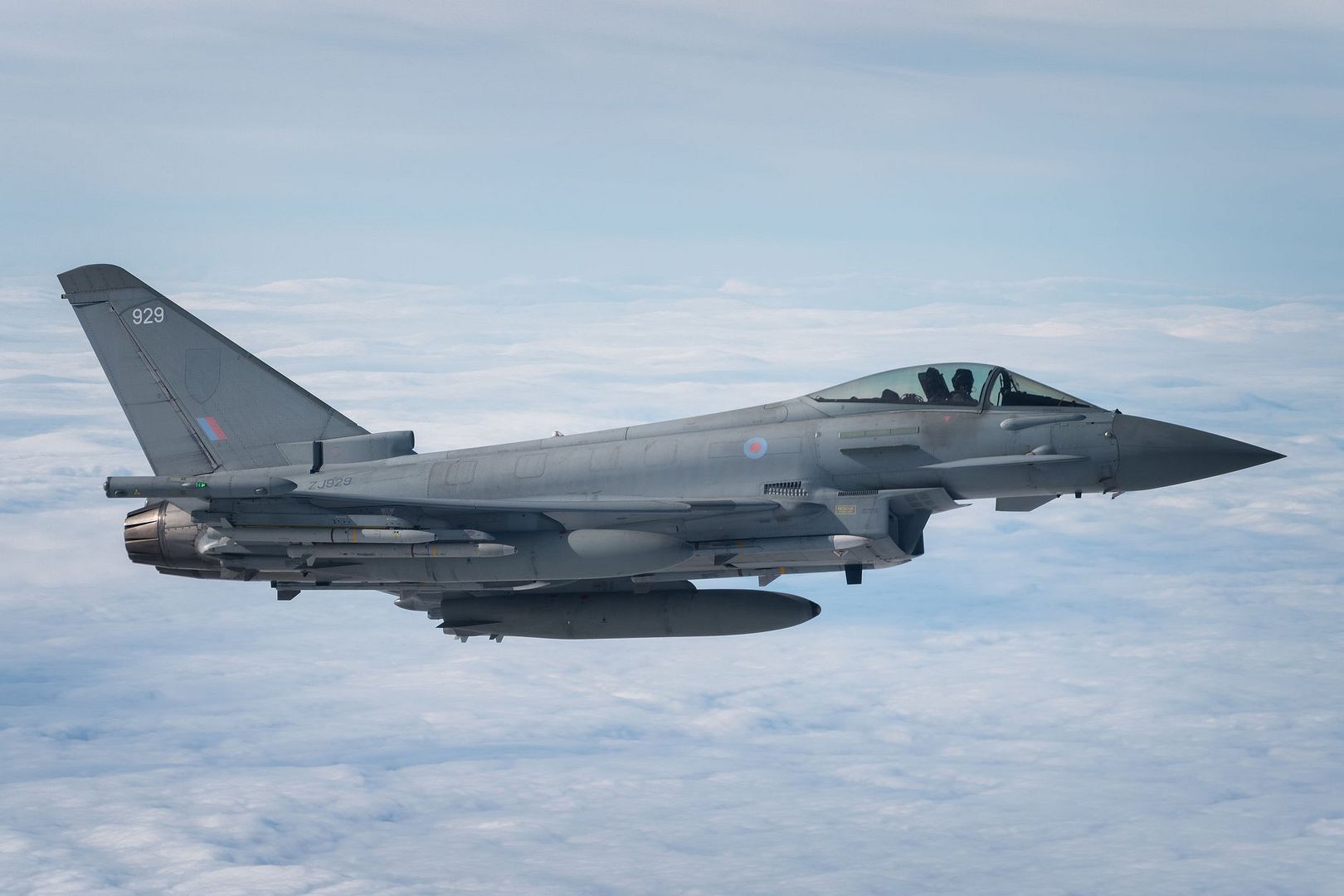
-
 Main AdminAn F-35B Lightning II launches down the flight deck of the USS Wasp (LHD-1) while underway in the Philippine Sea, March 23, 2018. A detachment of F-35Bs with Marine Fighter Attack Squadron 121 joined the USS Wasp earlier this month, marking the F-35?s first operational deployment with a MEU. As the Marine Corps? only continuously forward-deployed MEU, the 31st MEU provides a flexible force ready to perform a wide range of military operations. (U.S. Marine Corps photo by Lance Cpl. Amy Phan/Released)
Main AdminAn F-35B Lightning II launches down the flight deck of the USS Wasp (LHD-1) while underway in the Philippine Sea, March 23, 2018. A detachment of F-35Bs with Marine Fighter Attack Squadron 121 joined the USS Wasp earlier this month, marking the F-35?s first operational deployment with a MEU. As the Marine Corps? only continuously forward-deployed MEU, the 31st MEU provides a flexible force ready to perform a wide range of military operations. (U.S. Marine Corps photo by Lance Cpl. Amy Phan/Released)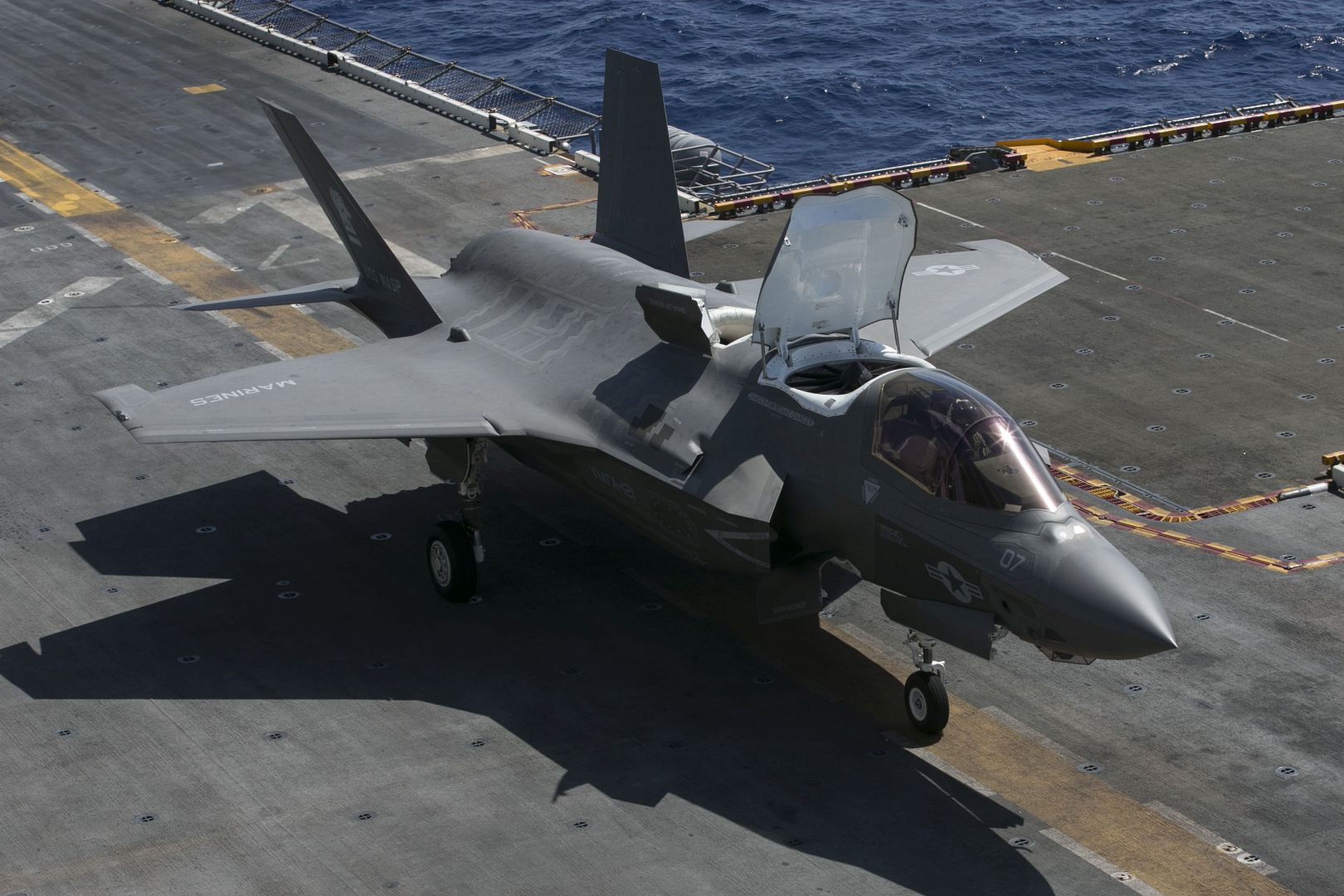
An F-35B Lightning II prepares to land on the flight deck of the USS Wasp (LHD-1) while underway in the Philippine Sea, March 23, 2018. A detachment of F-35Bs with Marine Fighter Attack Squadron 121 joined the USS Wasp earlier this month, marking the F-35?s first operational deployment with a MEU. As the Marine Corps? only continuously forward-deployed MEU, the 31st MEU provides a flexible force ready to perform a wide range of military operations. (U.S. Marine Corps photo by Lance Cpl. Amy Phan/Released)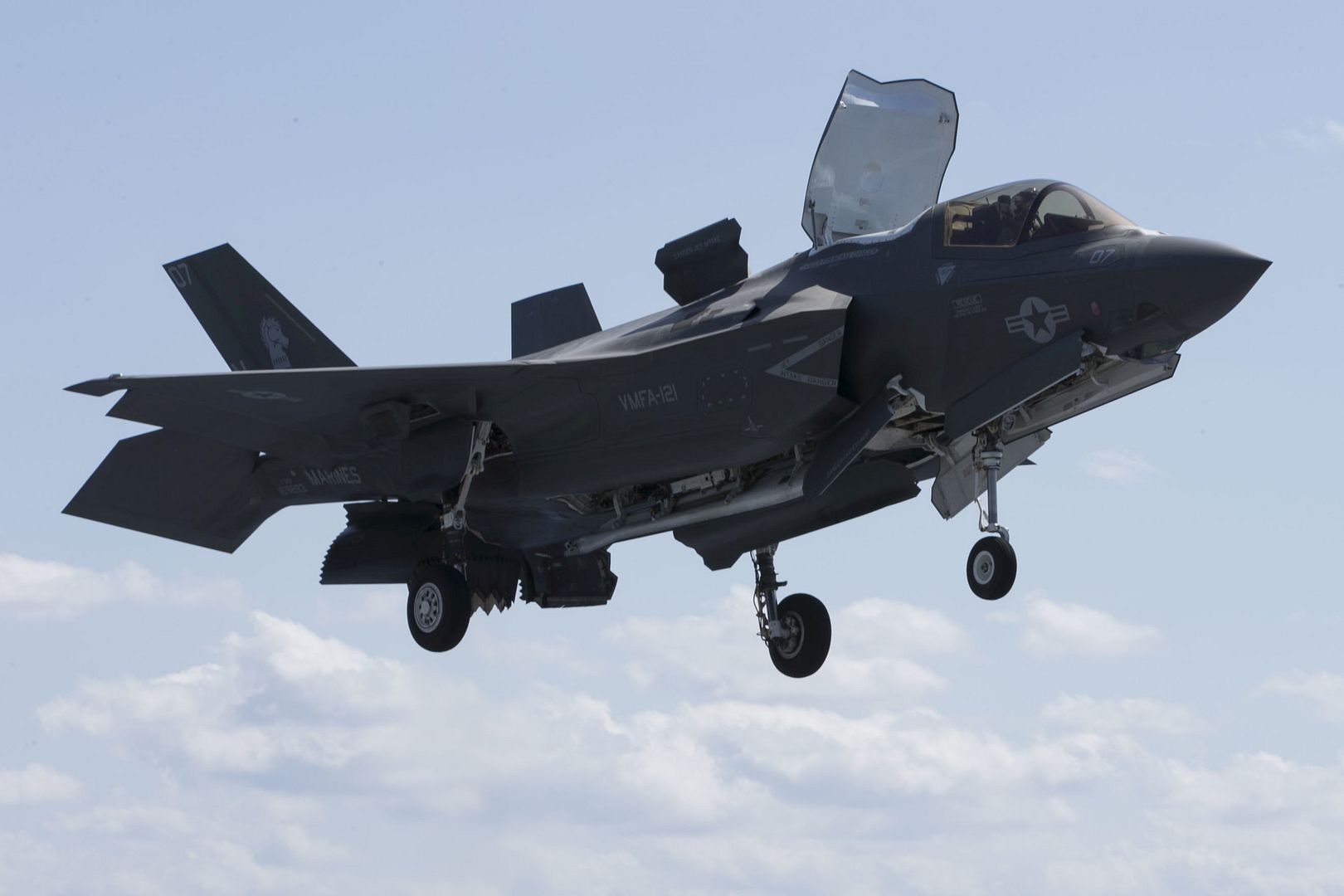
An MC-130J Commando II, assigned to the 9th Special Operations Squadron, lands at Orogrande, N.M., in preparation for the Marine Corps' high-mobility artillery rocket system launch during Exercise Emerald Warrior 18, March 5, 2018. The 14th Marine Regiment, is one of two Marine Corps HIMARS field artillery battalions, that provide fire support in austere locations. (U.S. Air Force photo by Tech. Sgt. Larry E. Reid Jr.)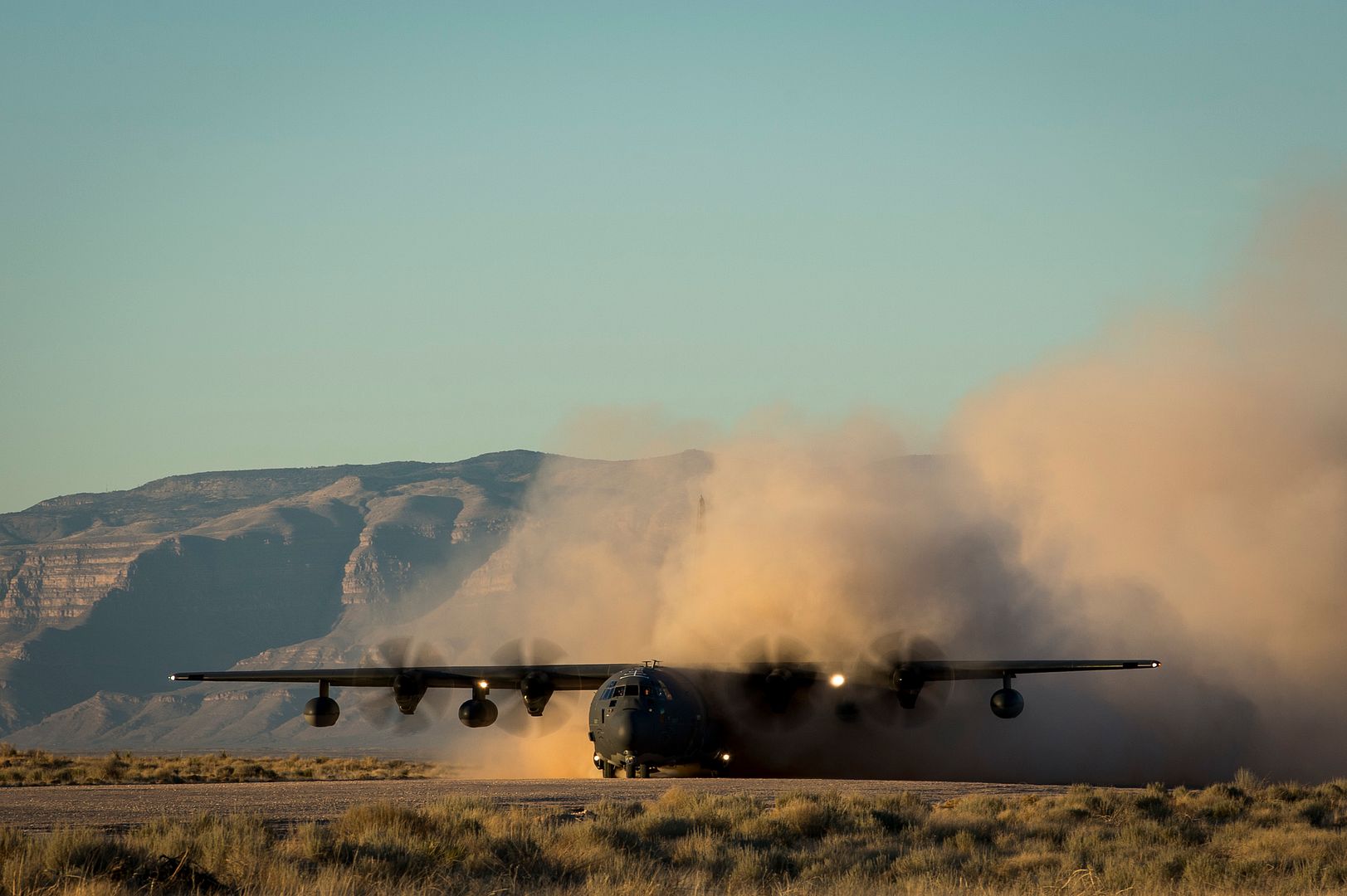
PACIFIC OCEAN (March 20, 2018) An F/A-18C Hornet assigned to the Blue Blasters of Strike Fighter Squadron (VFA) 34 flies near the Nimitz-class aircraft carrier USS Carl Vinson (CVN 70). The Carl Vinson Carrier Strike Group is operating in the western Pacific as part of a scheduled deployment. (U.S. Navy photo by Lt. Cmdr. Troy Vantrease/Released)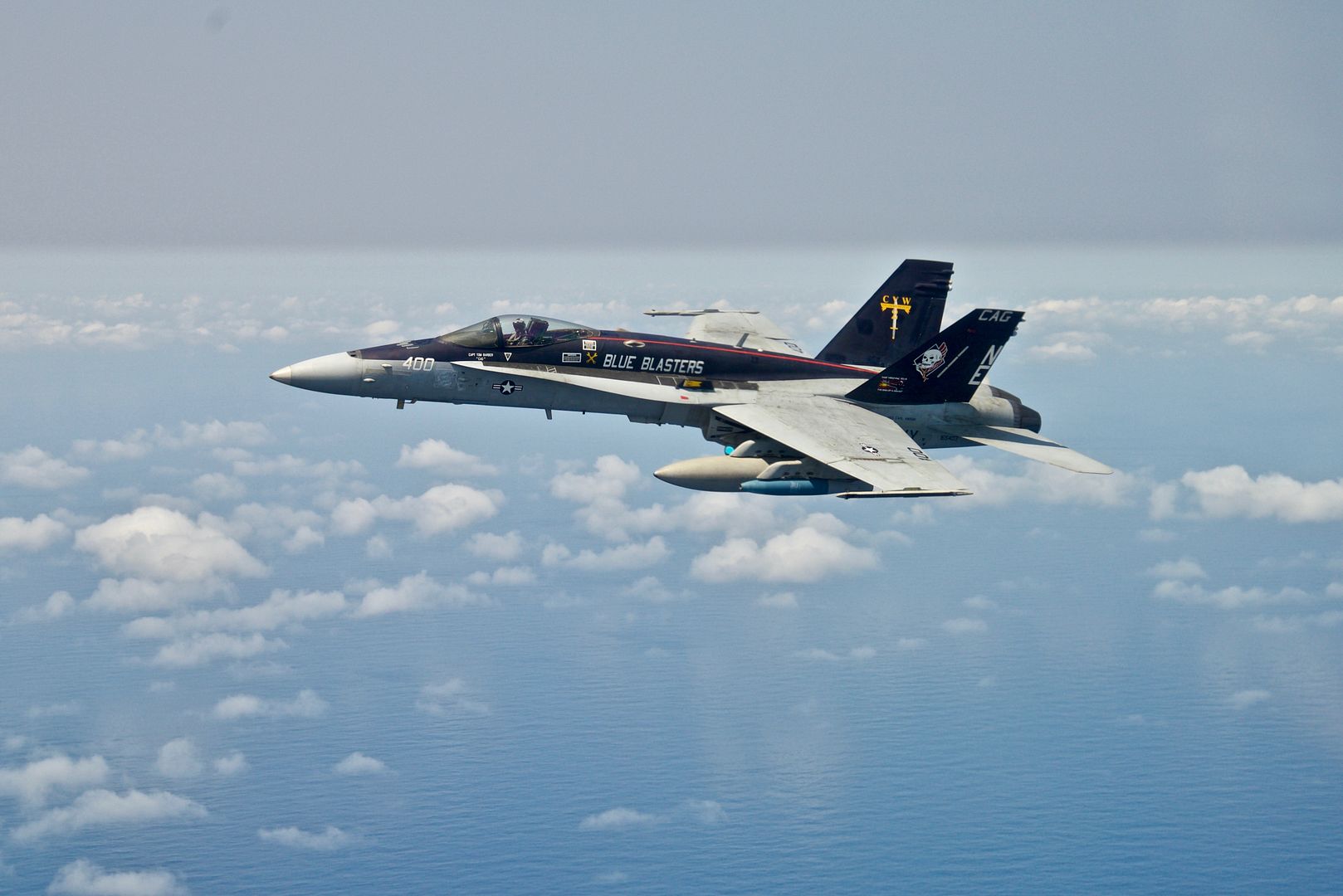
-
6 years agoMon Mar 26 2018, 09:21pm
 Main AdminA 1,000 pound Guided Bomb Unit sits staged on the flight deck of the USS Wasp (LHD-1) while underway in the Philippine Sea, March 24, 2018. Marine Fighter Attack Squadron 121 loaded GBU-32s onto their F-35Bs, marking the first time an F-35 has been loaded with live ordnance at sea during an operational deployment. GBU-32s are GPS guided joint direct attack munitions capable of attaching to VMFA 121?s F-35B Lightning IIs. As the Marine Corps? only continuously forward-deployed MEU, the 31st MEU provides a flexible force ready to perform a wide range of military operations. (U.S. Marine Corps photo by Lance Cpl. Amy Phan/Released)
Main AdminA 1,000 pound Guided Bomb Unit sits staged on the flight deck of the USS Wasp (LHD-1) while underway in the Philippine Sea, March 24, 2018. Marine Fighter Attack Squadron 121 loaded GBU-32s onto their F-35Bs, marking the first time an F-35 has been loaded with live ordnance at sea during an operational deployment. GBU-32s are GPS guided joint direct attack munitions capable of attaching to VMFA 121?s F-35B Lightning IIs. As the Marine Corps? only continuously forward-deployed MEU, the 31st MEU provides a flexible force ready to perform a wide range of military operations. (U.S. Marine Corps photo by Lance Cpl. Amy Phan/Released)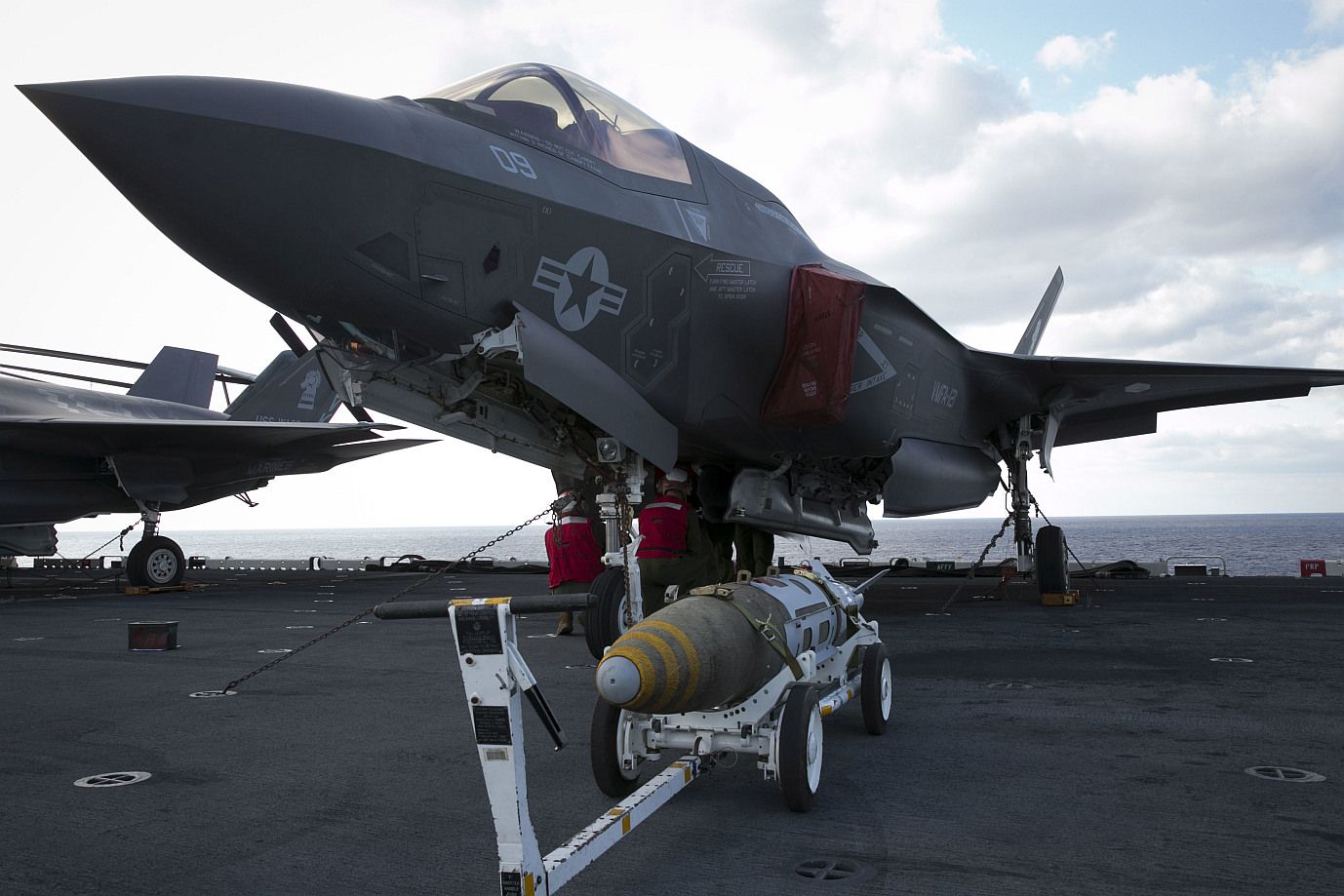
ATLANTIC OCEAN (NNS) -- Nimitz-class aircraft carrier USS Abraham Lincoln (CVN 72) completed fleet carrier qualifications (CQ) for the F-35C Lightning II program, marking another milestone for the new aircraft, while underway March 17-21.
Pilots assigned to the "Rough Raiders" of Strike Fighter Squadron (VFA) 125 and the "Grim Reapers" of VFA 101 accomplished day and night qualifications with 140 traps in anticipation of F-35C operational testing later this year.
Aboard for part of the CQ was Rear Adm. Dale Horan, director of the U.S. Navy F-35C Fleet Integration Office, who was previously embarked aboard Abraham Lincoln during a nine-and-a-half-month deployment in 2002.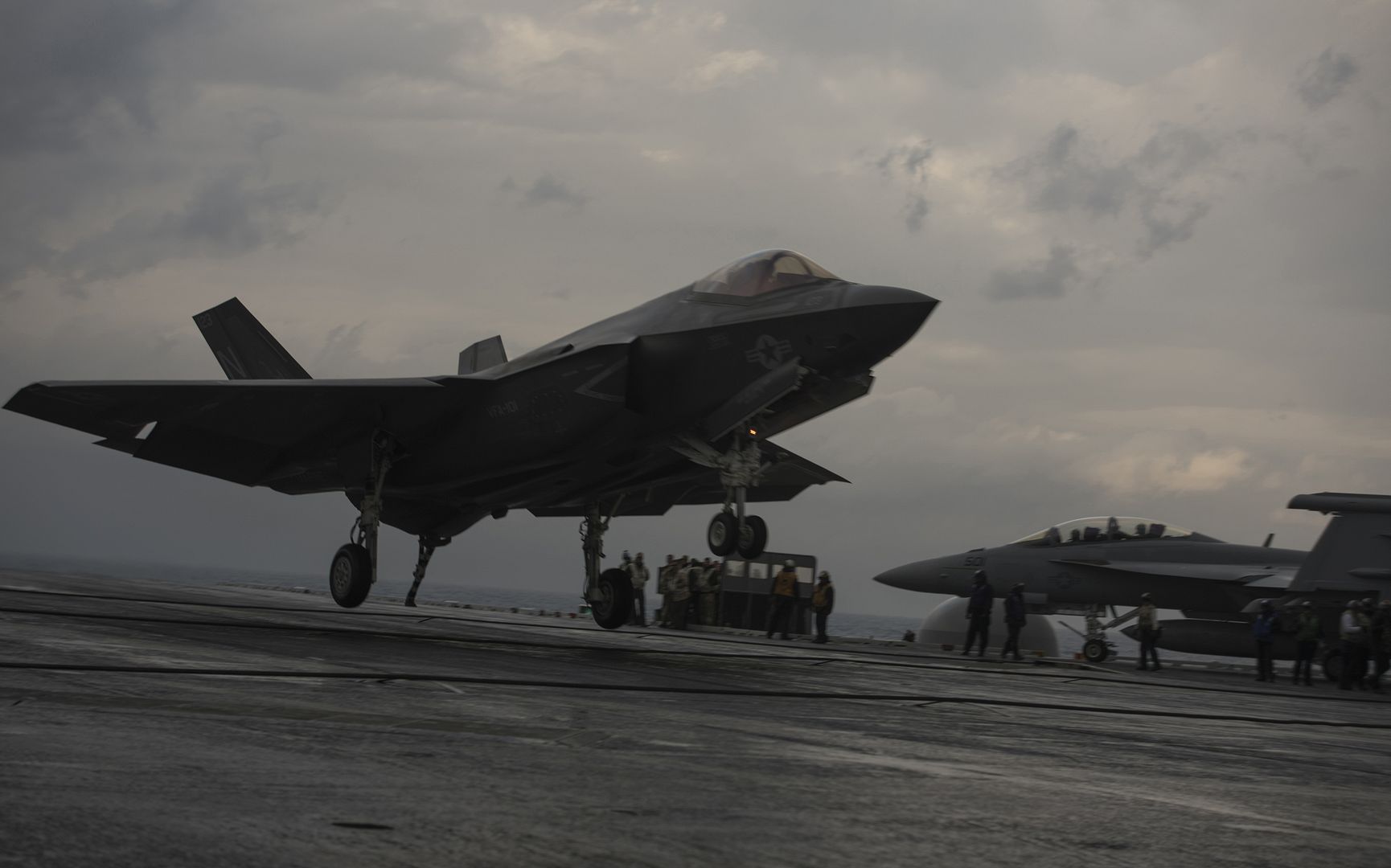
"I have tight ties to Lincoln," said Horan. "It's personally interesting for me, but also professionally, it's really neat to see this aircraft out there with other aircraft; we haven't done that before. Previously, all the CQ evolutions have just been F-35s."
The F-35C complements the tactical fighter fleet with a dominant, multirole, next-generation aircraft capable of projecting U.S. power and deterring potential adversaries. The continued integration of the F-35C into the carrier air wing will enable the carrier strike group of the future to be more lethal and survivable in high-end threat environments.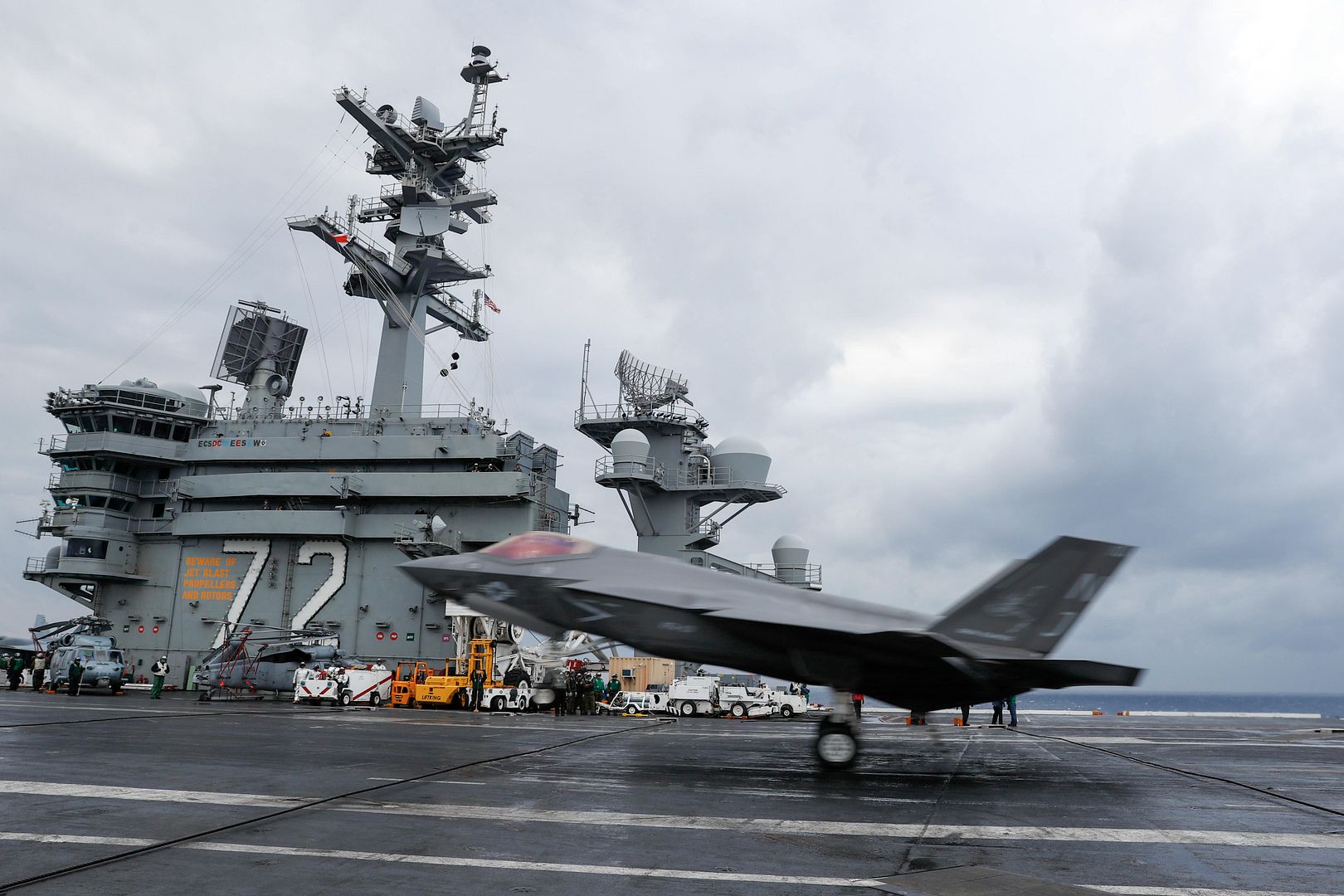
One of the major milestones for this carrier qualification evolution was the operational use of the F-35C's foldable-wing feature. This feature is a critical component of the integration of F-35Cs with F/A-18C Hornets, F/A-18E/F Super Hornets and EA-18G Growlers, facilitating the movement of the different platforms on the flight deck and rehearsing for operating as part of a full air wing aboard the carrier.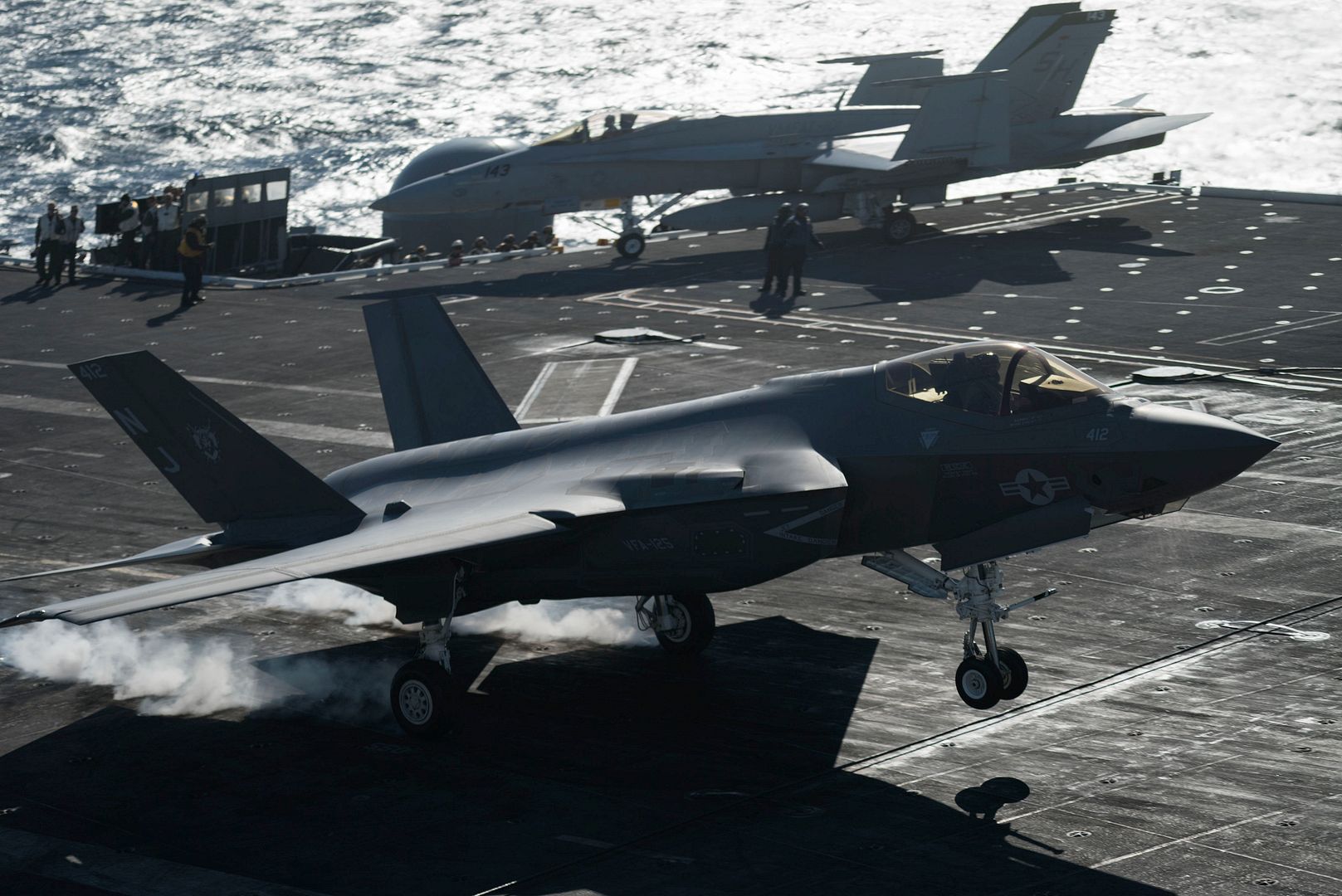
"My original platform is the Hornet, which I've flown for the past three years," said Lt. Nick Rezendes, a pilot attached to VFA 101, who qualified on the F-35C during this CQ. "I wanted to switch to flying the Navy's newest aircraft, and now that I have, I wouldn't mind sticking with it for the rest of my career."
Another important piece of this underway period was the continued integration of the F-35's Autonomic Logistic Information System (ALIS) with Abraham Lincoln. ALIS is a secure, off-board fleet management tool that integrates F-35 mission planning, maintenance, supply chain and sustainment information. Operators were able to plan, maintain, and sustain F-35C systems by transmitting up-to-date data to users and maintainers worldwide.
During Abraham Lincoln's previous F-35C Fleet Replacement Squadron (FRS) carrier qualifications in December of 2017, an operational squadron accomplished the use of the Joint Precision Approach and Landing System (JPALS) for the first time. The GPS-based, all-weather landing system works to provide accurate and reliable information for carrier landing approach, allowing F-35Cs to land during inclement weather.
"It's pretty clear that this aircraft is the Navy's future for strike warfare," said Horan. "It's shaping up to be a fantastic aircraft. As with any program, there are always complexities in getting it fielded, but we are working through those. This aircraft is very capable and it'll be really neat to watch it develop."
By 2025, the Navy's aircraft carrier air wings are scheduled to consist of F-35Cs, F/A-18E/F Super Hornets, EA-18G Growlers electronic attack aircraft, E-2D Hawkeye battle management and control aircraft, MH-60R/S helicopters and carrier on board delivery logistics aircraft.
A U.S. Air Force F-15 Eagle deploys flares while departing from a KC-135 Stratotanker assigned to the 340th Expeditionary Air Refueling Squadron during a refueling mission above Iraq March 16, 2018. The 340th EARS is assigned to the 379th Expeditionary Operations Group and supports various operations in countries such as Iraq, Syria and Afghanistan. (U.S. Air Force Photo by Tech. Sgt. Paul Labbe)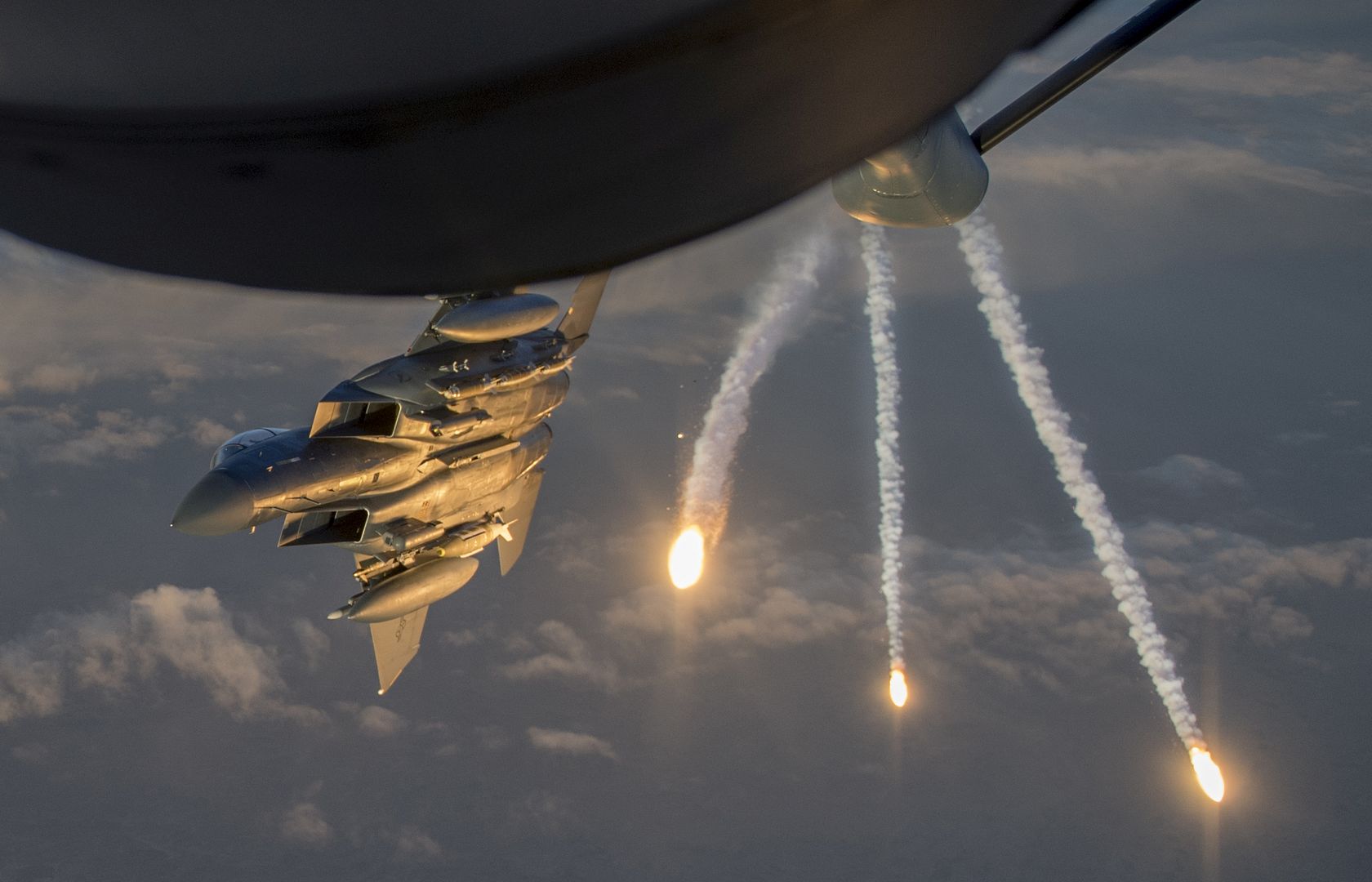
PHILIPPINE SEA (March 26, 2018) An F-35B Lightning II assigned to the 31st Marine Expeditionary Unit (31st MEU) prepares to take off from the flight deck of the amphibious assault ship USS Wasp (LHD 1). Wasp and its expeditionary strike group (ESG) are operating in the Indo-Pacific region to enhance interoperability with partners, serve as a ready-response force for any type of contingency and advance the up-gunned ESG concept. (U.S. Navy photo by Mass Communication Specialist 3rd Class Michael Molina/Released)
NORTH CHARLESTON, S.C., March 25, 2018 /PRNewswire/ -- Boeing (NYSE: BA) and Singapore Airlines today celebrated the delivery of the first 787-10 airplane, the newest and largest member of the Dreamliner family and a jet that will set a new global standard for fuel efficiency.
Boeing and Singapore Airlines today celebrated the delivery of the first 787-10 airplane, the newest and largest member of the Dreamliner family and a jet that will set a new global standard for fuel efficiency. The airplane is seen here outside of Boeing South Carolina, during a delivery celebration attended by about 3,000 people. (Joshua Drake photo) (PRNewsfoto/Boeing)
About 3,000 people marked the milestone at Boeing's facility in North Charleston, South Carolina where the latest 787 model is manufactured.
Like the other 787 Dreamliners, the 787-10 is designed with strong, lightweight composites, the most advanced systems, and comfortable cabin features. The 787-10, though, features a longer fuselage which allows it to carry about 40 more passengers or a total of 330 seats in a standard two-class configuration.
With the additional capacity, the 787-10 provides airlines the lowest operating cost per seat of any widebody airplane in service today.
"It is an honour for us to be the world's first airline to take delivery of this amazing aircraft," said Mr. Goh Choon Phong, chief executive officer of Singapore Airlines, the 787-10 launch customer. "The 787-10 is a magnificent piece of engineering and truly a work of art. It will be an important element in our overall growth strategy, enabling us to expand our network and strengthen our operations."
Goh added that "the 787-10 underscores Singapore Airlines' longstanding commitment to operate a modern fleet, and marks the start of a new chapter in our shared story with Boeing."
Singapore Airlines ? through its subsidiary Scoot ? already flies the 787-8 and 787-9 Dreamliners. With today's delivery the group will be the first to operate all three Dreamliner models. Singapore Airlines has 68 additional Boeing widebody jets on order, including 48 additional 787-10s, and 20 of the new 777-9s.
"This is a big day for all of us at Boeing and for our global supplier partners. We are thrilled to deliver the first 787-10 Dreamliner to Singapore Airlines, one of the world's leading carriers. And we are honored by Singapore's partnership and trust, as reflected by their repeated orders for the Dreamliner," said Kevin McAllister, Boeing Commercial Airplanes president and chief executive officer. "The 787-10 will extend the Dreamliner effect that we are seeing across commercial aviation as the 787's superior passenger experience and unmatched fuel efficiency helps airlines open new routes and achieve significant fuel savings and emission reduction."
The 787-10's superior performance and high commonality with its Dreamliner siblings have attracted strong interest from around the world, including in Asia where the jet can connect all points within the region. The 787-10 also offers Asian operators the flexibility to fly to Europe, Africa and Oceania.
Singapore Airlines plans to puts its 787-10s into scheduled service in May, with flights from Singapore to Osaka, Japan and Perth, Australia. Prior to the introduction of these services, the aircraft will be operated on selected flights to Bangkok and Kuala Lumpur for crew training purposes.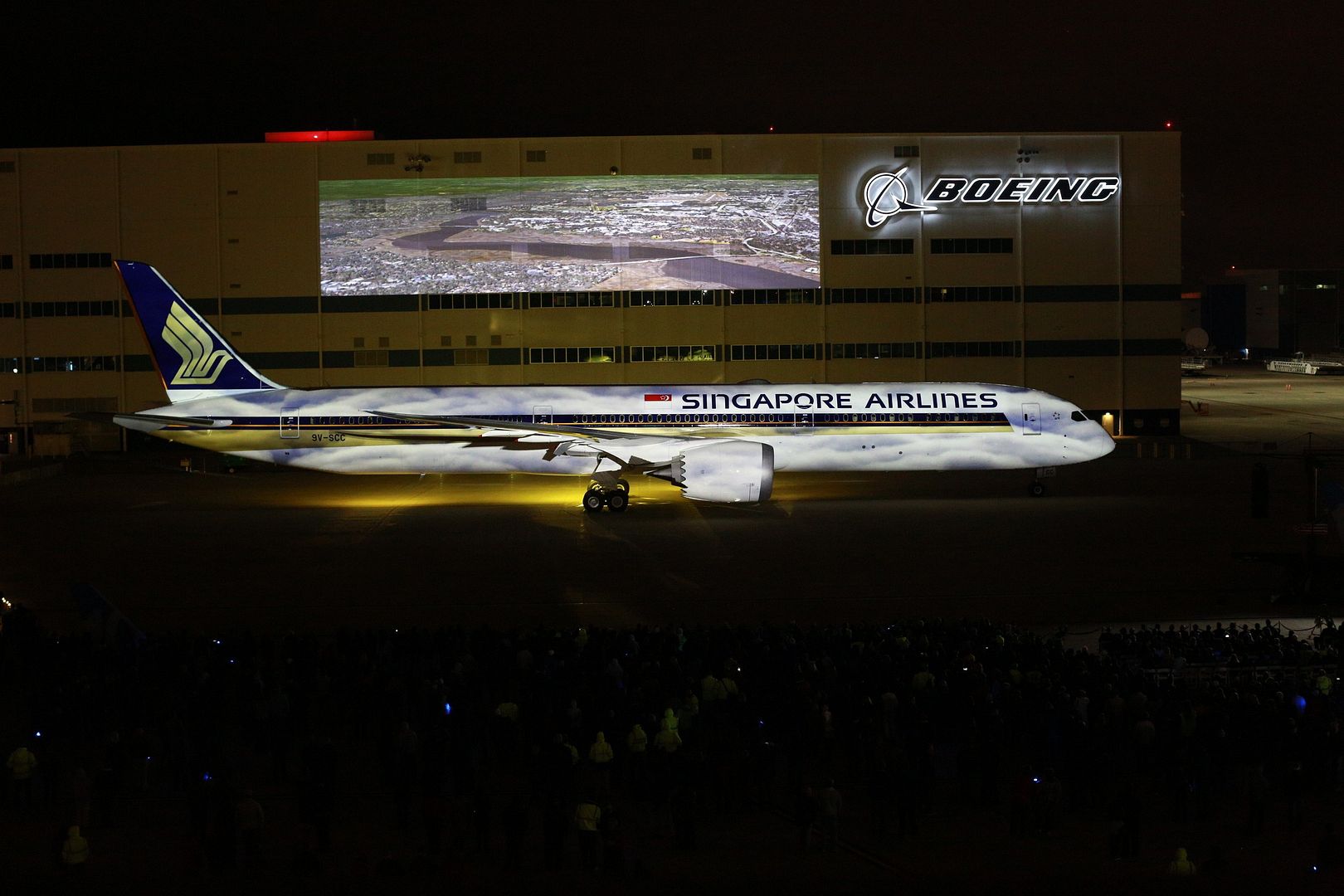
About the 787 Dreamliner family
The 787 Dreamliner is an all-new, super-efficient family of commercial airplanes that can fly long distances while offering 20 to 25 percent better fuel efficiency per seat and lower emissions than the airplanes they replace. The combination of long range and low operating costs allows airlines to operate more flights profitably.
Since 2011, more than 640 Dreamliners have entered service, flying more than 230 million people on more than 680 unique routes around the world, saving an estimated 23 billion pounds of fuel.
As a stretch of the 787-9, the 787-10 retains over 95 percent commonality while adding seats and cargo capacity, setting a new benchmark for fuel efficiency and operating economics at 25 percent better fuel per seat and emissions than the airplanes it will replace.
Vietnam?s FLC Group has signed a Memorandum of Understanding (MOU) with Airbus for up to 24 A321neo aircraft for future operation by start-up carrier Bamboo Airways.
The agreements were signed in Paris today by Trinh Van Quyet, Chairman of FLC Group and Eric Schulz, Chief Commercial Officer, Airbus during the official visit to France of Nguy?n Ph? Tr?ng, General Secretary of the Central Committee of the Communist Party of Vietnam.
Bamboo Airways is set to begin operations in 2019 with aircraft on lease from third party lessors before taking delivery of the aircraft covered by today?s MOU with Airbus. The carrier will focus on linking international markets to Vietnamese leisure destinations, as well as on selected domestic routes.
"After evaluating carefully the competing products, FLC Group and Bamboo Airways have selected the A321neo as the most efficient option for our new operation,? said Trinh Van Quyet. ?The A321neo will enable us to combine comfort, efficiency and the right capacity for our planned services, which will primarily serve fast growing leisure markets in Vietnam.?
?We are proud that the A321neo has been selected by FLC Group,? said Schulz. ?This decision once again underscores the position of the A321 as the aircraft of choice in the mid-market segment with its additional capacity and the very lowest operating cost. Vietnam is one of the most vibrant economies in South East Asia and we are proud to play a key role in helping to develop the air transport system in this fast-growing market.?
FLC Group is one of the largest conglomerates in Vietnam and is involved in a wide range of businesses including real estate development, hotel construction and management, financial services, and mining. Bamboo will in particular serve destinations where FLC Group has heavily invested in tourism infrastructure.
The A321 is the largest member of the A320 Family, seating up to 240 passengers, depending on cabin configuration. Incorporating the latest engines, aerodynamic advances, and cabin innovations, the A321neo offers a significant reduction in fuel consumption of 20 percent by 2020. It offers the longest range of any single-aisle aircraft and is capable of flying up to 4,000 nautical miles non-stop.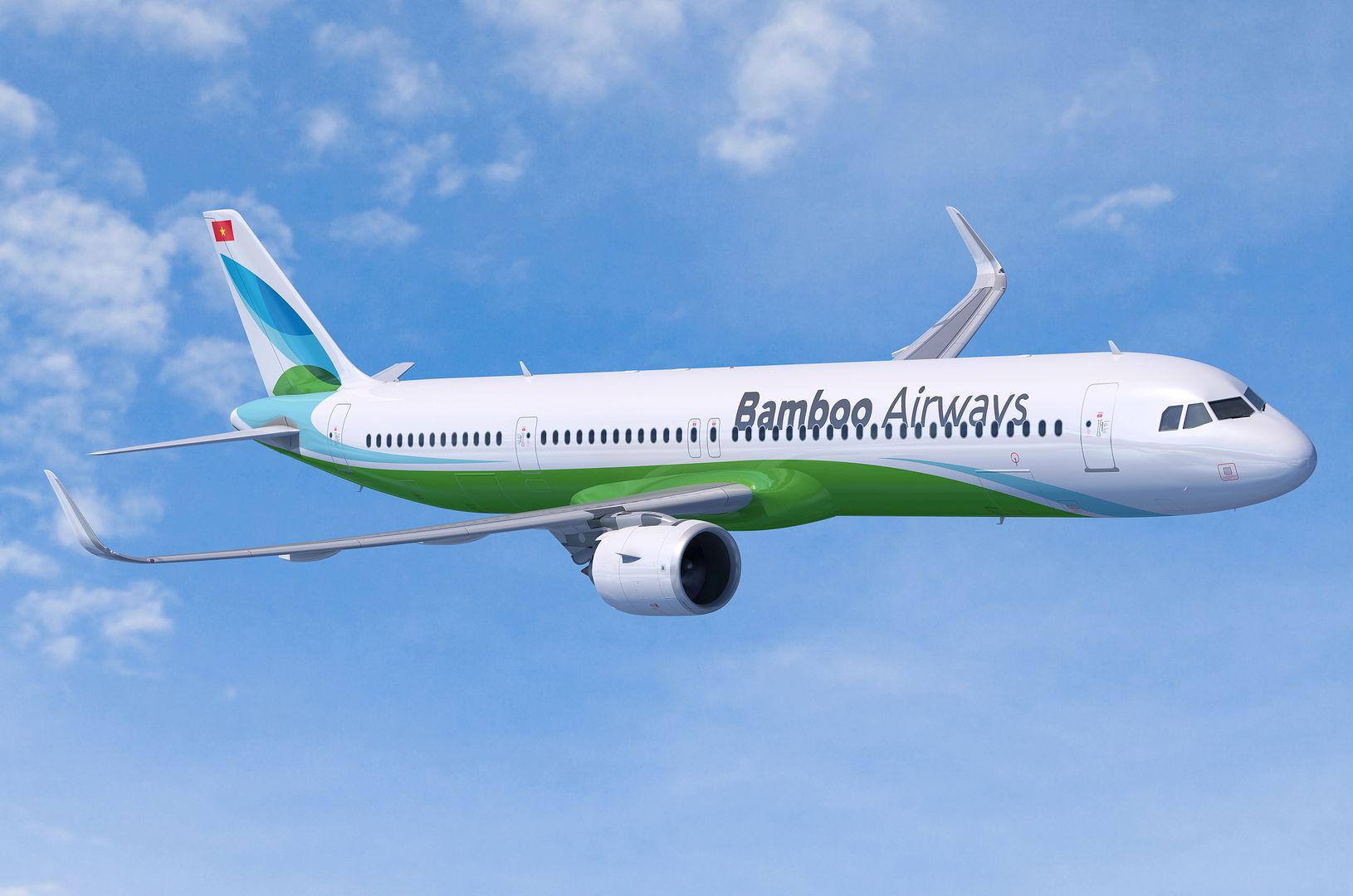
-
 Main AdminMV-22B Osprey tiltrotor aircraft take off during a helo-borne raid during Amphibious Integration Training on Ie Shima, Okinawa, Japan, March 26, 2018. Marine Medium Tiltrotor Squadron 265 (Reinforced), part of the Aviation Combat Element of the 31st Marine Expeditionary Unit, provides assault transport, close air support and aviation command and control for the 31st MEU. The 31st MEU and Amphibious Squadron 11 conduct AIT in preparation for Certification Exercise and to ensure readiness for crisis response throughout the Indo- Pacific region. (U.S. Marine Corps photo's by Cpl. Stormy Mendez/Released)
Main AdminMV-22B Osprey tiltrotor aircraft take off during a helo-borne raid during Amphibious Integration Training on Ie Shima, Okinawa, Japan, March 26, 2018. Marine Medium Tiltrotor Squadron 265 (Reinforced), part of the Aviation Combat Element of the 31st Marine Expeditionary Unit, provides assault transport, close air support and aviation command and control for the 31st MEU. The 31st MEU and Amphibious Squadron 11 conduct AIT in preparation for Certification Exercise and to ensure readiness for crisis response throughout the Indo- Pacific region. (U.S. Marine Corps photo's by Cpl. Stormy Mendez/Released)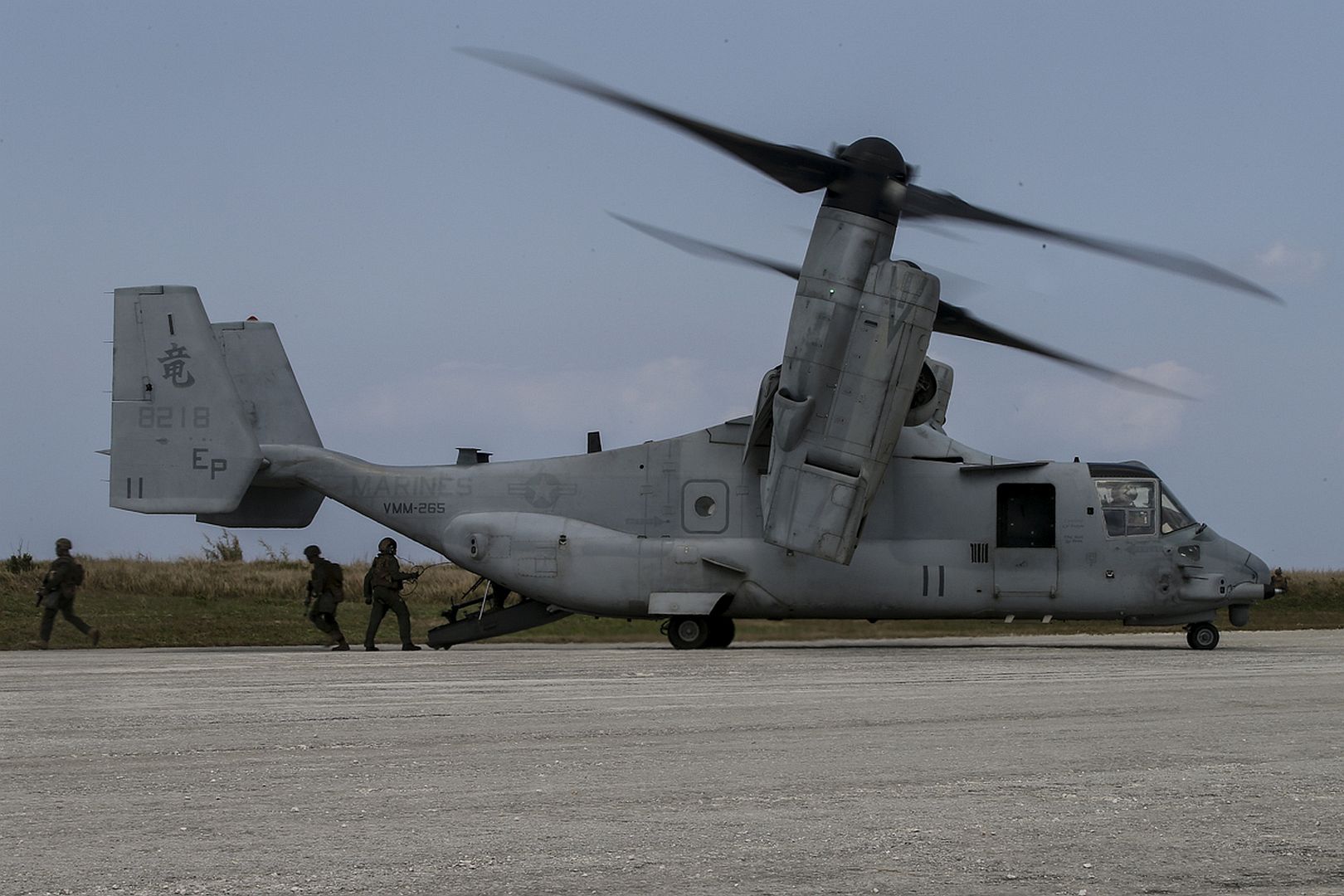
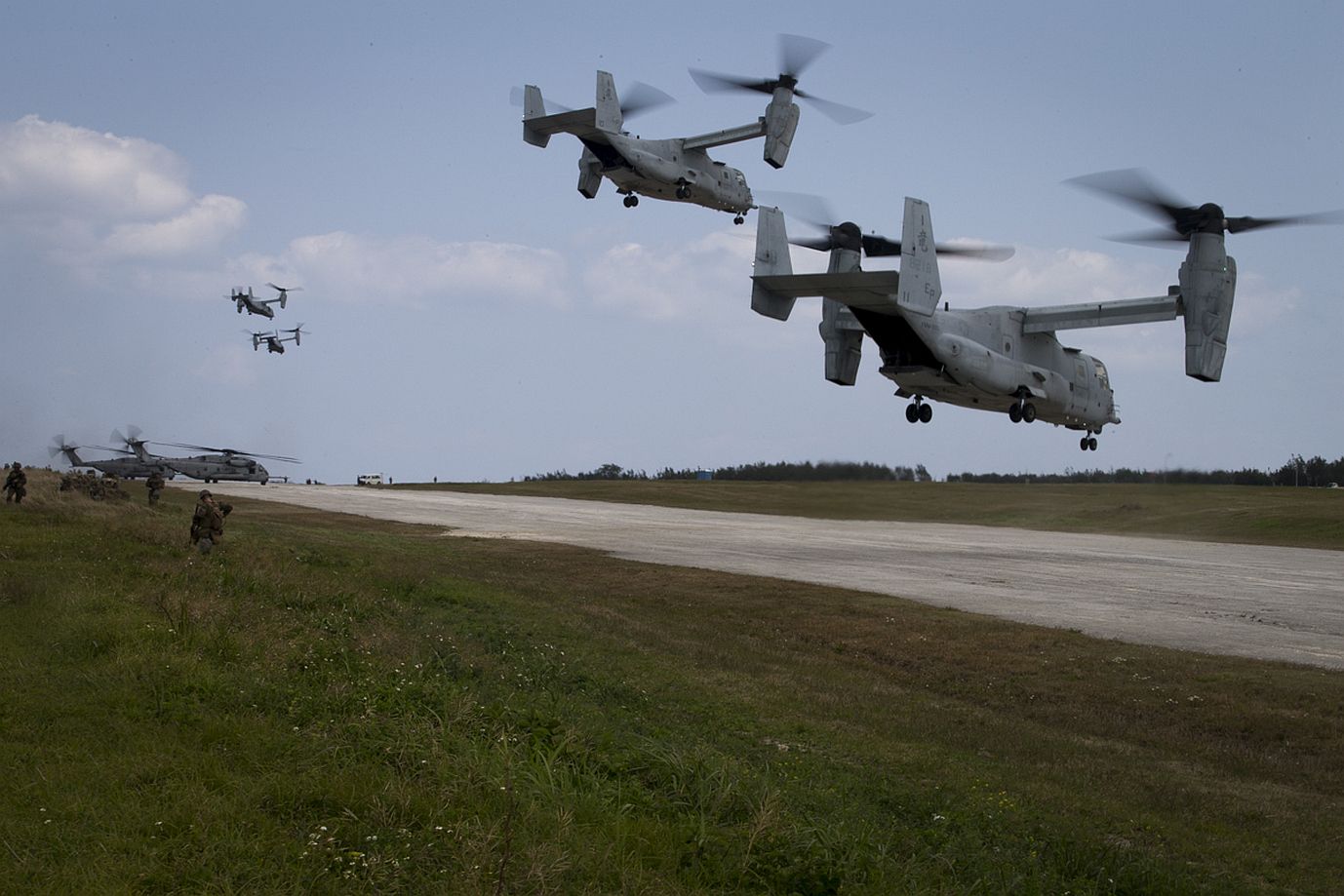
A U.S. Air Force F-16 Fighting Falcon, assigned to the 455th Expeditionary Fighter Wing, takes off from Bagram Airfield, Afghanistan in support of Operation Freedom's Sentinel, March 23, 2018. The F-16's conduct combat air patrol providing security assistance for ongoing ground operations in Afghanistan. (U.S. Air Force Courtesy Photo's Edited by Tech. Sgt. Gregory Brook)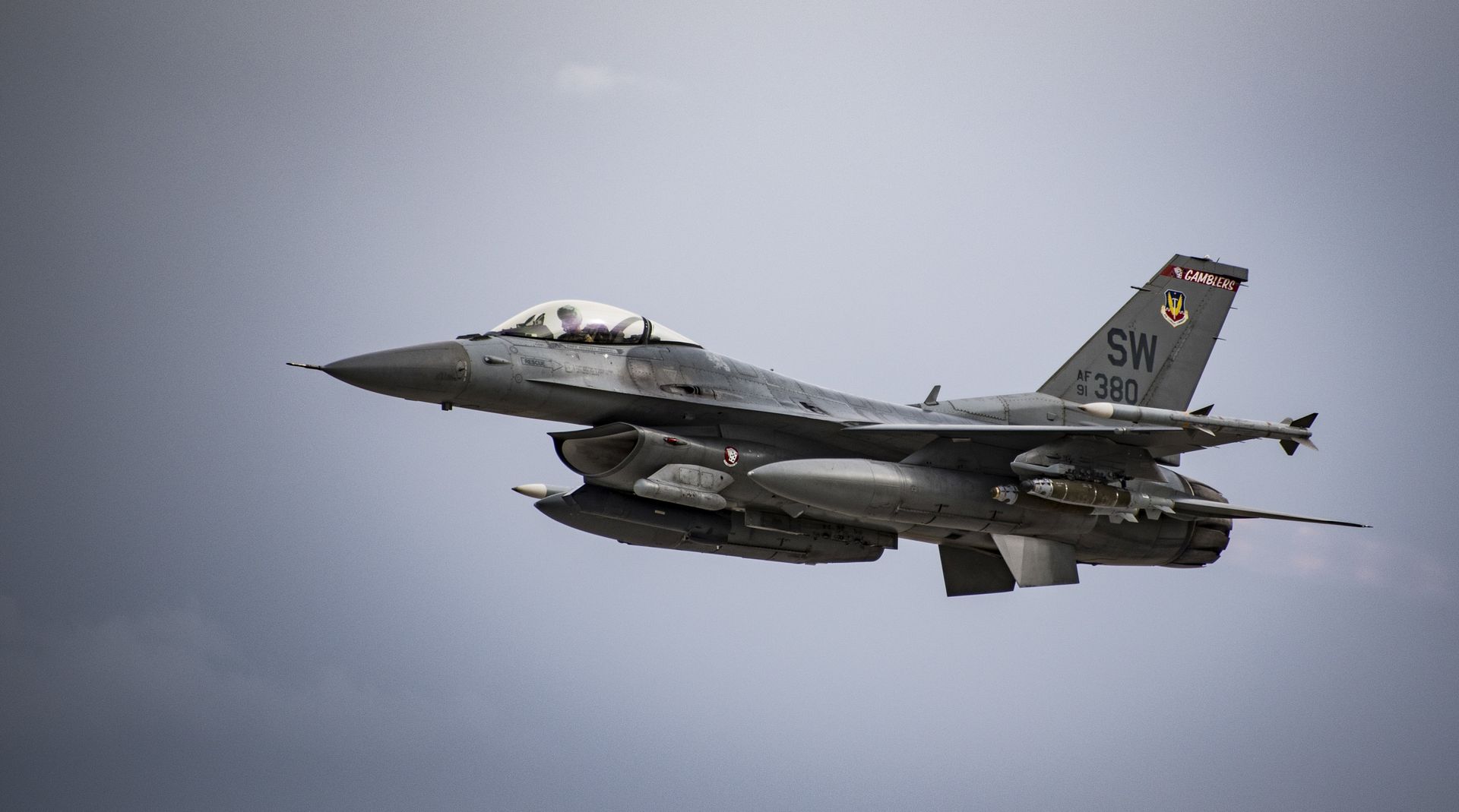
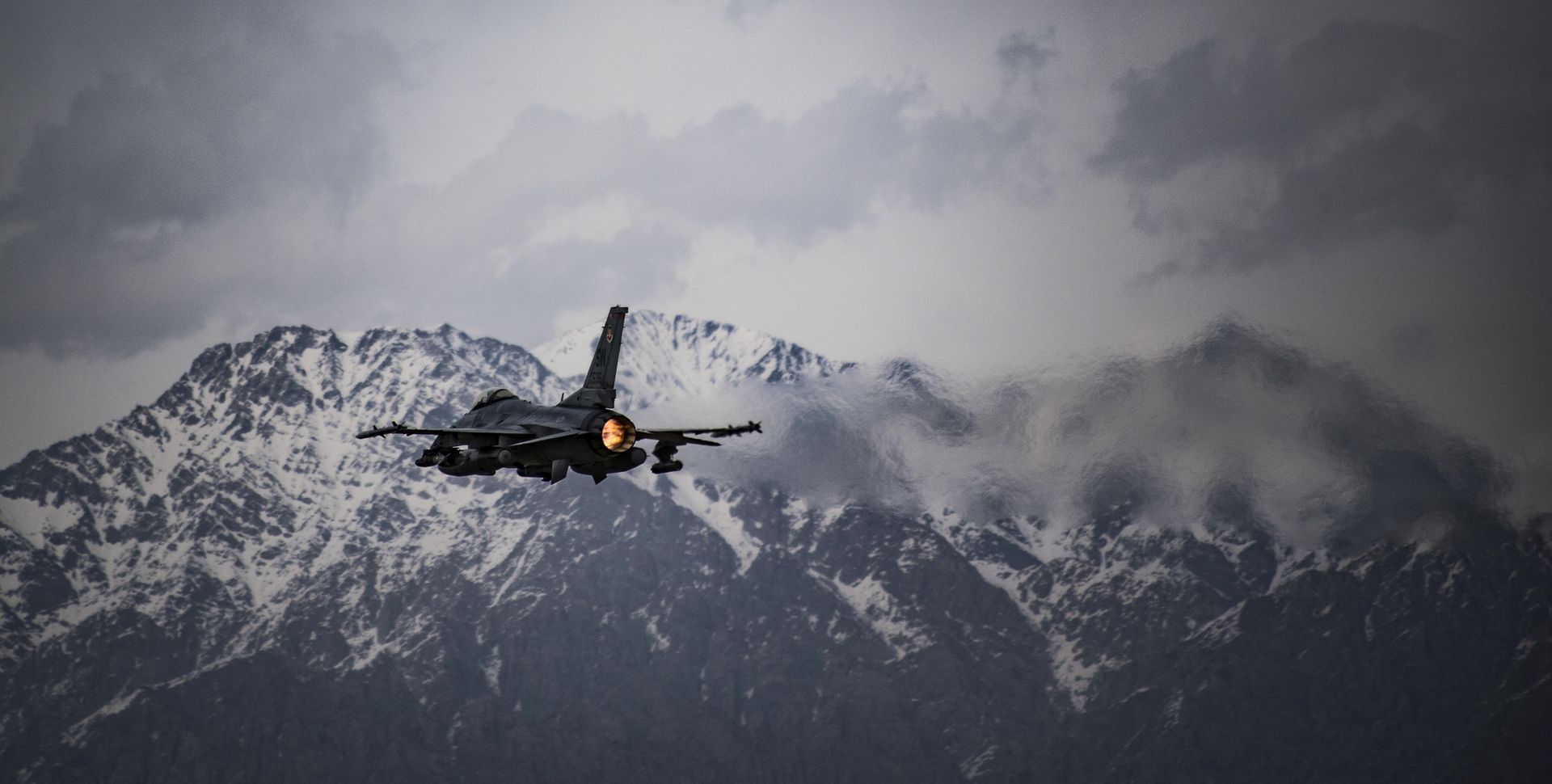
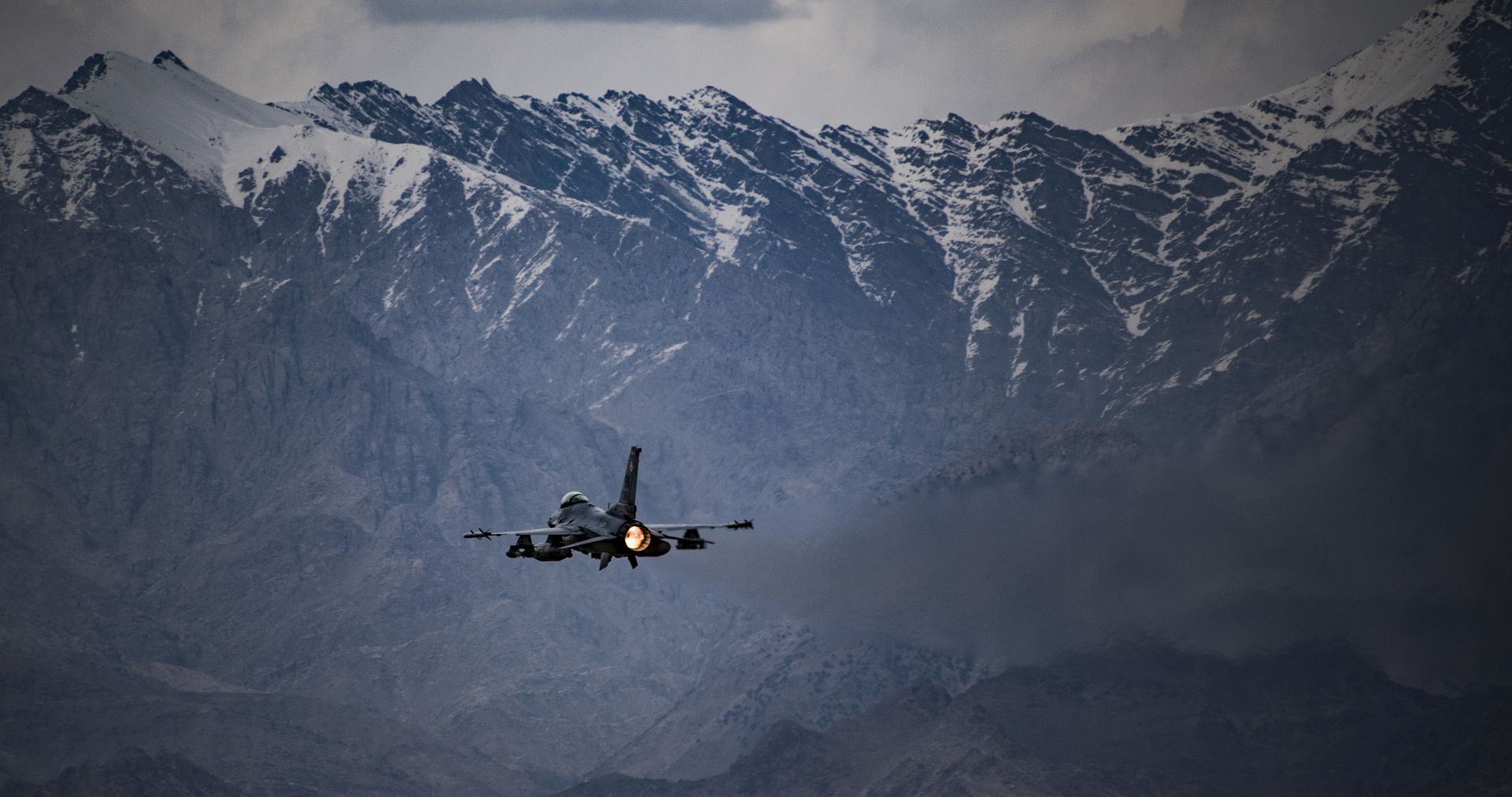
With the announcement of two key agreements earlier this week, Airbus further underscored the success of its Skywise digital aviation data platform ? which aims to become the single platform of reference used by all major aviation players to improve operational performance and business results.
Launched last year in collaboration with Palantir Technologies, Skywise provides users with a single access point to their enriched data by bringing together aviation information from multiple sources into one secure, cloud-based platform physically hosted in Europe.
The first agreement announced this week, signed by Airbus and FPT Software, will strengthen development of the Skywise ecosystem in Asia and includes an ambitious training programme for both third-party users and software developers.
easyJet opts for Skywise
The agreement with FPT Software was made public the same day as Airbus? new five-year pact with British operator easyJet to provide predictive maintenance services for its entire fleet of nearly 300 aircraft, using technology that relies on Skywise. This activity builds on extensive trials with the platform that allowed easyJet engineers to remove components before faults occurred, limiting delays and cancellations as a result.
Skywise is able to analyse data from other components on easyJet?s aircraft thanks to the installation of Airbus? new flight operations and maintenance exchanger, called FOMAX ? which collects 60-times more data than existing systems. The new equipment will be fitted on easyJet?s fleet by summer 2019.
The more data that is shared with Skywise, the more accurate its predictions and models will be for all users. Deliverables are tailored for each user and include scalable services (such as analytics, apps and APIs) that can be used by Airbus, customers, and suppliers ? ensuring complete data continuity with benefits across the entire value chain.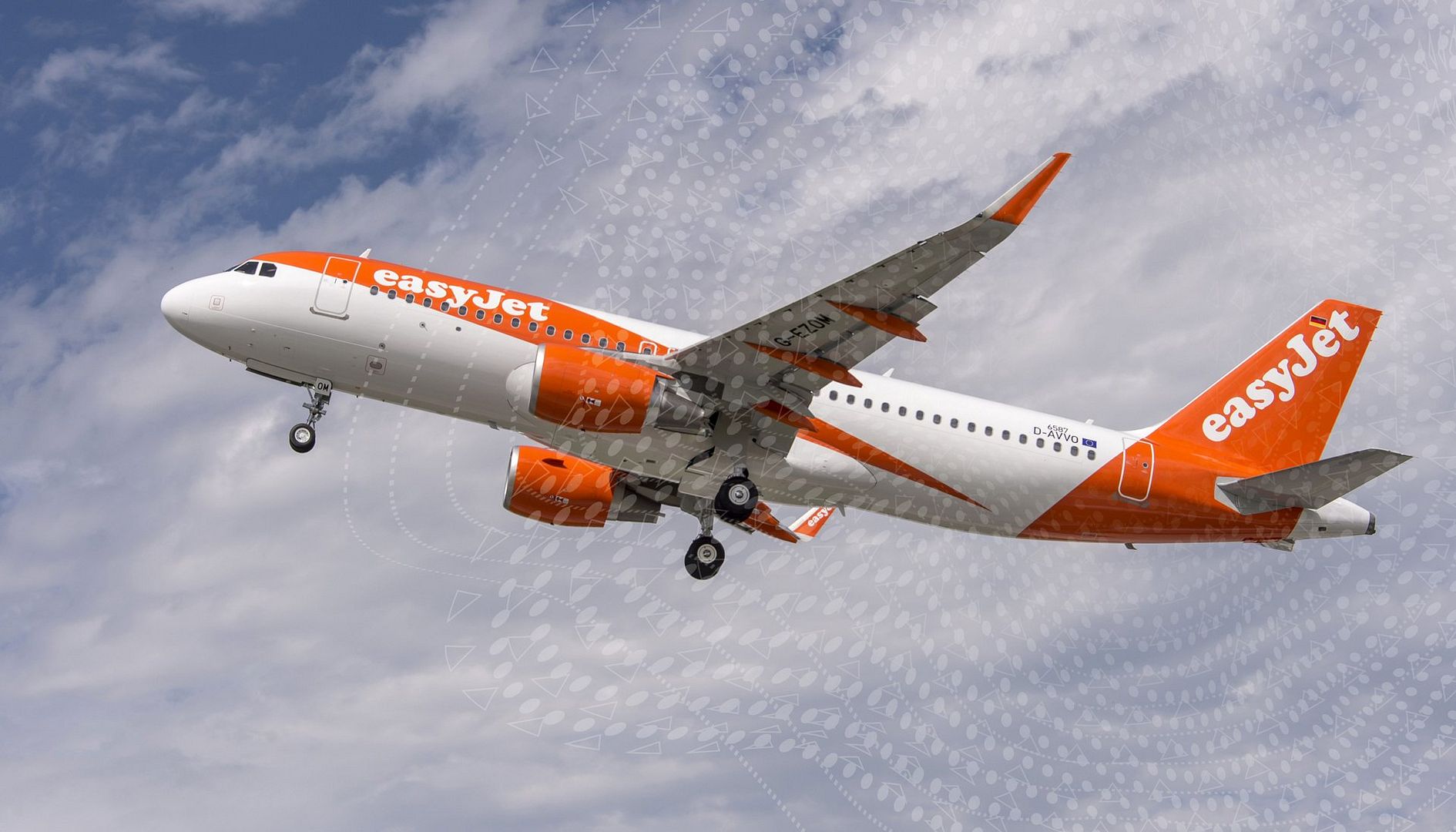
Leonardo and the Armament Inspectorate of the Polish Ministry of National Defense have signed a contract to supply four additional M-346 Advanced Jet Trainers (AJT) that will join the Polish Air Force?s existing fleet of eight aircraft by 2020. The contract, worth more than 115 million euro, includes a support package. It also contains options for additional four aircraft and support package.
Alessandro Profumo, Leonardo?s Chief Executive Officer, said: ?This contract reinforces Leonardo?s close partnership with Poland, a country where our technologies and skills are already deeply rooted, and which recognizes the unique capabilities of our integrated training system based on the M-346 aircraft?, adding ?training will be an increasingly important part of Leonardo?s strategy, as outlined in the Company?s 2018-222 Industrial Plan, as it allows us to develop a deep understanding of our customers? needs and to collaborate with them in the long term?.
This latest success builds on Leonardo?s significant footprint in Poland where it has 3000 highly-skilled employees at its PZL helicopter site in ?widnik. In Poland, Leonardo has a long standing collaboration with Polish Armaments Group (PGZ) for the Rosomak programme providing the 30 mm Hitfist Turret to the Polish Army. Leonardo supplies also several defence and security systems like the ground segment for the COSMO-SkyMed earth observation satellites, early warning radar and coastal surveillance systems contributing significantly to the security of Poland. Across the aerospace, security and cyber domains, Leonardo partners with the Polish Government and local industries to meet their requirements.
The M-346 is the most advanced trainer aircraft available on the market today and is unique in its ability to prepare pilots to fly the latest generation high-performance aircraft. Its wide flight envelope, high thrust/weight ratio and extreme maneuverability allows the M-346 to offer flight conditions similar to those of new-generation combat aircraft maximizing training effectiveness and reducing the need to fly sorties on the far more expensive and complex variants of frontline aircraft.
The Embedded Tactical Training Simulation (ETTS) allows the M-346 to emulate sensors, countermeasures and armaments, as well as allowing pilots to interact in real time with a virtual tactical scenario, further enhancing flexibility and cost reduction. Thanks to its Helmet Mounted Display, in-flight refueling probe and pylons for up to 3,000 kilos of external loads, the M-346 can carry out a complete tactical training syllabus.
The M-346 is the basis of the T-100 Integrated Training System, the solution offered by Leonardo DRS in the T-X competition for the U.S. Air Force?s advanced pilot training system programme.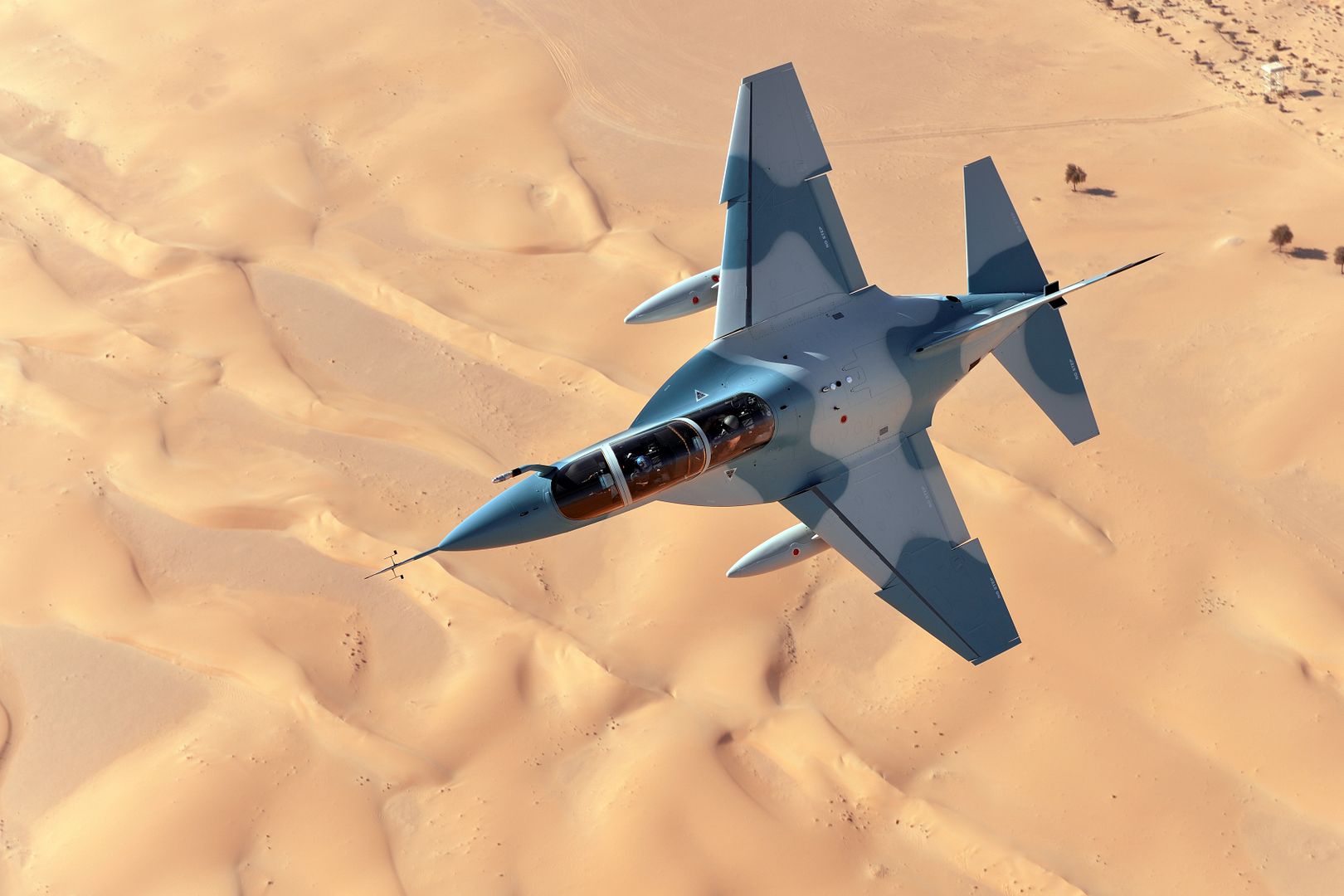
-
 Main AdminU.S. Navy F/A-18F Super Hornets with Strike Fighter Squadron (VFA) 102 arrive at Marine Corps Air Station (MCAS) Iwakuni, Japan, March 28, 2018. VFA-102 and VFA-27 relocated from Naval Air Facility Atsugi (NAFA) to MCAS Iwakuni. The relocation is in accordance with all Defense Policy Review Initiative requirements and supports the Navy's strategic vision for the Indo-Pacific, in which the most advanced units are forward deployed in order to support the United States' commitment to the defense of Japan and the security and stability of the region. (U.S. Marine Corps photo by Lance Cpl. Andrew Jones)
Main AdminU.S. Navy F/A-18F Super Hornets with Strike Fighter Squadron (VFA) 102 arrive at Marine Corps Air Station (MCAS) Iwakuni, Japan, March 28, 2018. VFA-102 and VFA-27 relocated from Naval Air Facility Atsugi (NAFA) to MCAS Iwakuni. The relocation is in accordance with all Defense Policy Review Initiative requirements and supports the Navy's strategic vision for the Indo-Pacific, in which the most advanced units are forward deployed in order to support the United States' commitment to the defense of Japan and the security and stability of the region. (U.S. Marine Corps photo by Lance Cpl. Andrew Jones)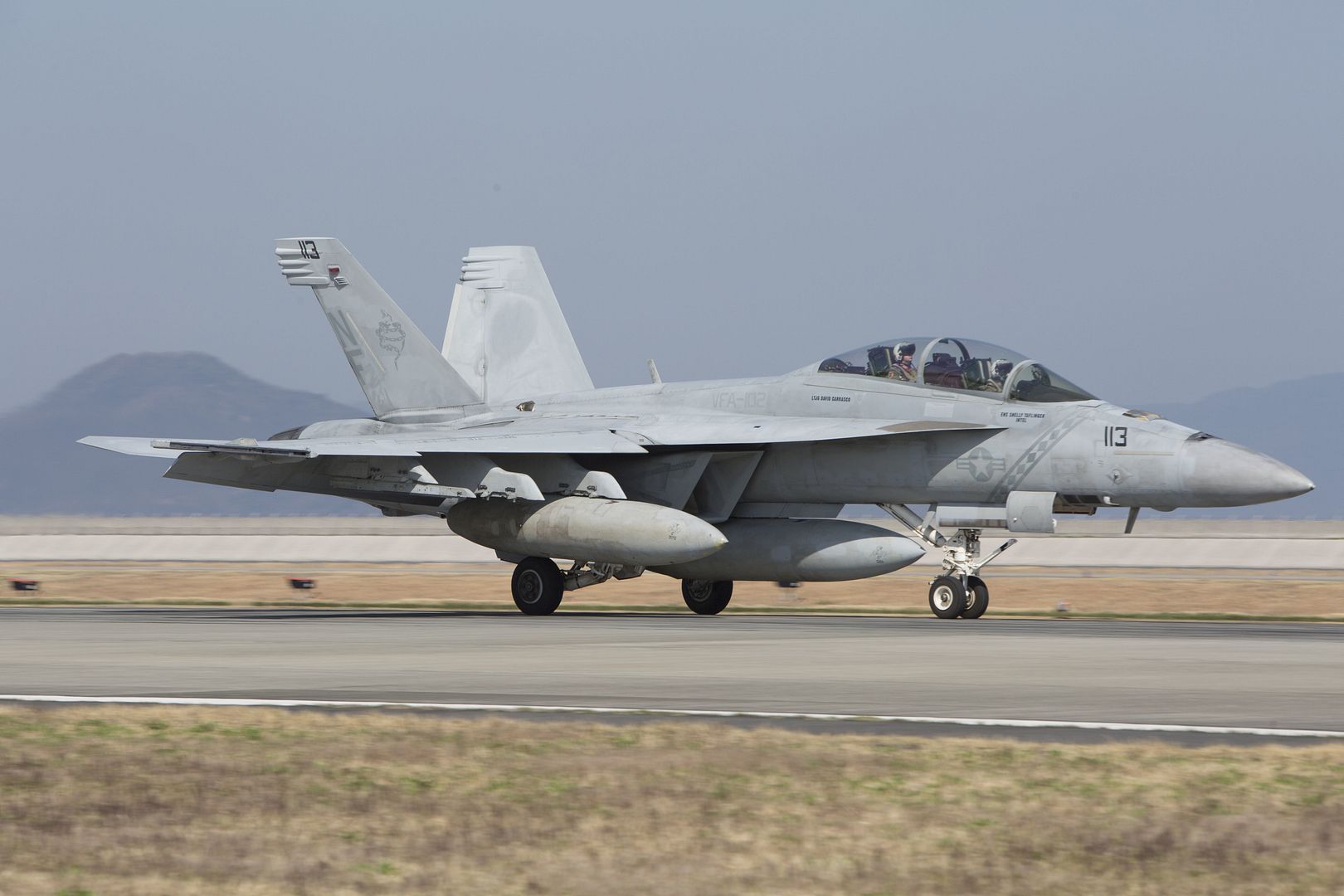
An F-35B from Marine Fighter Attack Squadron 211, 13th Marine Expeditionary Unit, is prepared and ready for take-off aboard the Wasp-class amphibious ship USS Essex (LHD 2), March 26, 2018. The Essex Amphibious Ready Group and 13th MEU fully integrated for the first time before their summer deployment. Anphibious Squadron, MEU integration training is a crucial pre-deployment exercise that allows the Navy-Marine Corps team to rapidly plan and execute complex operations from naval shipping. (U.S. Marine Corps photo by Cpl. Anthony Van Fredenberg)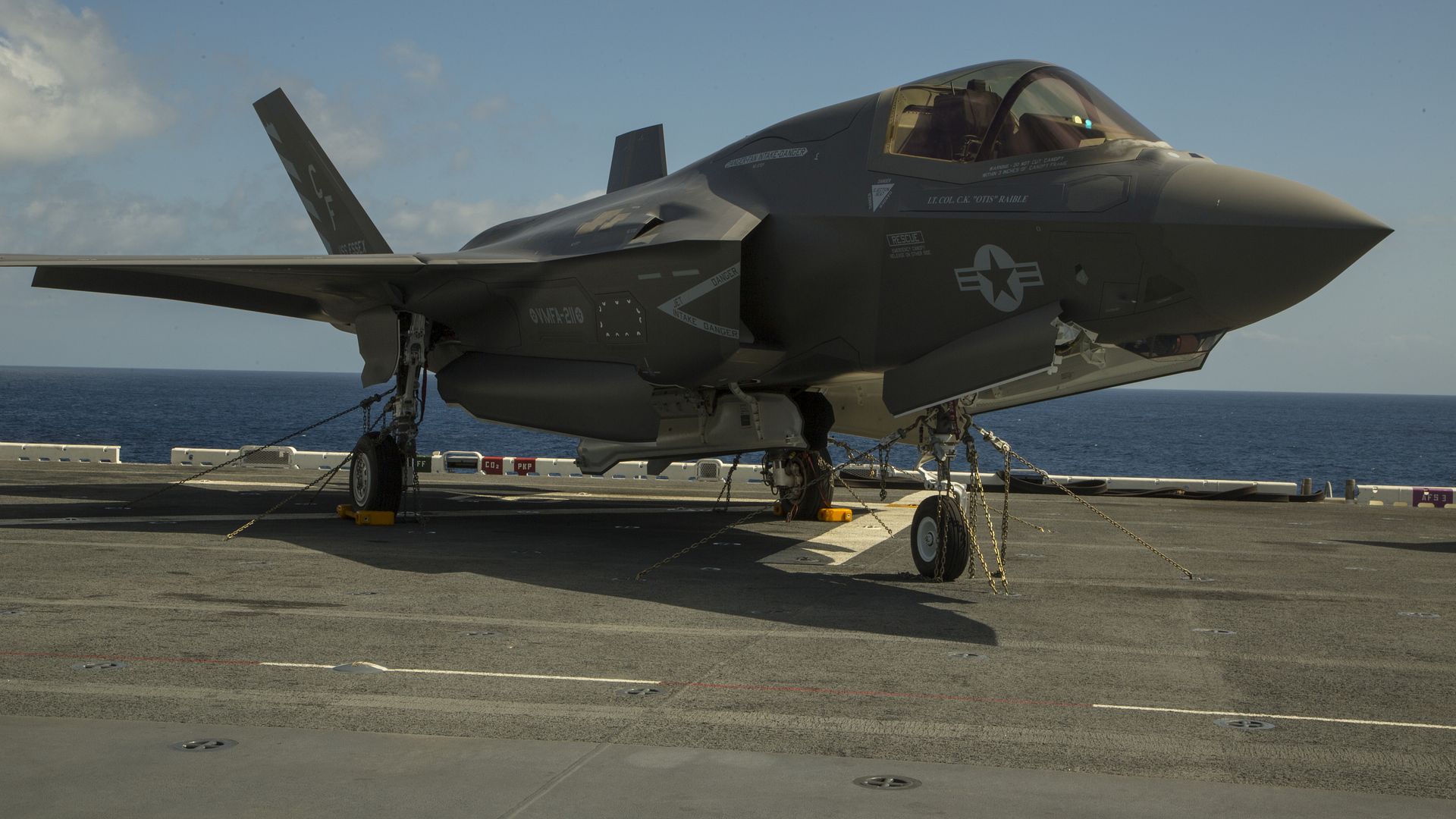
ATLANTIC OCEAN (March 26, 2018) An MH-60S Sea Hawk helicopter assigned to the "Tridents" of Helicopter Sea Combat Squadron (HSC) 9 delivers supplies to the Nimitz-class aircraft carrier USS Abraham Lincoln (CVN 72) during an underway replenishment and ammunition onload. (U.S. Navy photo by Mass Communication Specialist 3rd Class Jeff Sherman/Released)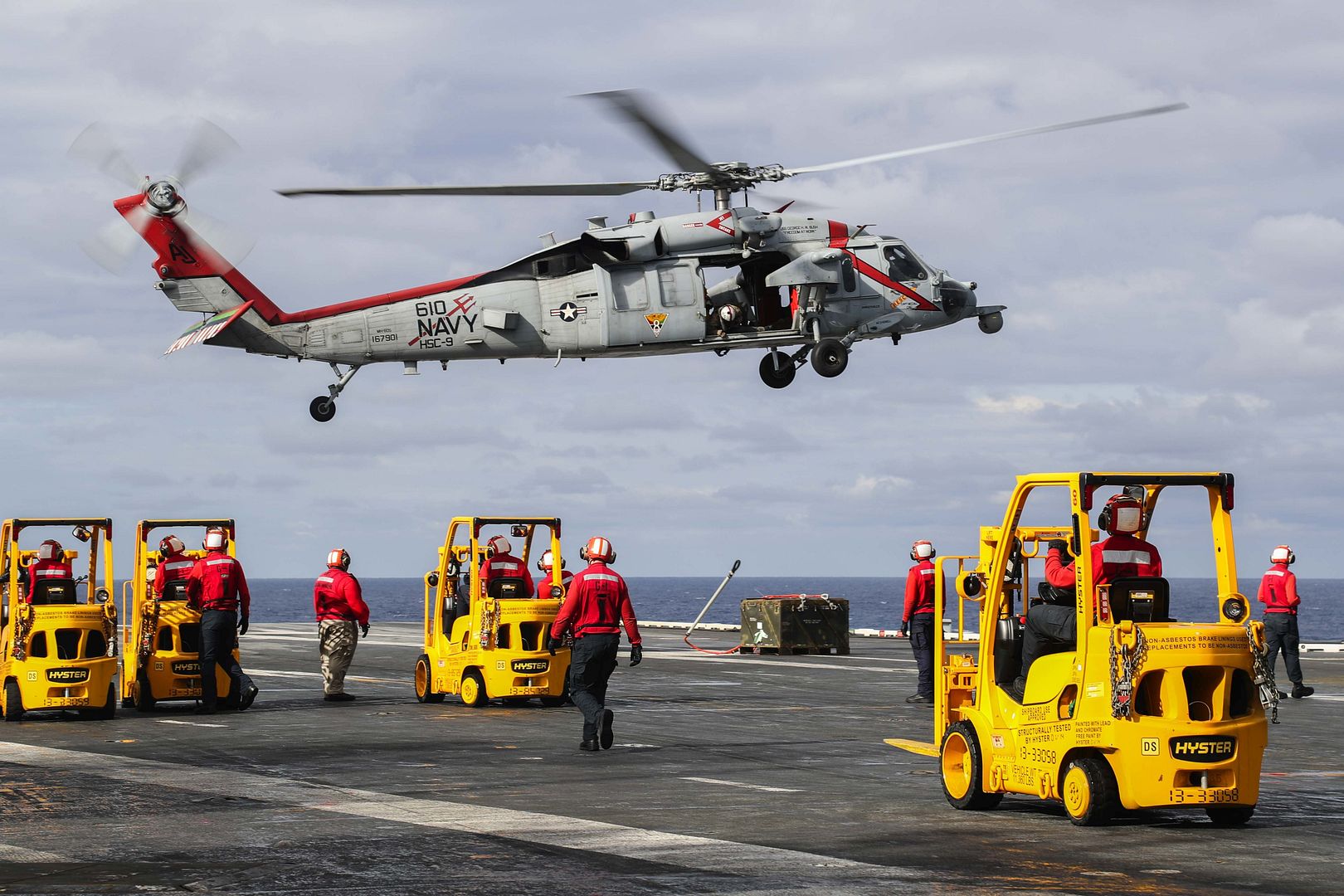
Capt. Andrew ?Dojo? Olson performs aerial maneuvers flying the F-35A Lightning II during the Wings Over South Texas air show at Naval Air Station Kingsville, Texas, March 24, 2018. The F-35 is the world?s most technologically advanced fifth-generation fighter aircraft. (U.S. Air Force photo's by Airman 1st Class Alexander Cook)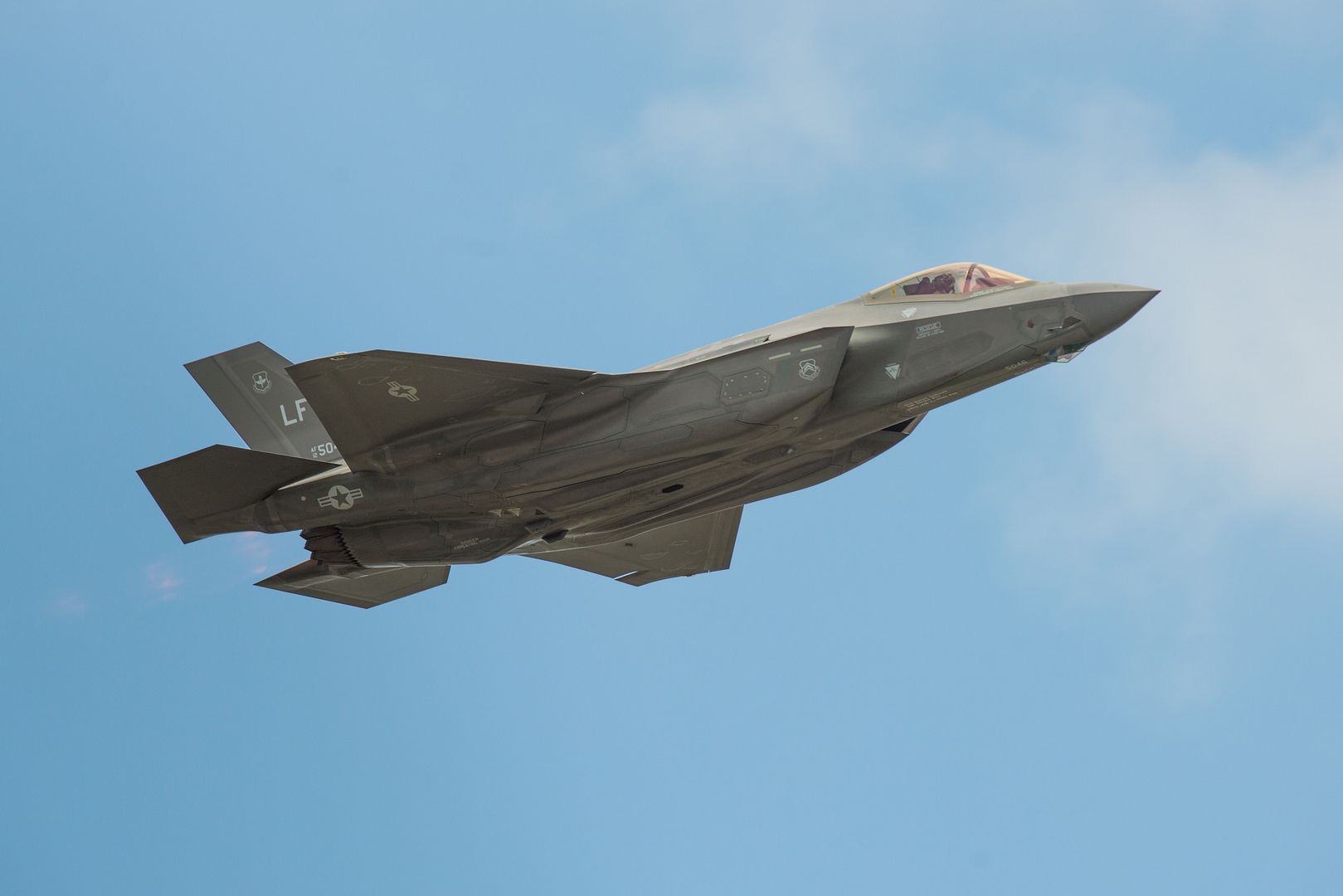
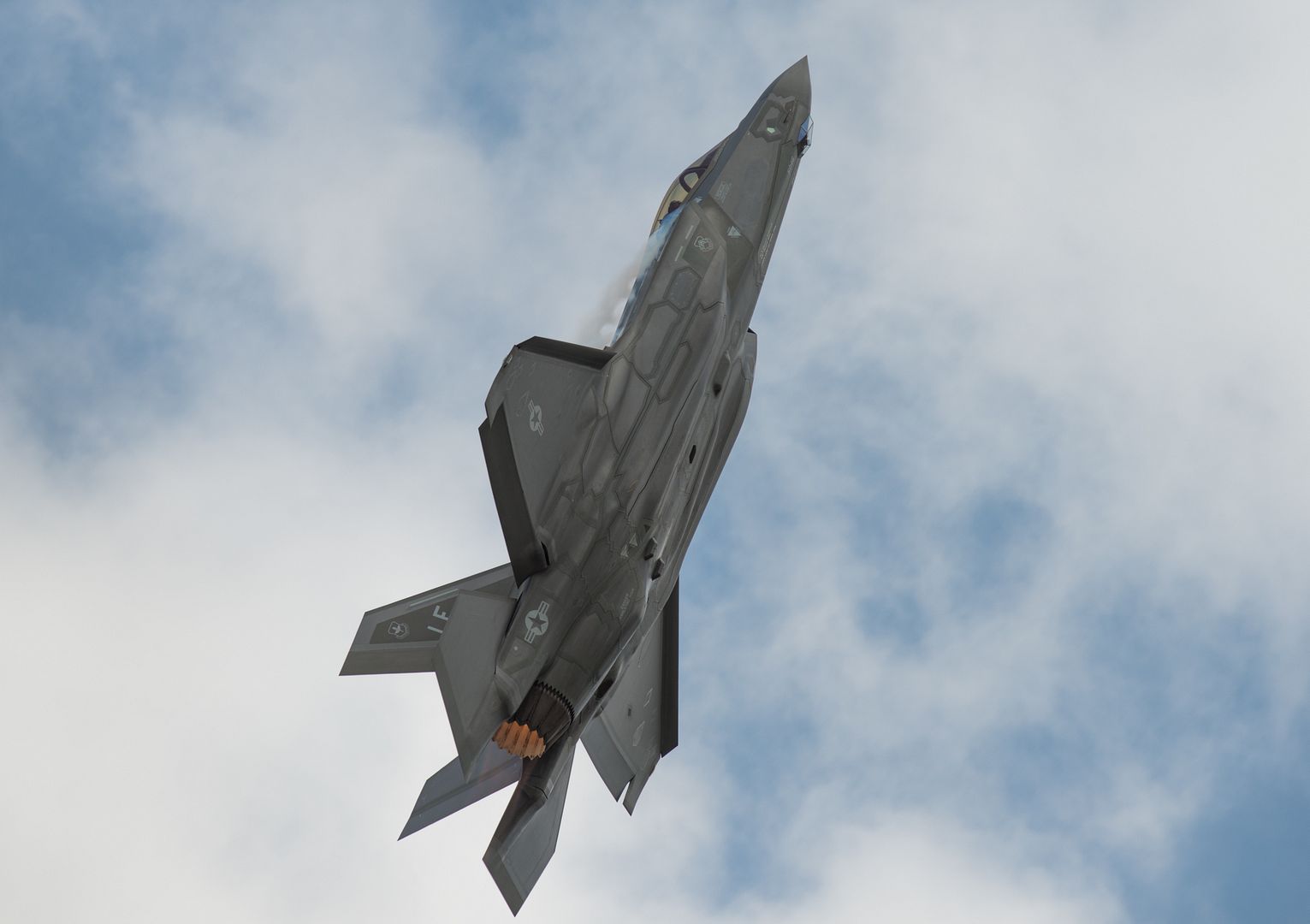
FORT WORTH, Texas, March 28, 2018 /PRNewswire/ -- Republic of Korea and U.S. government leaders celebrated the public debut or 'roll out' of the first Republic of Korea Air Force (ROKAF) F-35A Lightning II at the Lockheed Martin (NYSE: LMT) Fort Worth production facility today. The event marks a major F-35 program milestone, strengthening national defense and global partnerships.
"Today is a truly meaningful day as we celebrate the roll-out of ROKAF's first F-35A, the world's best fighter jet, which will secure the sovereign airspace of the Republic of Korea," the Republic of Korea's Minister of Defense Song Young-moo said in a previously recorded message. "The deployment of the F-35 will serve as momentum to enhance the combined operations of the ROK-U.S. Air Forces, and advance ROKAF's support capabilities for ground operations."
The ceremony was attended by more than 450 guests, including five members of the Republic of Korea National Assembly Defense Committee, as well as Suh, Choo-suk, vice minister of National Defense; and Lt. Gen. Lee, Seong-yong, vice chief of staff of the ROKAF.
"This is a major step forward for our F-35 Enterprise and our ROKAF partners as we deliver Korea's first F-35, the first of six F-35 aircraft that will be delivered this year," said Vice Adm. Mat Winter, F-35 Program Executive Officer. "The F-35A is a game-changing capability that will enable the South Korean Forces to operate side-by-side with our U.S. Forces in protecting your nation's homeland. I extend my personal congratulations to the combined government and industry team in achieving this milestone."
U.S. officials in attendance included Ellen Lord, undersecretary of defense for Acquisition and Sustainment; Heidi Grant, deputy undersecretary of the Air Force for International Affairs; Vice Adm. Mat Winter, F-35 Program Executive Officer; U.S. Sen. John Cornyn, U.S. Rep. Kay Granger, and U.S. Rep. Marc Veasey.
"We are proud to support the Republic of Korea with the unrivalled 5th Generation F-35," said Marillyn Hewson, Lockheed Martin chairman, president and CEO. "We know that it will be a symbol of strength reminding us all that when we partner together, our nations are safer, our people are more secure, and our future is brighter."
The Republic of Korea's F-35 program of record calls for 40 F-35A aircraft acquired through the U.S. government's Foreign Military Sales program and to be built at Lockheed Martin in Fort Worth, Texas. The first aircraft will be delivered to Luke Air Force Base, Arizona, where ROKAF pilots and maintainers will begin training. F-35s will arrive in country in 2019 to the Republic of Korea's main operational base at Cheongju.
The F-35 is the most advanced, survivable and connected fighter aircraft in the world. The F-35's ability to collect, analyze and share data is a powerful force multiplier enhancing all airborne, surface and ground-based assets in the battlespace and enabling men and women in uniform to execute their mission and come home safe. To date, Lockheed Martin has delivered more than 280 F-35s, trained more than 580 pilots and 5,600 maintainers, and the F-35 fleet has surpassed more than 130,000 cumulative flight hours.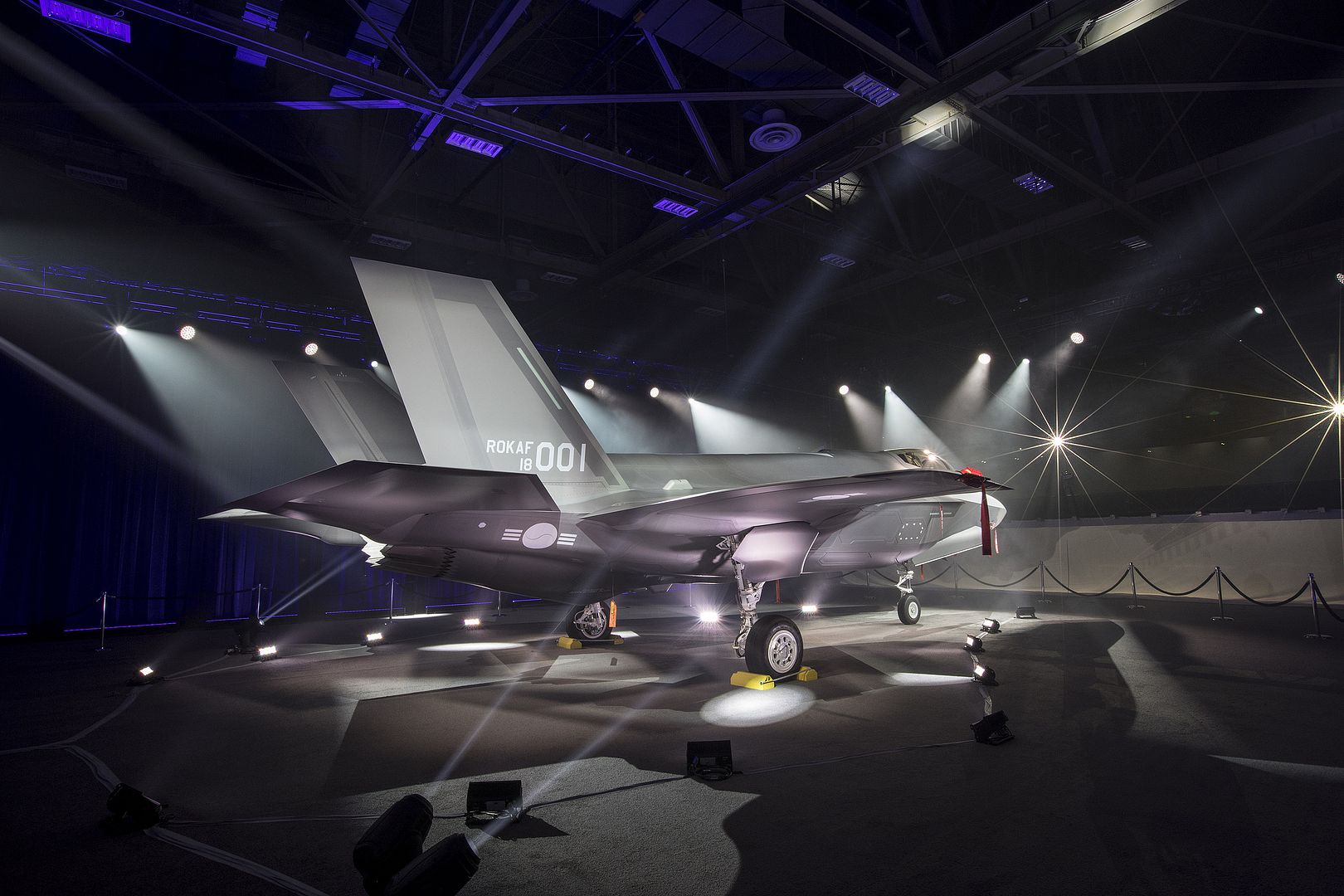
Aegean ?Airlines, the biggest airline in Greece, has signed a memorandum of understanding (MoU) with Airbus to purchase 30 A320neo Family aircraft, comprising 20 A320neos and 10 A321neos. The airline will also acquire a significant number of new A320neo family aircraft from leasing companies.
Aegean currently operates a fleet of 46 Airbus aircraft (37 A320s, 8 A321s and 1 A319).
Eftichios Vassilakis, Vice-Chairman of Aegean Airlines stated: ?Aegean?s decision to select the latest generation Airbus A320neo Family follows an intense and exhaustive evaluation to determine the best aircraft for Aegean's growth and long-term success. These aircraft will be key for us to pursue our mission of providing services of high standards for our passengers on short and medium haul services.?
?We are delighted that Aegean, an all Airbus customer, has chosen the bestselling single-aisle Family, becoming a new operator of the type. The commonality these aircraft offer along with lowest operating costs, longest range and a more spacious cabin make the A320neo Family the best choice for growing airlines such as Aegean,? said Eric Schulz, Airbus Chief Commercial Officer.
The A320neo Family incorporates the very latest technologies including new generation engines and Sharklets, which together deliver at least 15 percent fuel savings at delivery and 20 percent by 2020. With some 6,000 orders received from nearly 100 customers, the A320neo Family has captured some 60 percent share of the market.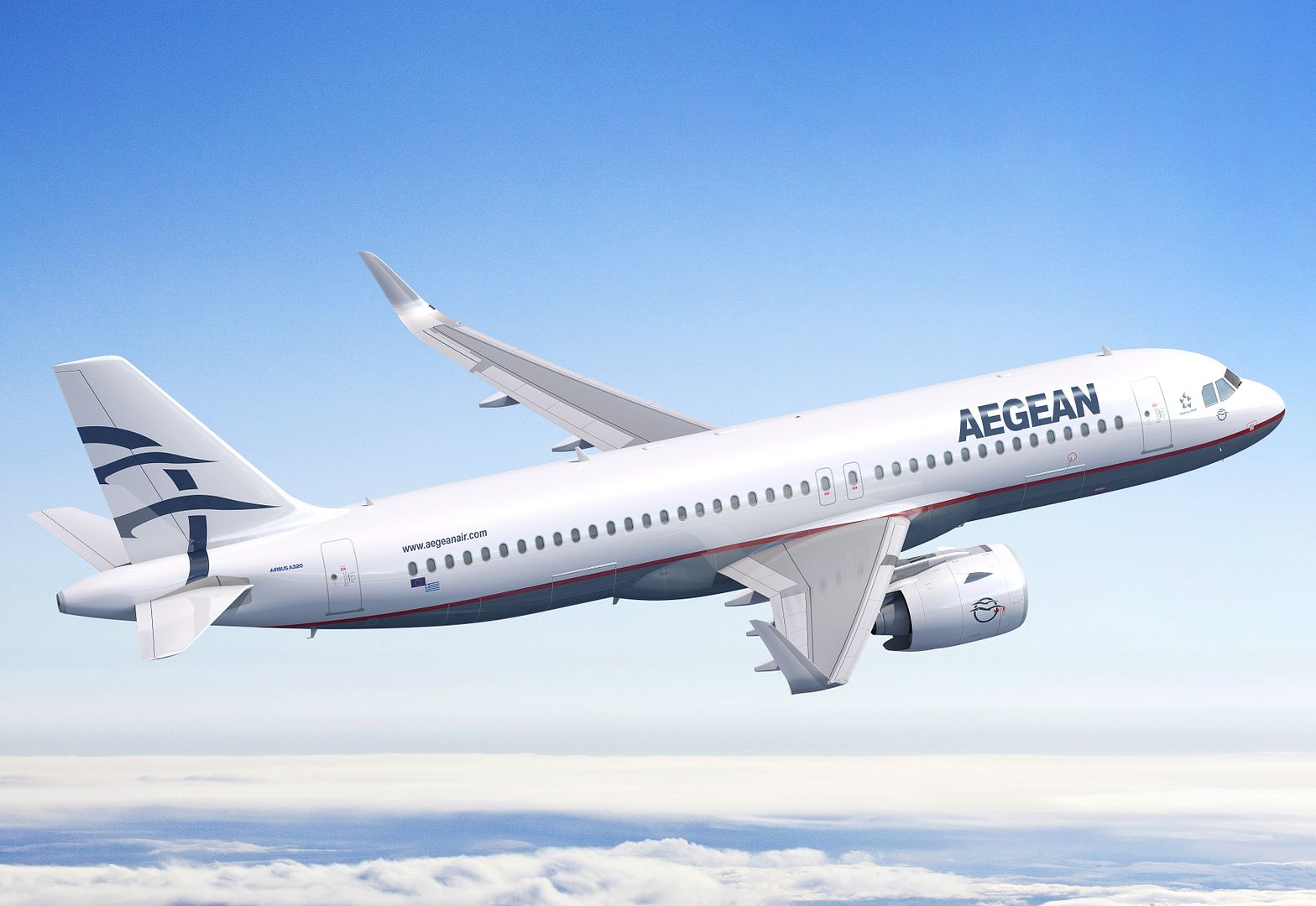
The A321 is the largest member of the A320 Family and seats between 185 and 240 passengers, depending on cabin configuration. Incorporating the latest engines, aerodynamic advances and cabin innovations, the A321neo can fly up to 4,000 nautical miles (7,400 kilometres) non-stop ? further than any other single-aisle airliner.
Leonardo has been contracted by the RAF to supply its ?BriteCloud? countermeasure to provide enhanced protection from advanced radar-guided missiles for its Tornado GR4 aircraft. The technology has now been given the go-ahead for operational service
Made in Luton, UK, BriteCloud is the only such technology in the world which has been proven to work successfully in trials. Leonardo is Europe?s leader in airborne electronic warfare, with more systems in service than any other provider
The development of BriteCloud is in line with Leonardo?s industrial plan, which sees the company making targeted investments in core technologies to support growth
Leonardo has begun deliveries of its new ?BriteCloud? decoy to the UK?s Royal Air Force for combat missions following the Ministry of Defence?s formal go-ahead for the new technology. The drinks-can-sized countermeasure, which protects fighter jets from modern radar-guided missiles, will be available for use by Tornado GR4 crews in the near future The RAF will be the first air force in the world to field this new protective technology.
The acceptance into service follows a series of tests carried out by the RAF in the United States in June 2017. These live firings saw dozens of BriteCloud decoys launched from Tornado GR4 aircraft by the RAF?s 41 Test and Evaluation Squadron against high-tech radar guidance systems. The tests produced a string of successful results which were then handed over for in-depth analysis by Ministry of Defence scientists at the UK?s Air Warfare Centre and the Defence Science and Technology Laboratory (DSTL).
Leonardo has worked since 2012 with the UK MOD to develop active expendable decoy technology, with the concept originating through a project commissioned by DSTL and jointly managed by Leonardo and the MOD?s Defence Equipment and Support (DE&S) organisation. Leonardo has subsequently invested significantly in its Luton-based electronic warfare centre to develop and manufacture the final BriteCloud product.
In late 2017 the Ministry of Defence approved the technology for operations and first deliveries of the decoys by Leonardo to the RAF will take place this month. The speed at which BriteCloud has been taken from the drawing-board into operational service is a product of Leonardo?s close partnership with the RAF?s Rapid Capabilities Office, which was established to get new technologies into the hands of warfighters more quickly.
BriteCloud packs a sophisticated electronic radar jamming system into a package just a few inches long. The decoy can fit into a fighter aircraft?s standard chaff and flare dispenser and can be ejected at the push of a button if the aircraft is locked onto by a modern radar guided missile. Upon launch, BriteCloud instantly powers up and its automatic jammer produces a ?ghost? signal to defeat an enemy?s radar, making it straightforward to use and able to protect its host aircraft even in situations where traditional chaff and flare countermeasures would be ineffective. The technology is generically called an ?Active Expendable Decoy? (EAD); ?active? because of the electronic jammer and ?expendable? because the decoy is fired away from the combat jet to create a large ?miss distance? for an incoming missile.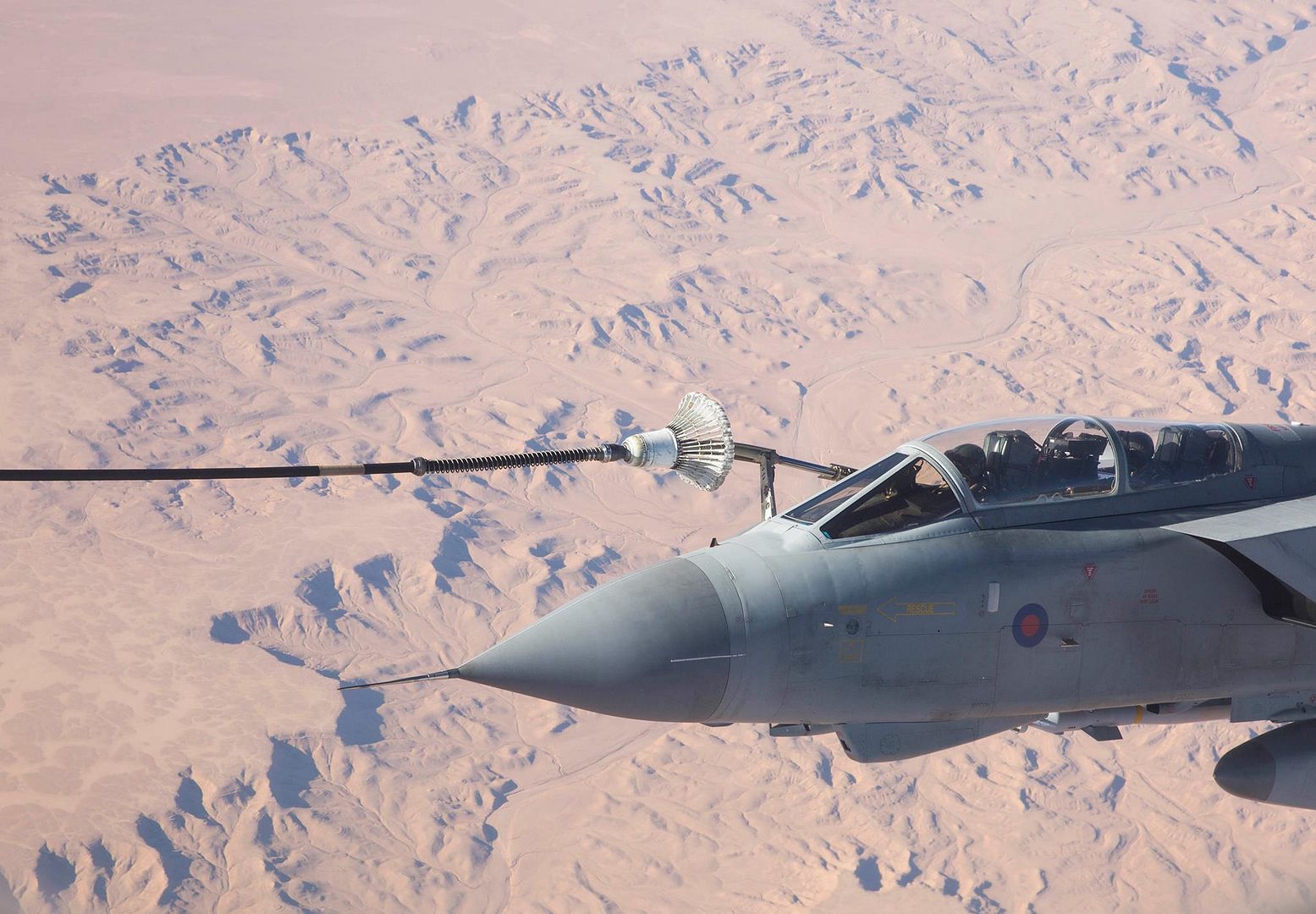
Post a reply
- Go to Next topic
- Go to Welcome
- Go to Introduce Yourself
- Go to General Discussion
- Go to Screenshots, Images and Videos
- Go to Off topic
- Go to Works in Progress
- Go to Skinning Tips / Tutorials
- Go to Skin Requests
- Go to IJAAF Library
- Go to Luftwaffe Library
- Go to RAF Library
- Go to USAAF / USN Library
- Go to Misc Library
- Go to The Ops Room
- Go to Made in Germany
- Go to Campaigns and Missions
- Go to Works in Progress
- Go to Juri's Air-Raid Shelter
- Go to Campaigns and Missions
- Go to Works in Progress
- Go to Skinpacks
- Go to External Projects Discussion
- Go to Books & Resources
